Printable Version of Topic
Click here to view this topic in its original format
914World.com _ 914World Garage _ "elluva a hole. Still welding after all these years...
Posted by: worn Feb 24 2021, 10:40 AM
See last post. Welding and rubber sealant removal coming to the end. Thanks.
Haven't been very active for a couple of years. Partly because the 911 has taken up my time. So I am finally getting around to rust repair on my '76. The floors have rusted through so I have been working on the layer cake that makes up the right side longitudinal, focused on the hell region. The rust has affected both the inner pieces as well as the outer ones, and it is concentrated where all of the pieces come together.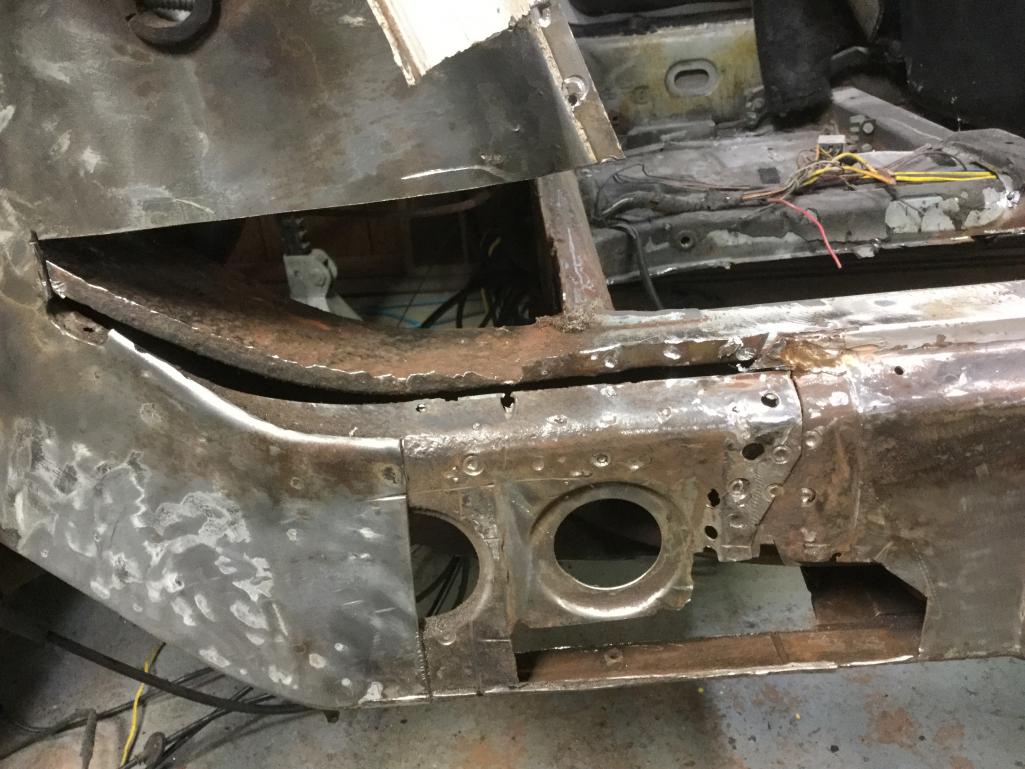
I have cut away the pitted and perforated metal. My question is as follows. I am addressing the problem by restoring each piece to produce a longitudinal as it came from the factory. For example.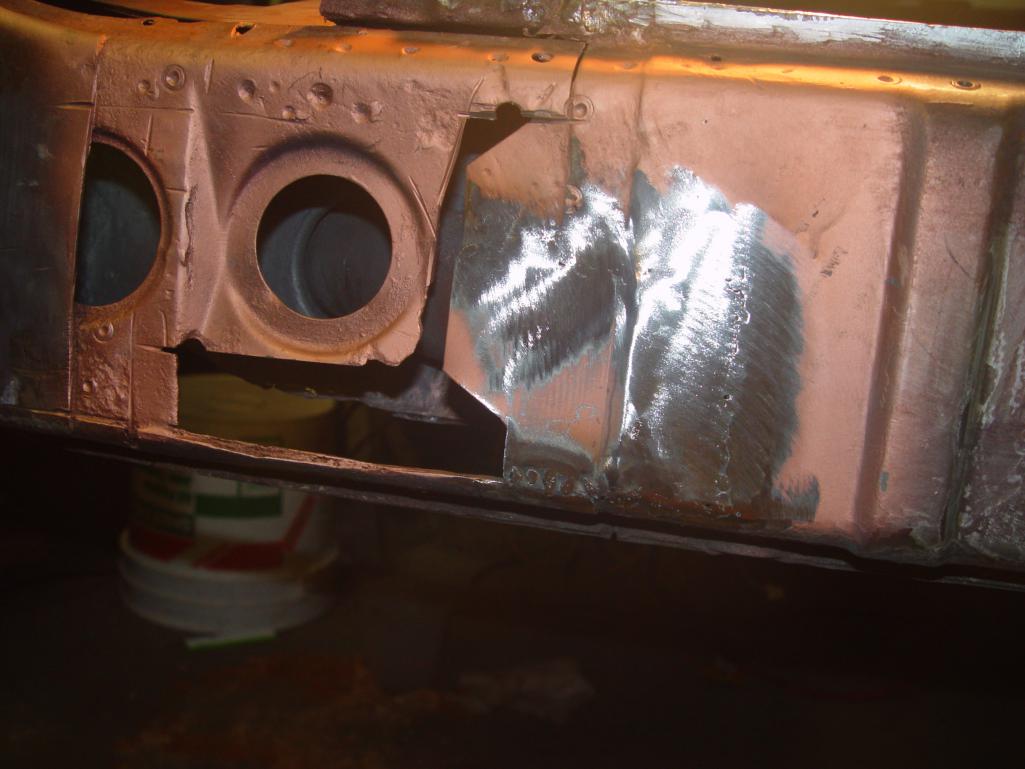
In this case I made a piece to restore the tab of the forward inner layer of the outside long.
Then I added a piece to restore the rear inner layer piece the overlaps: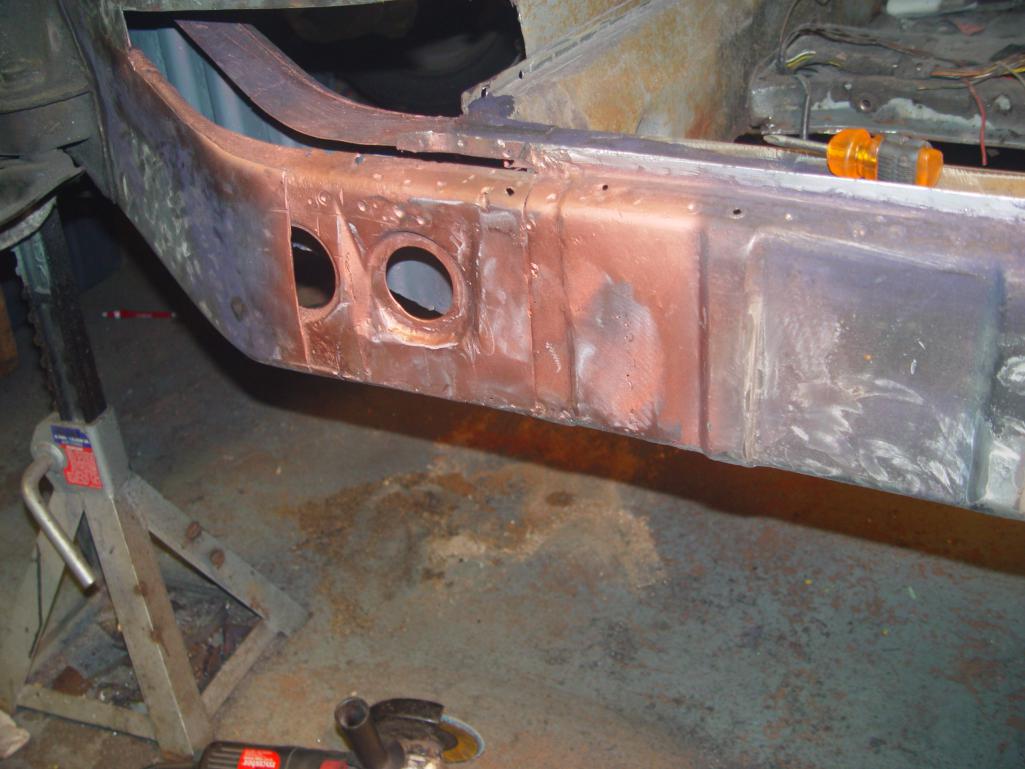
Then I have made a patch for the outer wheel house piece to produce the outer layer. The patches are butt welded to good metal on the original pieces and shaped to reproduce the originals.
Here is the question. Is this really best practice? For example, instead of making a bunch of pieces that join together to match the original I could use a single sheet that replaces them all at once. With fewer butt welds and seams. My method so far has been heavily influenced by threads from people I admire here on the world. You folks make nice welds.
Posted by: Root_Werks Feb 25 2021, 10:51 AM
That is no light project! I have digging into mine to do and hoping it's not bad. You've already done most of the hard work, remove and prep for new metal. Keep the pics coming!
Posted by: SirAndy Feb 25 2021, 10:57 AM
Personally, i like to weld as little as possible. No matter how much care you take to prime the new metal, the welds will leave exposed spots that are starting points for new rust.
RD has a lot of replacement metal for your needs:
https://www.restoration-design.com/
Posted by: mbseto Feb 26 2021, 01:58 PM
In my experience, fitting a patch takes about the same amount of time regardless of the size of the patch. So three small patches might take three times as long as one big patch that covers the whole area.
I also like the idea of minimizing welds, which is what you get from a larger patch. And in these layered areas, avoiding having a weld in one layer lined up with a weld in another layer. Of course I picked up all this from the more experienced guys on this forum.
Posted by: ssuperflyoldguy Feb 26 2021, 03:41 PM
Use Cold Galvi weld thru primer instead of red - red burns off more than the Galvi when welding close by
Posted by: Root_Werks Feb 26 2021, 05:15 PM
In my experience, fitting a patch takes about the same amount of time regardless of the size of the patch. So three small patches might take three times as long as one big patch that covers the whole area.
I also like the idea of minimizing welds, which is what you get from a larger patch. And in these layered areas, avoiding having a weld in one layer lined up with a weld in another layer. Of course I picked up all this from the more experienced guys on this forum.
I've learned from others over the years replacing larger pre-made sections can be less work than patching a number of smaller areas. Plus, it just looks cleaner in the end.
Grinding.....grinding, ugh.
Posted by: Superhawk996 Feb 26 2021, 06:00 PM
Personally, i like to weld as little as possible. No matter how much care you take to prime the new metal, the welds will leave exposed spots that are starting points for new rust.
RD has a lot of replacement metal for your needs:
https://www.restoration-design.com/
FWIW -- RD panels are Galvaneal. The Zinc that is annealed into the top surface of the panel sheet metal will actually serve as a sacrificial cathode for nearby sheet metal and welds. Not perfect, and protection diminishes with distance from the Galvaneal panel, but, the Zinc in Galvaneal goes a long way toward holding off surface corrosion at the weld sites.
Posted by: worn Feb 26 2021, 08:51 PM
In my experience, fitting a patch takes about the same amount of time regardless of the size of the patch. So three small patches might take three times as long as one big patch that covers the whole area.
I also like the idea of minimizing welds, which is what you get from a larger patch. And in these layered areas, avoiding having a weld in one layer lined up with a weld in another layer. Of course I picked up all this from the more experienced guys on this forum.
I've learned from others over the years replacing larger pre-made sections can be less work than patching a number of smaller areas. Plus, it just looks cleaner in the end.
Grinding.....grinding, ugh.
Thanks to all who replied. The way the rust worm turns it seems that all of the rust ends up at the overlap pieces that made up the original. Both inside and outside longitudinal pieces were in turn made up of inner and outer sections. The spot welds produce a wonderfully strong unit. In my case each and every piece has the last couple of inches rusted off. That is why I have started down the road of restoring each end one at a time.
Just spent a day in a frozen garage trying to avoid setting my car harts on fire. Making progress. My big problem now is dealing with the moat of metal on either side of the weld beam. Pictures tomorrow but the basic problem comes when trying to grind the welds flat. Bright middle, with dark edges, and then bright surroundings. The area around the weld has shrunk. Any solutions?
Thanks folks!
Posted by: worn Feb 27 2021, 01:04 PM
Personally, i like to weld as little as possible. No matter how much care you take to prime the new metal, the welds will leave exposed spots that are starting points for new rust.
RD has a lot of replacement metal for your needs:
https://www.restoration-design.com/
FWIW -- RD panels are Galvaneal. The Zinc that is annealed into the top surface of the panel sheet metal will actually serve as a sacrificial cathode for nearby sheet metal and welds. Not perfect, and protection diminishes with distance from the Galvaneal panel, but, the Zinc in Galvaneal goes a long way toward holding off surface corrosion at the weld sites.
I have several orders in from RD. One problem is that the rust generally is affecting ends of panels such that I would have to replace 90-95% good metal to get rid of the 5% that is really rotten.
I think it was BBrock who suggested the Cu UPol primer. And it does seem to weld nicer than the Zn. I have sets of wire brushes welded to 3 foot quarter in rods to clean the old out of the longs. Cut where there are pits, use a rust converter to turn the rust to ferrite covered with vinyl sealler. That gets a coat of marine epoxy and that gets a coat of 3M cavity treatment wax. But between the layers there are places of clean metal plug welded to clean metal, and that is what is looking like copper.
The shop is pretty comfortable: about 50 degrees F when it warms up, but I still have problems with fogging the welding helmet. And I have an extra reading glass lens to fog. So, have to route the warm air away:
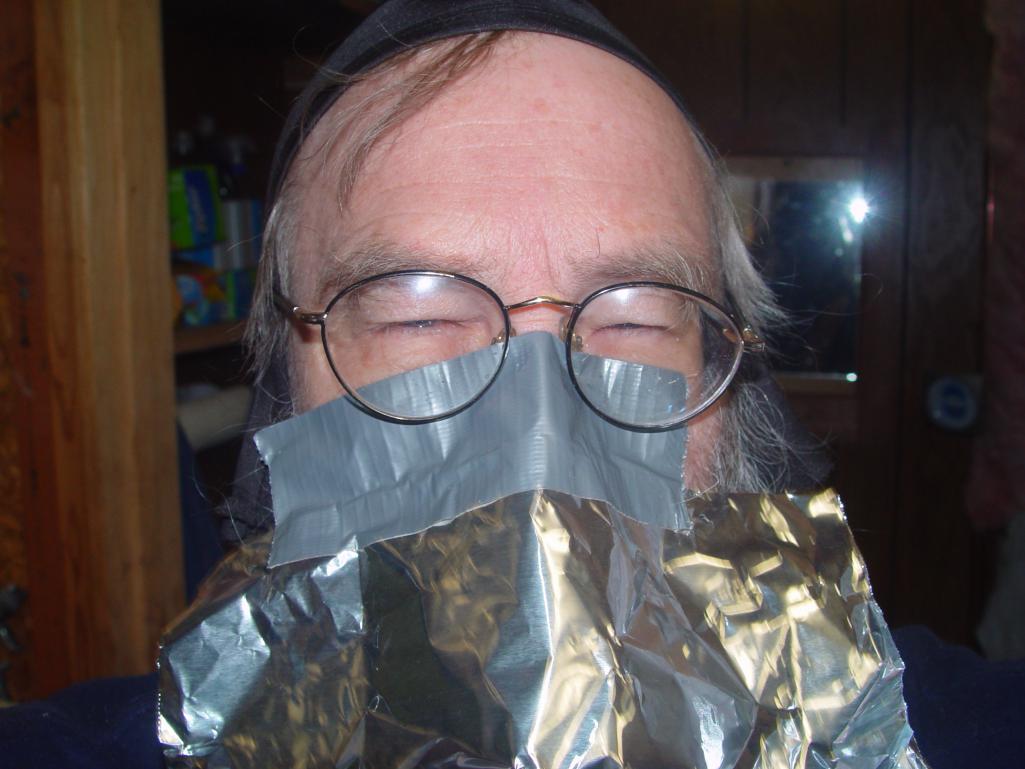
The wheel house sheet metal right behind the battery was perforated, and the RD pressing doesn't seem to reach that far up.
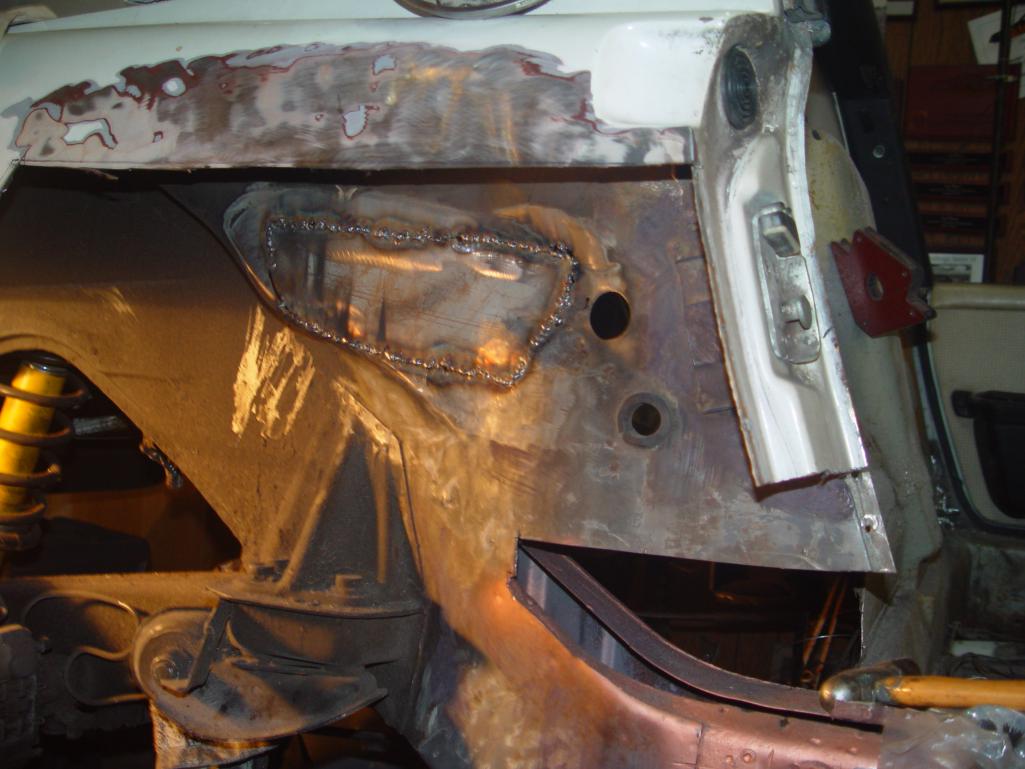
Here is the beginning pretty crude repair, but I will be able to get it from the other side. You can also see the reinforcing piece that lies inside the inner long. That is covered with epoxy. The wax material from three M will be sprayed in as the last step to reduce fire.
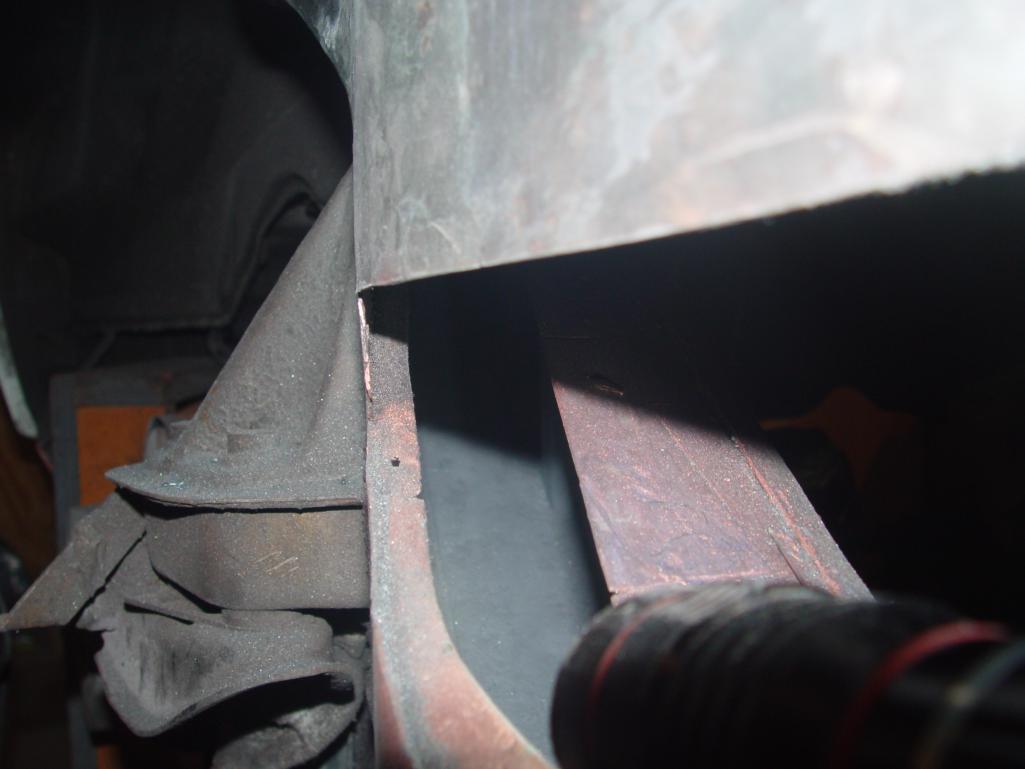
A bit better. The worst part is the slight furrow on either side of the weld in the HAZ. Any suggestions? It is a new to me Hobart 135. I also have a Lincoln I can use, and a TIG.
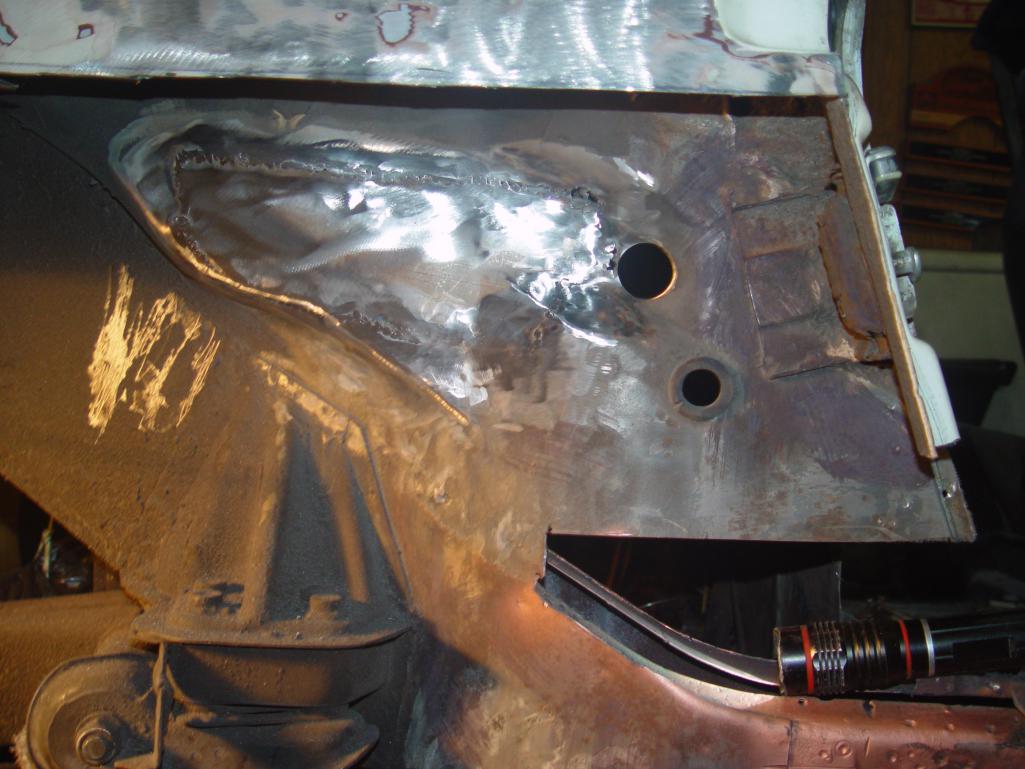
Posted by: worn Feb 27 2021, 01:25 PM
FWIW -- RD panels are Galvaneal. The Zinc that is annealed into the top surface of the panel sheet metal will actually serve as a sacrificial cathode for nearby sheet metal and welds. Not perfect, and protection diminishes with distance from the Galvaneal panel, but, the Zinc in Galvaneal goes a long way toward holding off surface corrosion at the weld sites.
My childhood summers were spent in a 34 foot wooden boat anywheres from Puget Sound to Uclulet. Dad had zincs on the hull tied into everything metal. I figure I oughta just trail anodes from the bumper. This time of year you can encounter either blowing clouds of snow, or salt up here in the north. Turns everything white either way.
Of course the worst parts are inside. The inner long has a U-section on its side made out of heavier metal with corrugation. The lower part has rusted, but the upper two planes are solid. Made a piece out of 14 gauge for that. Welding upside down on my back adds to the fun. Thankfully Harbor Freight has improved their welding blankets. One spark ate through the Carhart, the sweatshirt, the other sweatshirt, the T-shirt, and then rolled along my side to end up underneath me.
On the upside we have this.
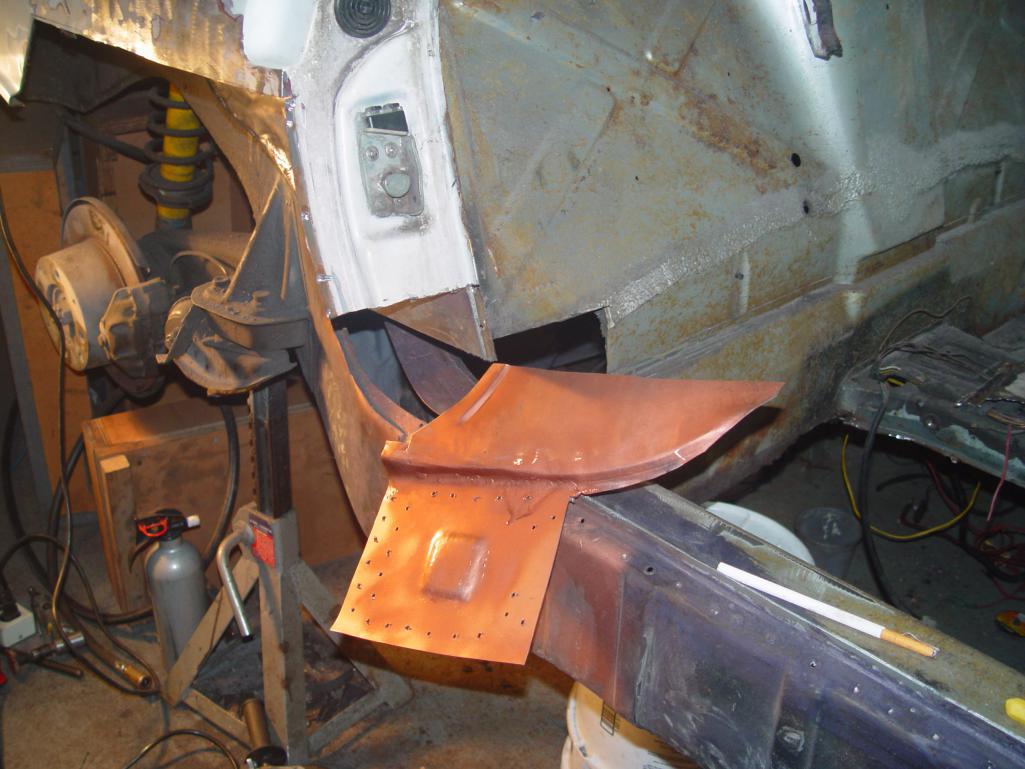
and I quit yesterday with it partway put in.
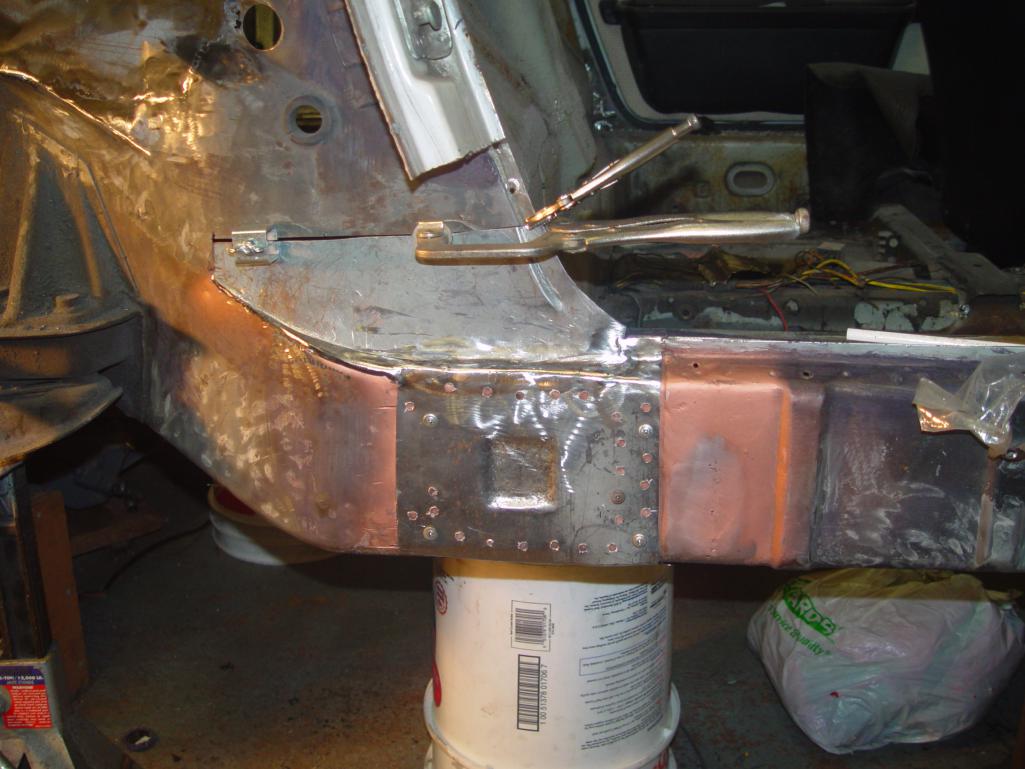
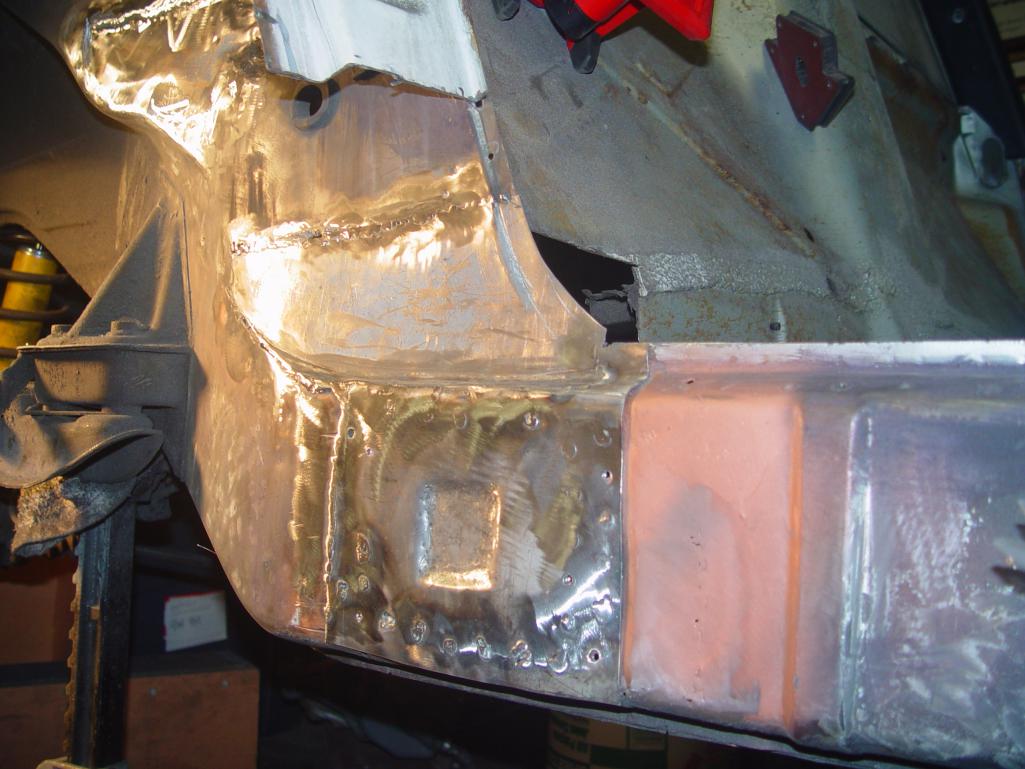
I could have approached things by replacing both inside and outside longs, along with their internal reinforcements, but that would mean removing both inner and outer suspension consoles. I did remove the right side motor mount, but that alignment is a good deal more forgiving in my mind than the suspension parts.
As seen in some photos the top of the inner longitudinal member was cut out because of pitting. There are reinforcing pieces inside, and fortunately they were shielded on top by the outermost layer.
Thanks for any and all suggestions. I have the RD rear floor, the crossmember and the firewalls yet to install as well as more welding on this onion. It is amazing how monocoque layering creates a sturdy shell
Posted by: jaredmcginness Feb 28 2021, 07:45 AM
Your repair is great! Nice work so far. Keep updating us.
Lots of great advice in here. My only advice, I covered this exact same repair. I used a few new panels (outer long, floors) the rest I made myself.
It really went by much faster than I anticipated. I enjoyed it.
Posted by: worn Mar 4 2021, 11:29 AM
Made some progress this week. Got the wheel house panel in completely. Am experimenting with new techniques to reduce undercutting in the surrounding metal.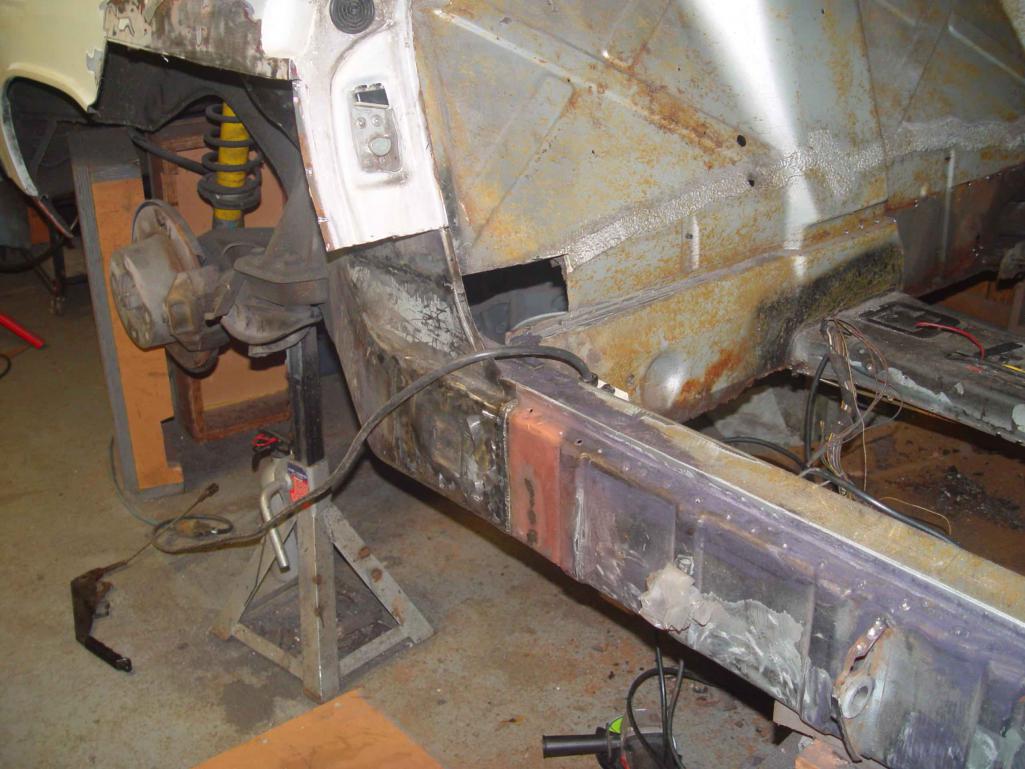
The inner long has a heavy reinforcement section inside. Restoration designs makes it, but it rusted badly only along the lower flange where it flattens out to collect water and sulfuric acid and what ever else causes rust Here it is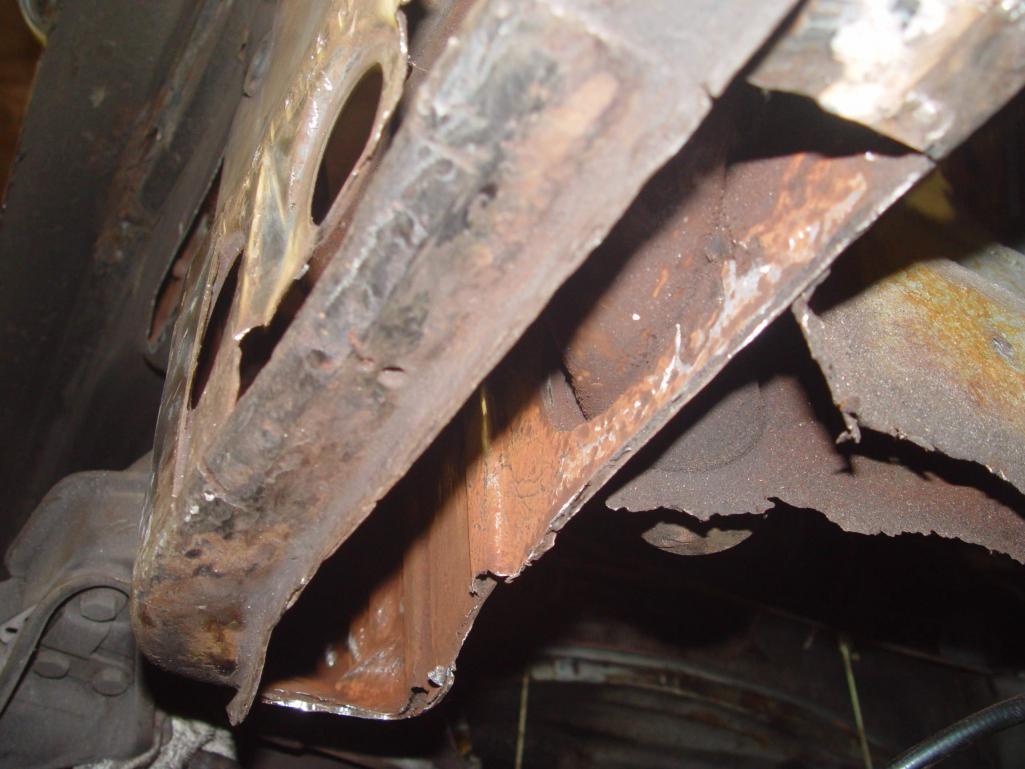
I fabricated a repair piece from 14 gauge steel because this piece was thicker than other body parts. Did my best to add the corrugations. This is all welding on my back covered with a welding blanket. Hardly enough room to get my helmet angled to see the weld. But persistence pays off.
I did more welding after this but since the longitudinal provides an out layer I left some ugliness be rather than grind everything off.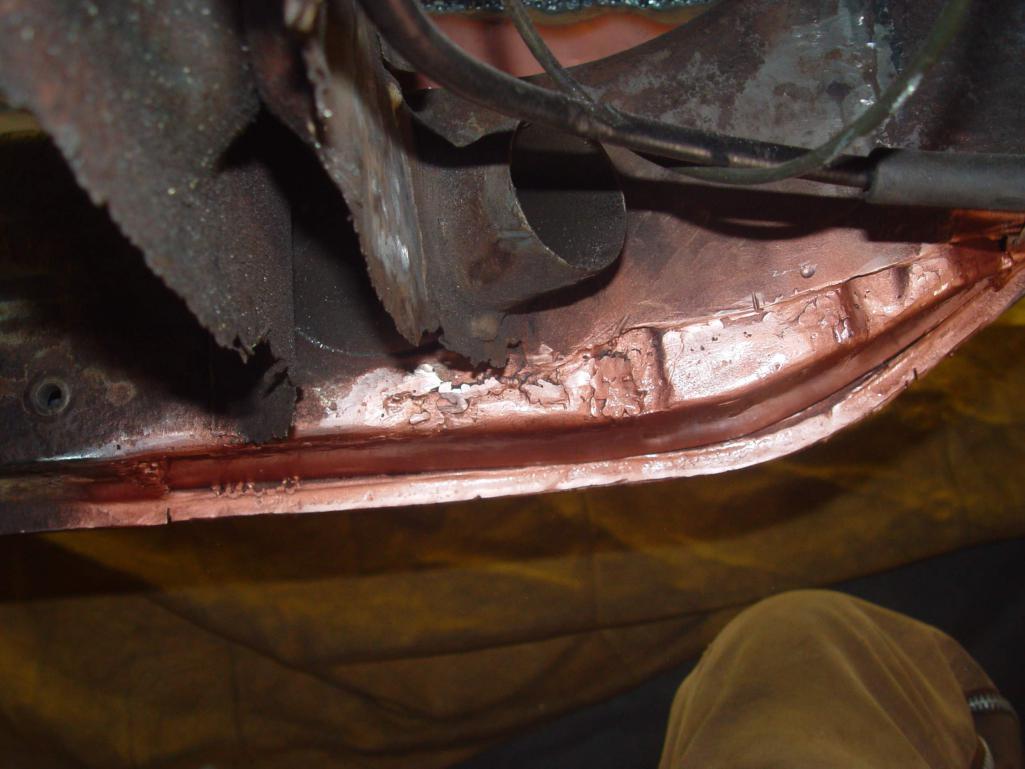
Then of course there are floors to deal with.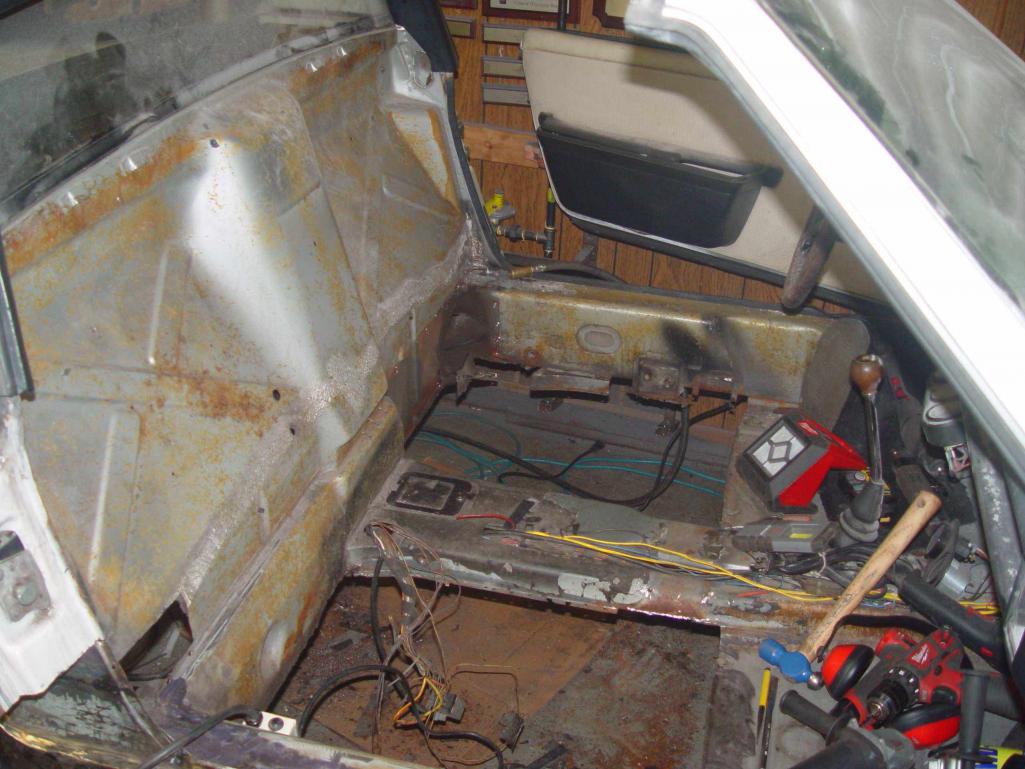
Posted by: worn Mar 4 2021, 11:50 AM
The floor carries many items for use on the new floor. I like the idea of reproducing the holes used during manufacture, and I need to pull out the plugs.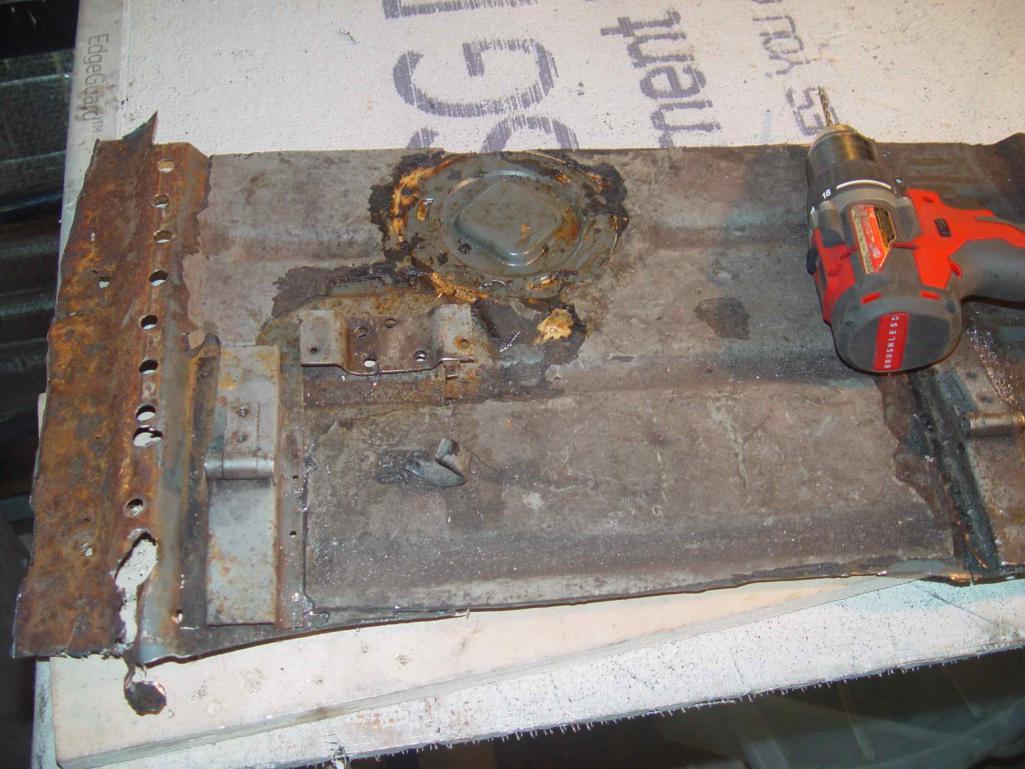
and make new holes for them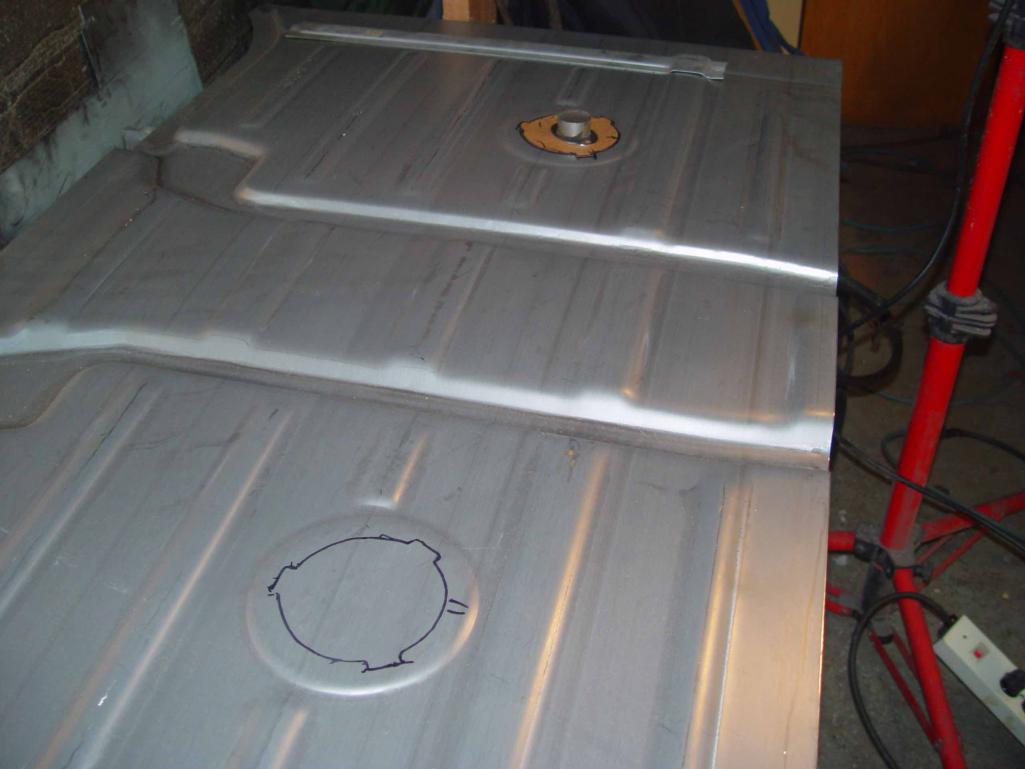
In order to remember where everything goes I have to save the pieces for awhile. Never throw them out till you have finished the project.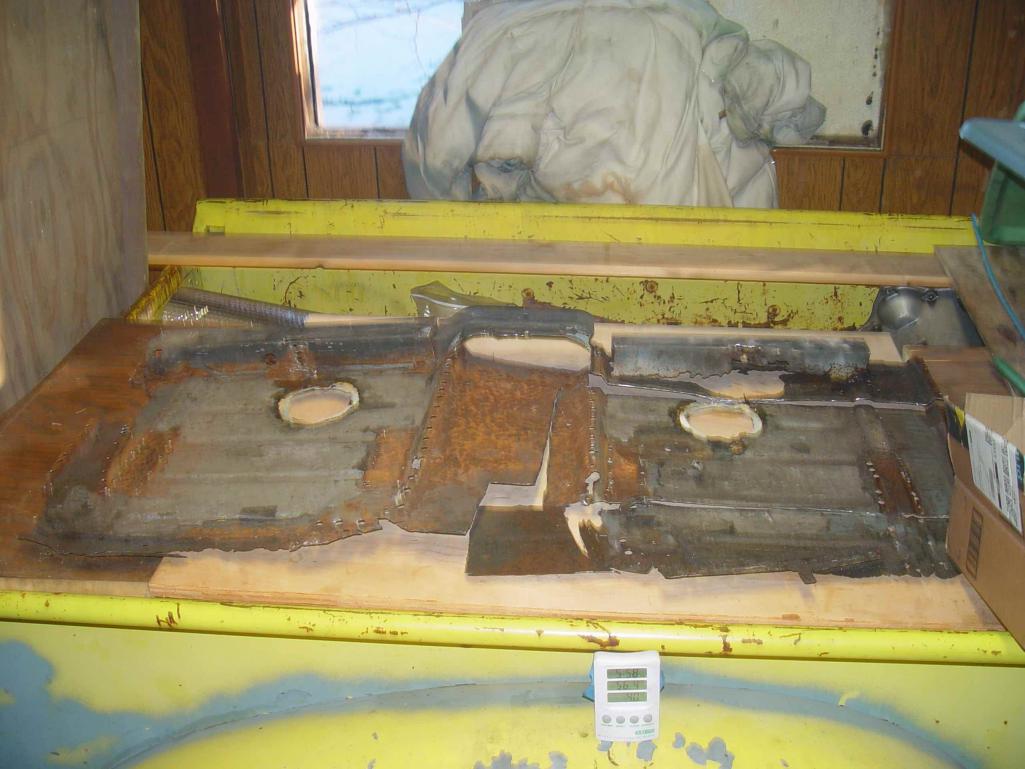
The upside down welding involved solid metal that has been hit with rust converter to deal with surface rust followed by epoxy primer. This is inside the longitudinal. The best I can do is scour it with a wire brush welded on the end of a long shaft and spun with a drill. It won't readily return to its evil oxidizing ways and I will make sure to cover the parts burned off in welding by spraying with a narrow tube. That is what it is. Which means that I am welding my patches onto metal that isn't quite clean. And of course, that isn't pleasant even if the results are OK. You get flares and spatter. I was covered by a welding blanket, but I didn't put a welding sleeve on my left hand and my elbow caught fire. How do I know? I saw smoke rising from the left.
Posted by: worn Mar 4 2021, 12:05 PM
After spending a few hours on my back on the frozen floor (thank you Carhart) I decided to switch to the new floor. Welded on my seat reinforcements. Suddenly I was the god of welding. Clean galvaneal!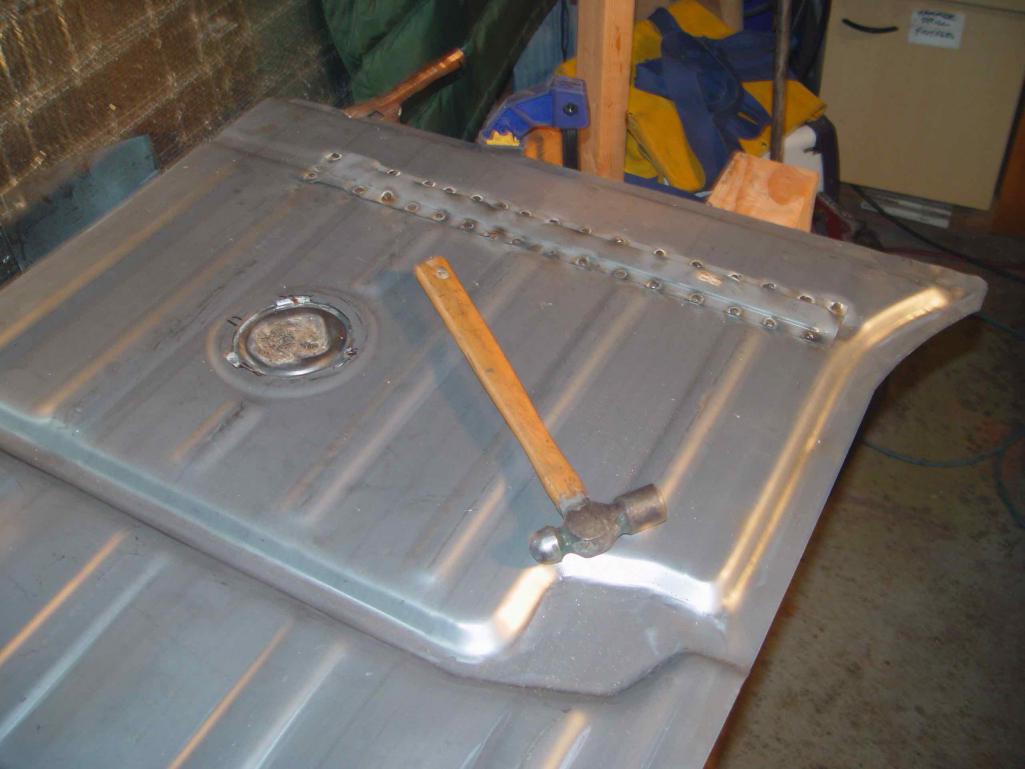
And for those who think I have been slighting Restoration Design by making patch panels I have this to say.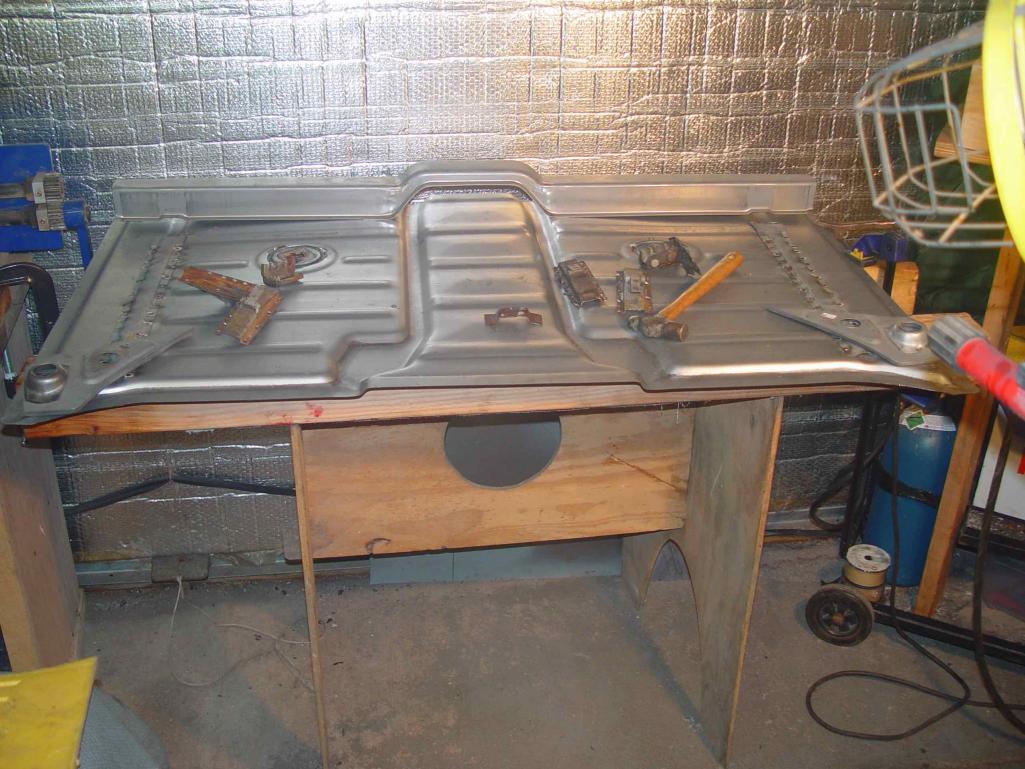
This is about half of the items from my first order. My second order came yesterday and today I ordered more new stuff from RD. They are really nice to work with. While I am at it I want to say nice words about Millennium Technologies. I am having a 911 cylinder over bored and replated, and they have been very nice to work with.
Posted by: worn Mar 10 2021, 11:27 AM
I have been measuring the door gap after every patch. Found that it was widening and installed the typical brace with a turnbuckle.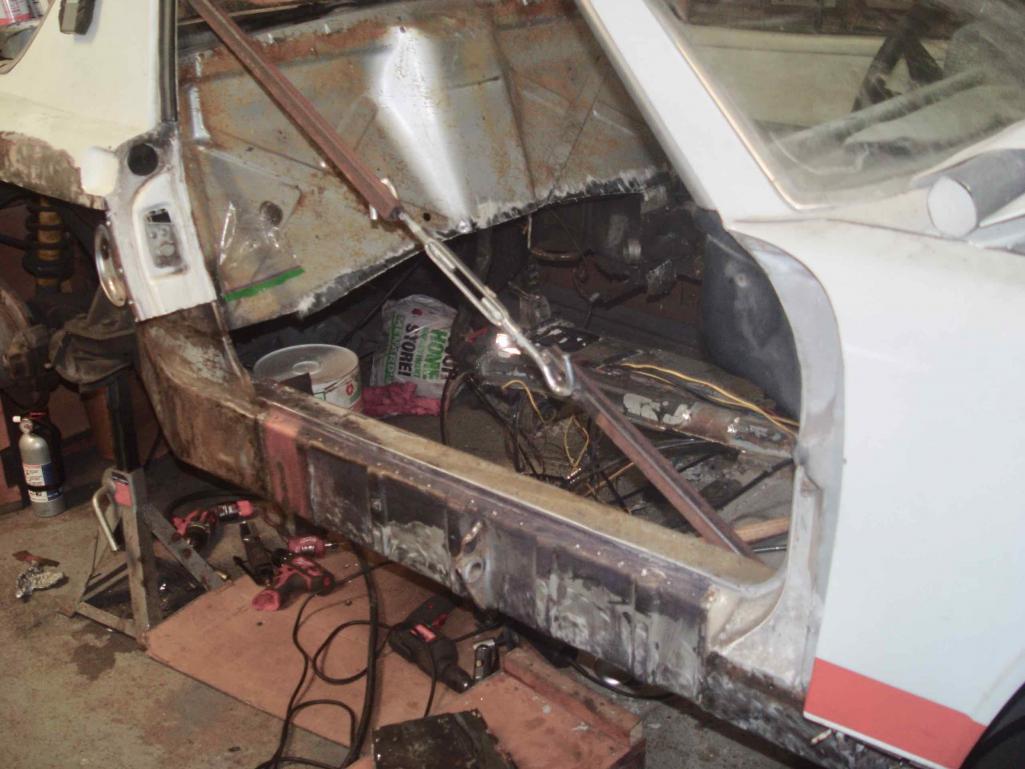
Given the obvious strength of the longitudinal pieces I was surprised that I could move the door gap open and shut by twisting the turnbuckle. I should have known but was surprised to see this: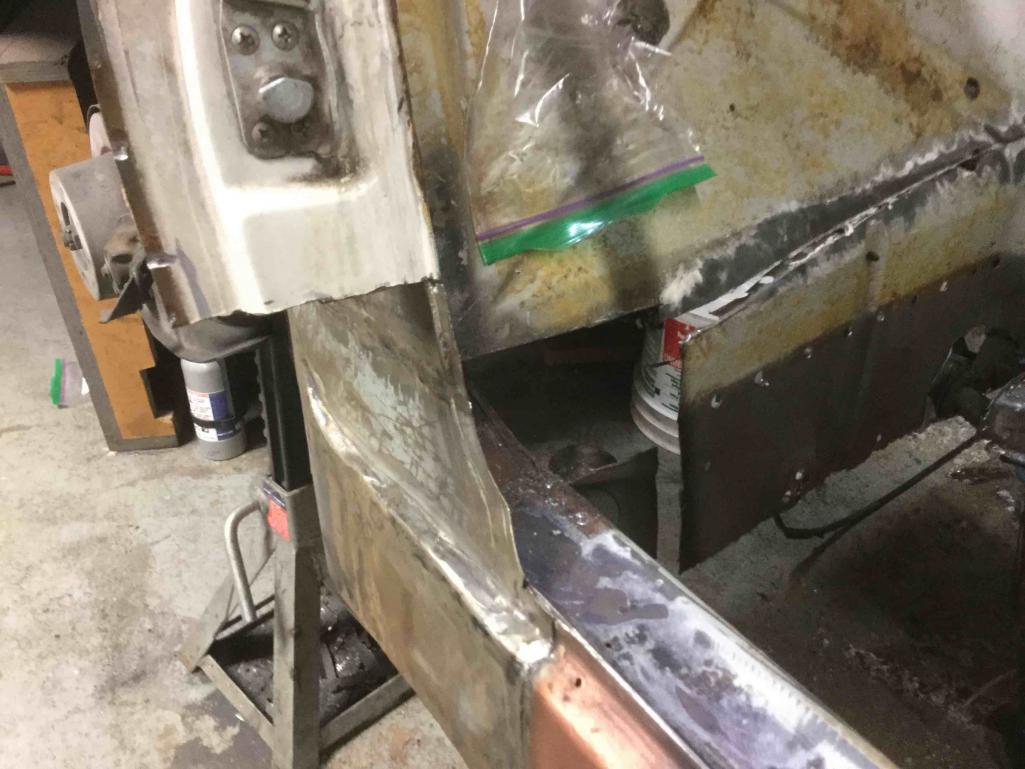
Note how the patch panel is flexing. All of the butressing pieces have been removed. The door latch pillar, the outer fender and the inner and outer firewall pieces normally come together so this thin piece of metal can prevent flexing of the B-pillar and roll bar. Nice to know.
The inner reinforcement of the longitudinal has been patched and covered with a patch for the covering inner long piece. All of the layers are also stitched together with plug welds. Rust converter sealer followed by epoxy primer and I am ready to weld in a patch for the top of the inner long. Just under the battery tray. The inner reinforcement was in great shape here, probably shielded by the outer shell.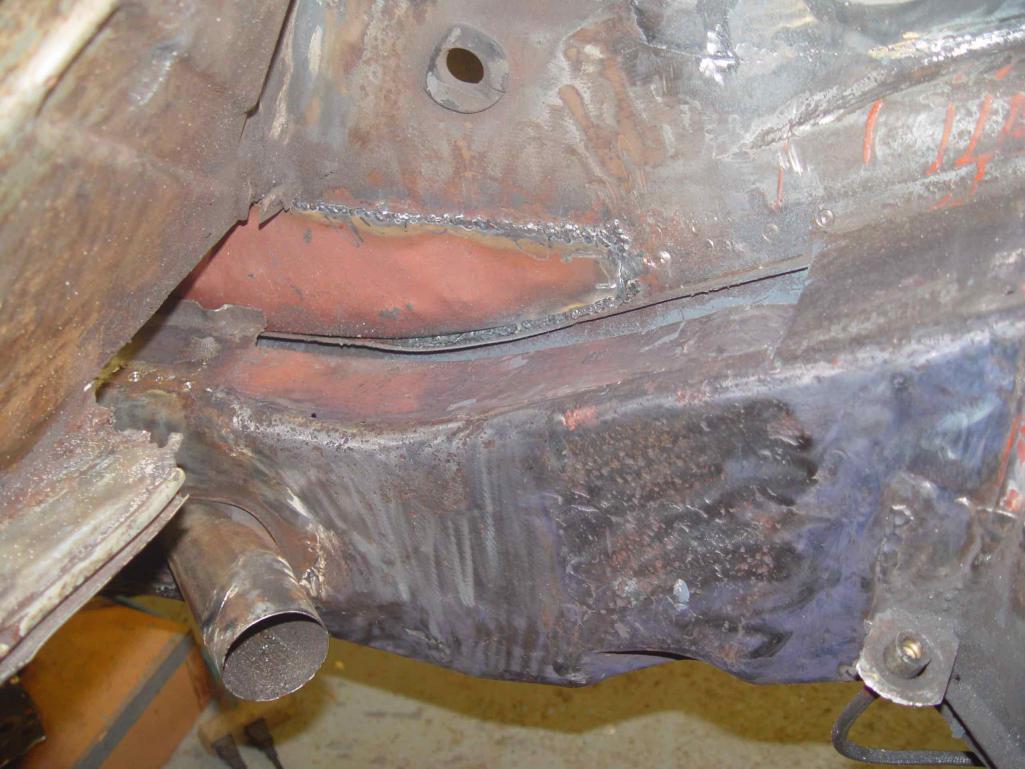
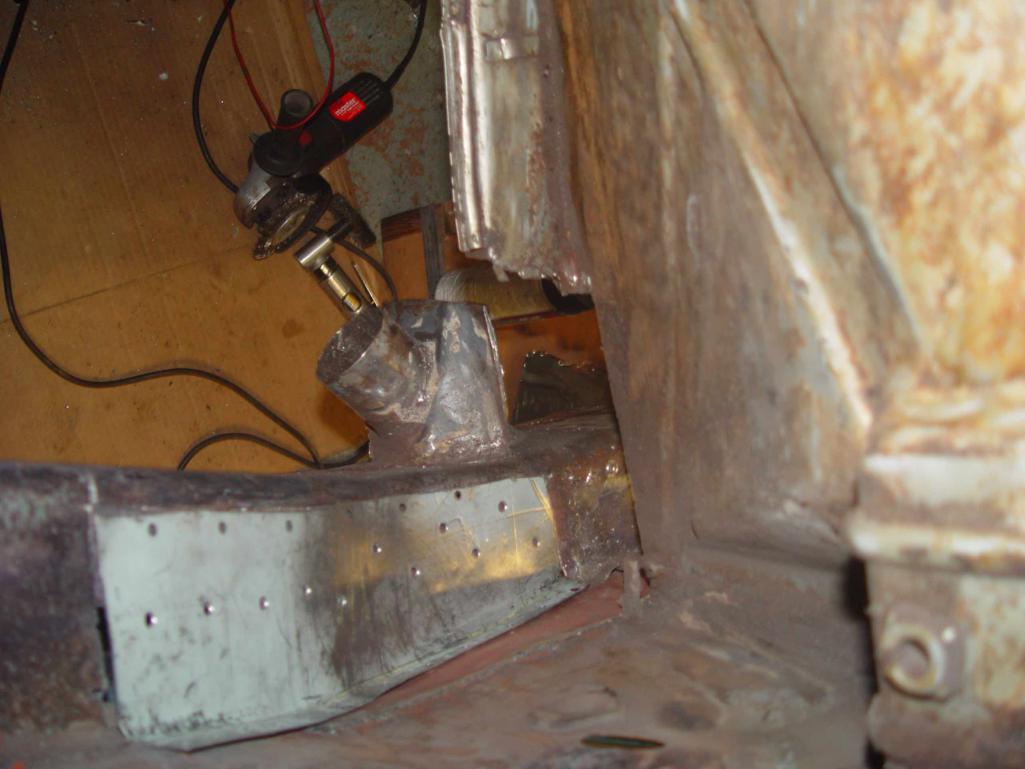
This shot shows something amazing. The air and electric angle grinder tools cost about $10 a piece at Harbor Freight. So I bought enough of them so I don't have to wait to swap wire brushes and abrasive wheels: I have a tool for each. Great but also frightening. Before I close everything up, I spray what I can with this.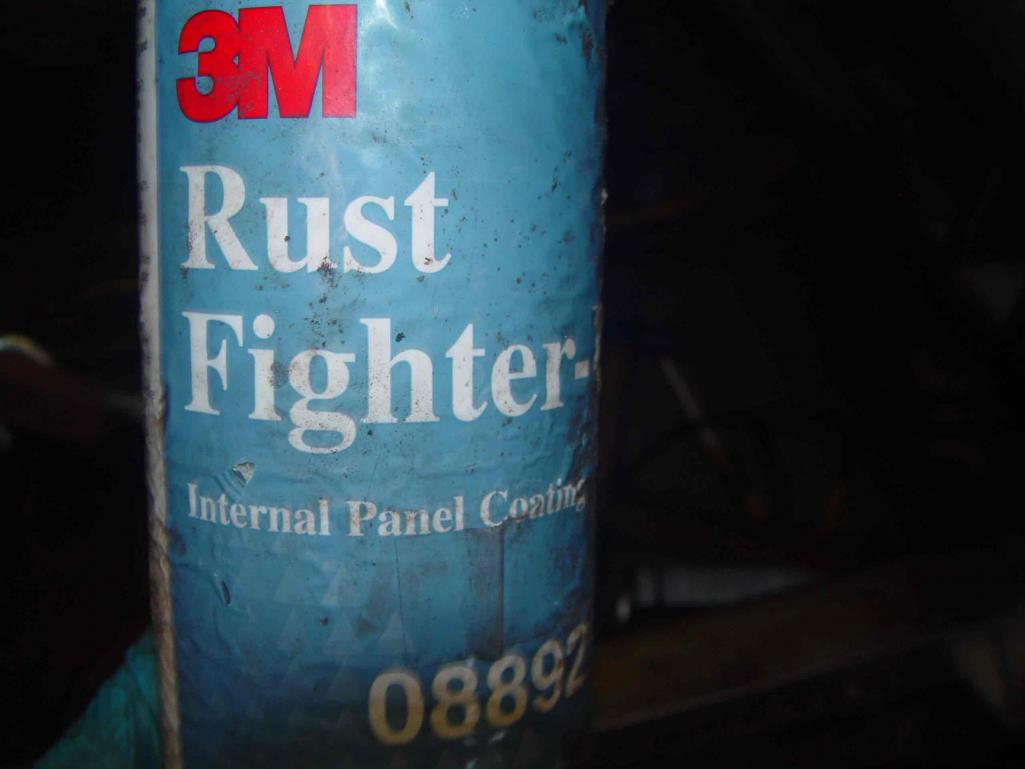
And after some welding and grinding.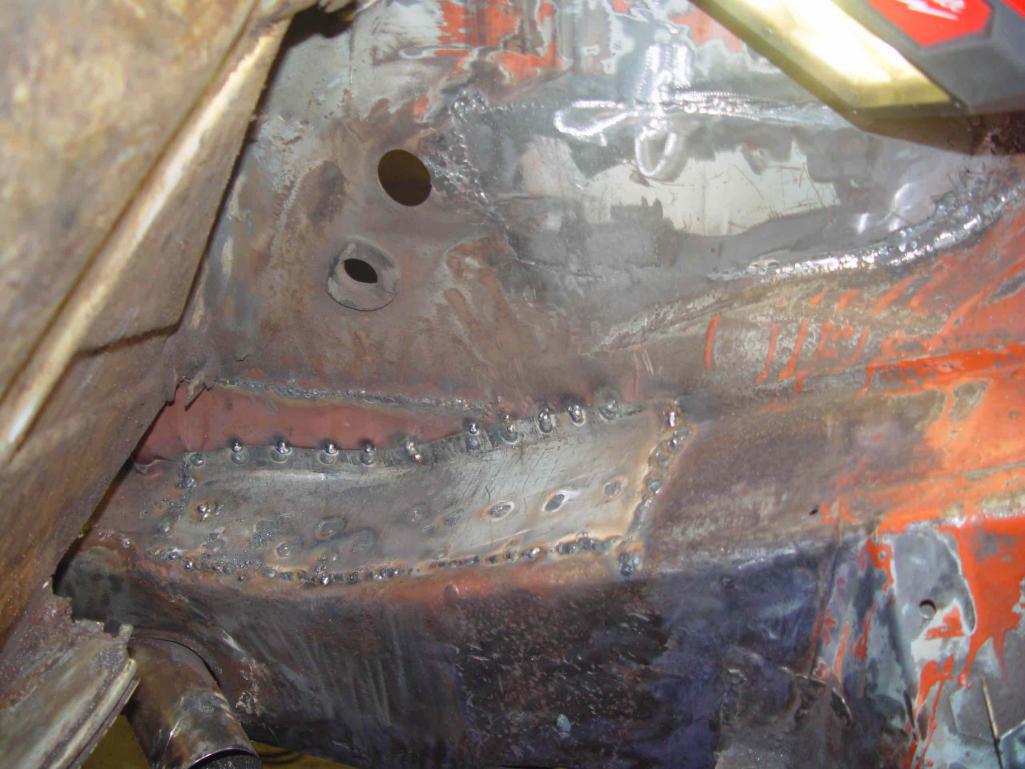
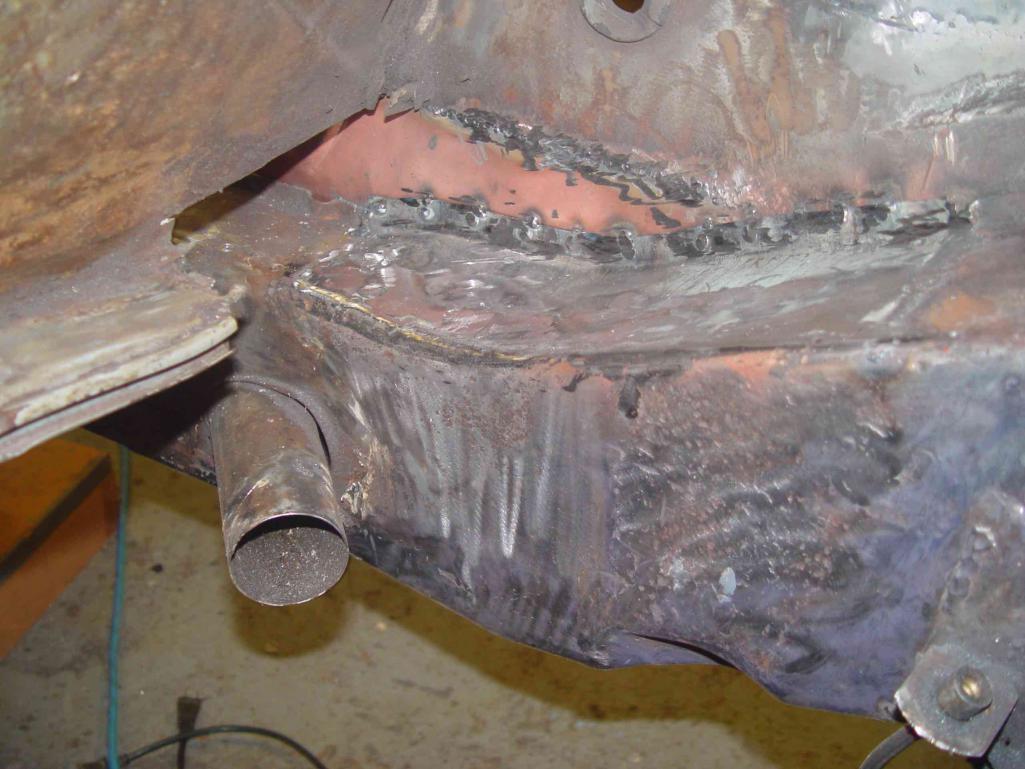
The area under the engine mount is pitted, but I cut off a small square of this piece and it was very solid as the pits though ugly are not very deep. The same was the true for the back of the engine mount.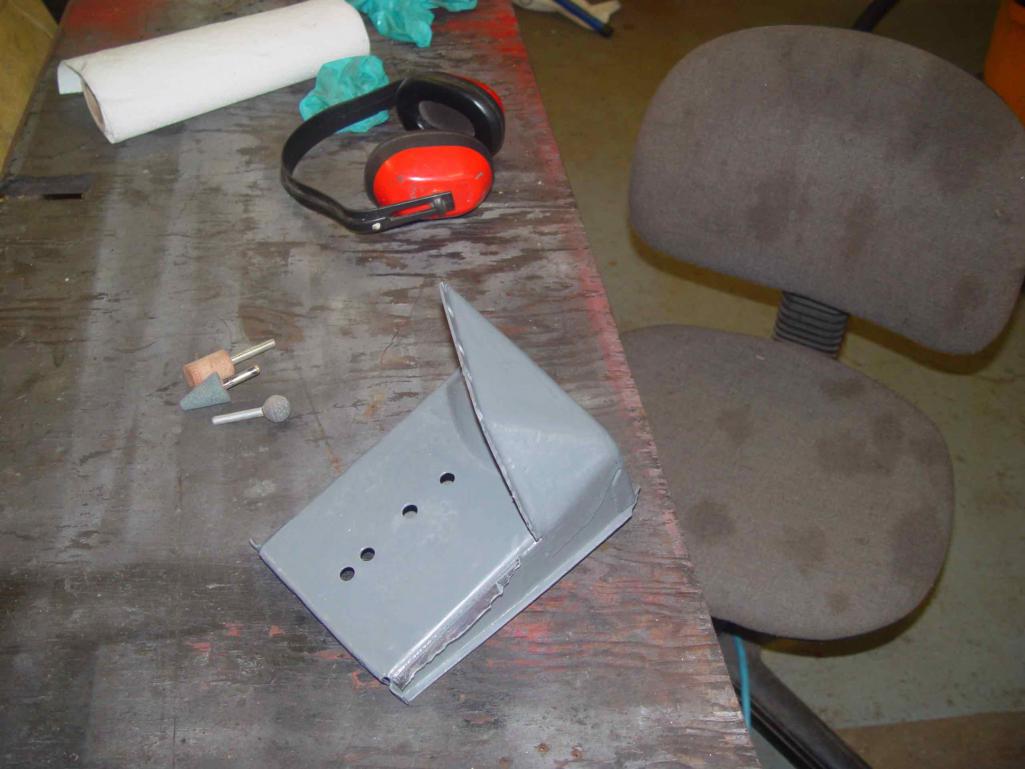
This has been sanded rust converted for the pits and then coated with epoxy primer. Epoxy primer is a miracle for restoration projects. It bonds very well and unlike many other paints is actually waterproof.
Posted by: worn Mar 19 2021, 05:52 AM
Typically the right side of the car has less rust on the long. An unfortunate surprise is not this time. The car was originally purchased by a Baltimore Colts player, reportedly for his wife. You would think such a person would be able to park the car in a garage, but the rust shows that the car was parked slightly nose upwards in the rain. And of course by 2008 when I bought it, it was just a used car.
Starting the patch from the inside. Cutting away the bad like a layer cake. This shows the inside strengthening piece with the congregation. The diagonal edge is the original end of the piece. I have cut away the captive nut for the seat belt.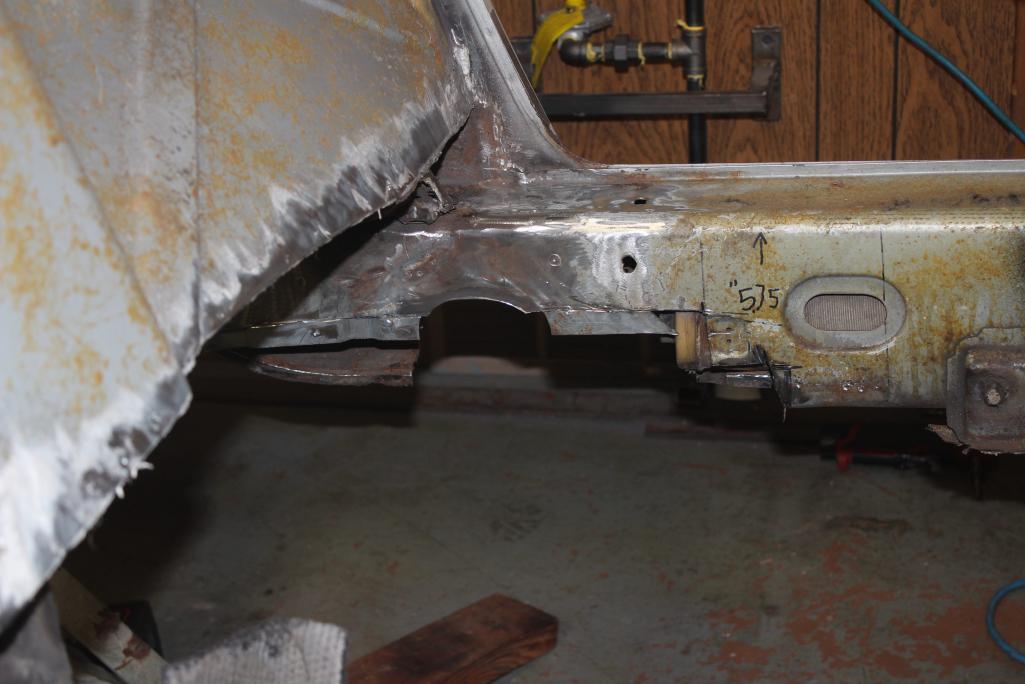
The strengthening piece is thicker than the outside layer of the long. I am using 14 gauge for the inner and 18 gauge for the outer. Both just slightly thicker than the original.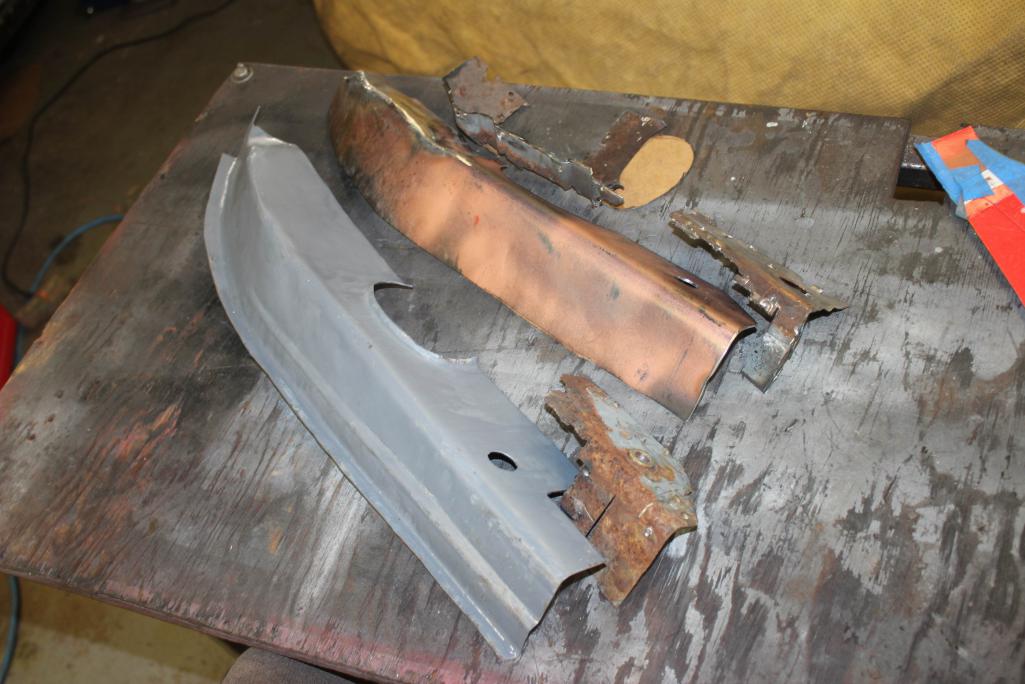
This is mostly done with a hammer and a vise, but I had to cheat a bit at the curved ends and cut and welded to get the deep shape. I maybe could make the thin outer pice by hammer forming, but with the 14 gauge I wouldn't have a chance. They have to nest in order to get the plug welds to be strong. I still have a ways to go to get them right. Then they go back in like a layer cake.
Posted by: worn Mar 26 2021, 09:32 AM
The inner strengthening piece holds the seat belt point. The metal around the nut had deteriorated so a new strap was fabricated to hold the nut.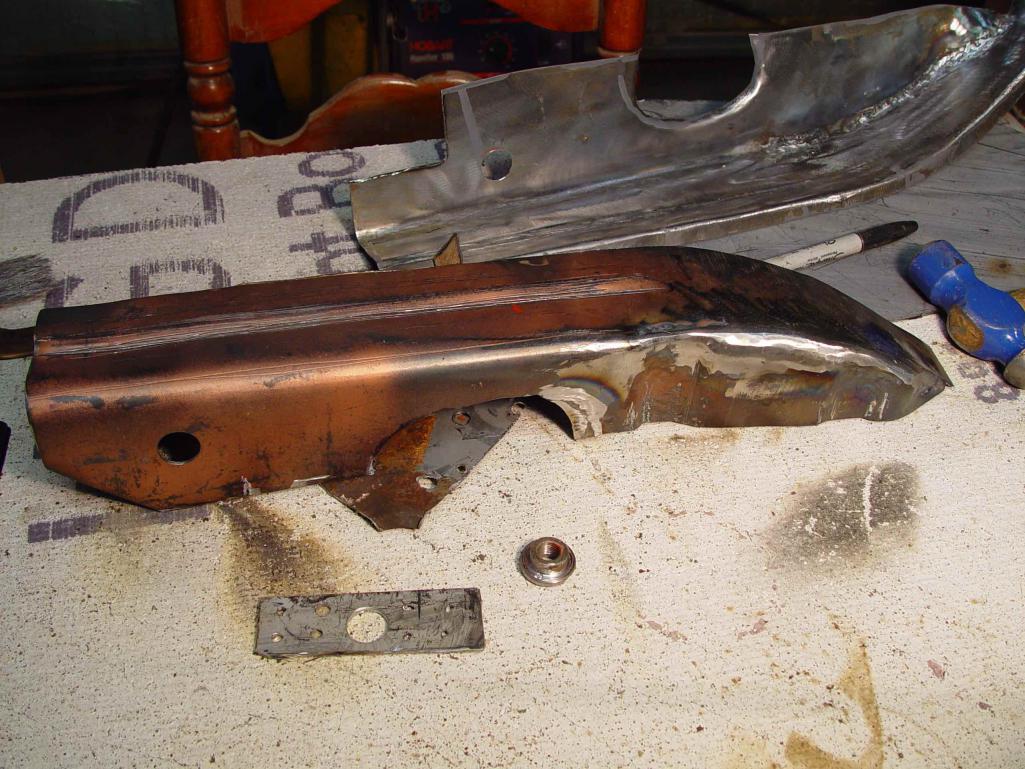
And welded in.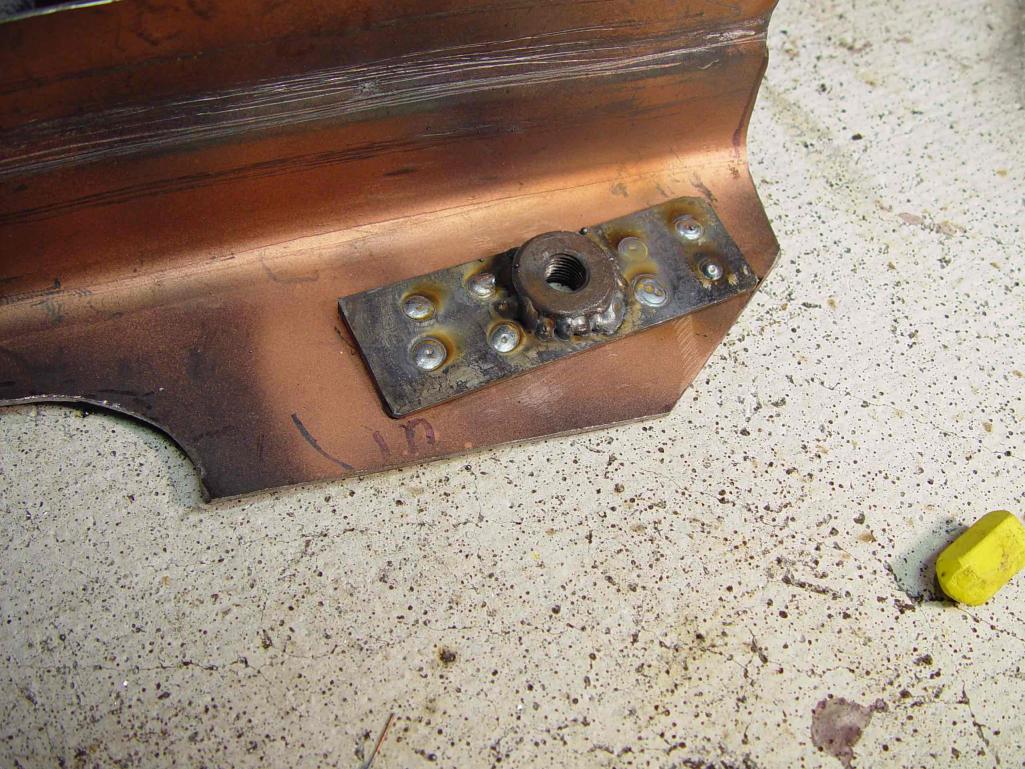
And then the 14 gauge piece goes on with seam welds to the existing inner piece of the inner long. The seam is part way up, and I was glad to get the corrugations to line up.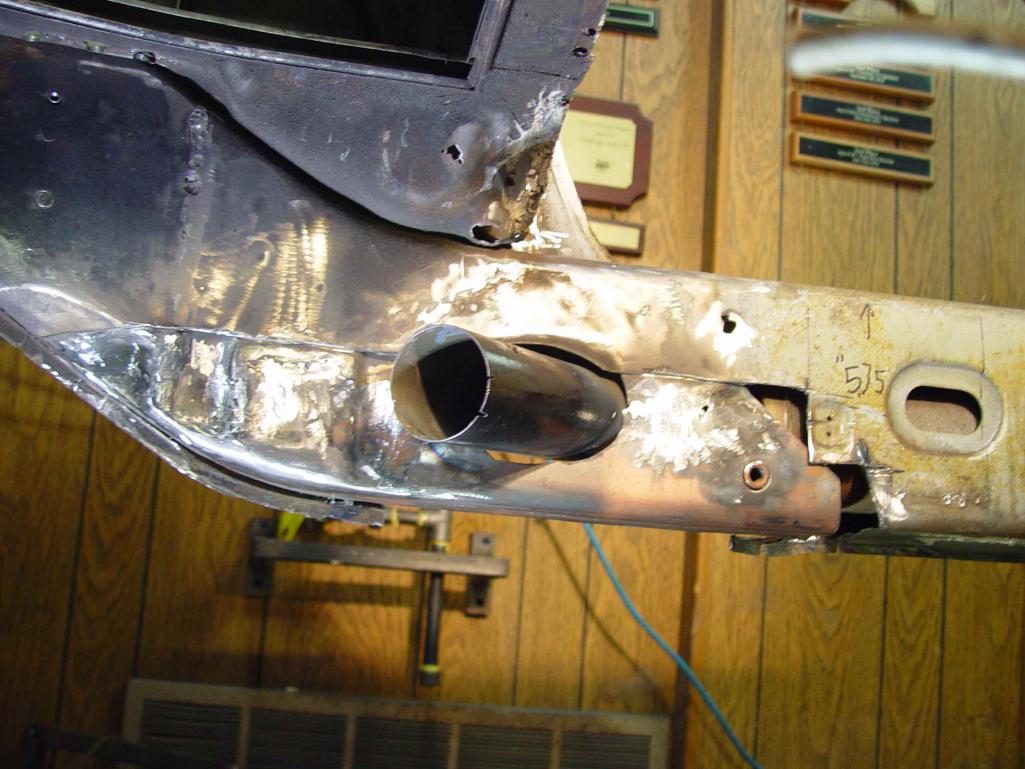
Posted by: worn Mar 26 2021, 09:45 AM
The outer shell of the inner long is thinner: 18 gauge is what I am using to match what I think corresponds fairly closely to the original 19 gauge.
Here it is being shoved into place.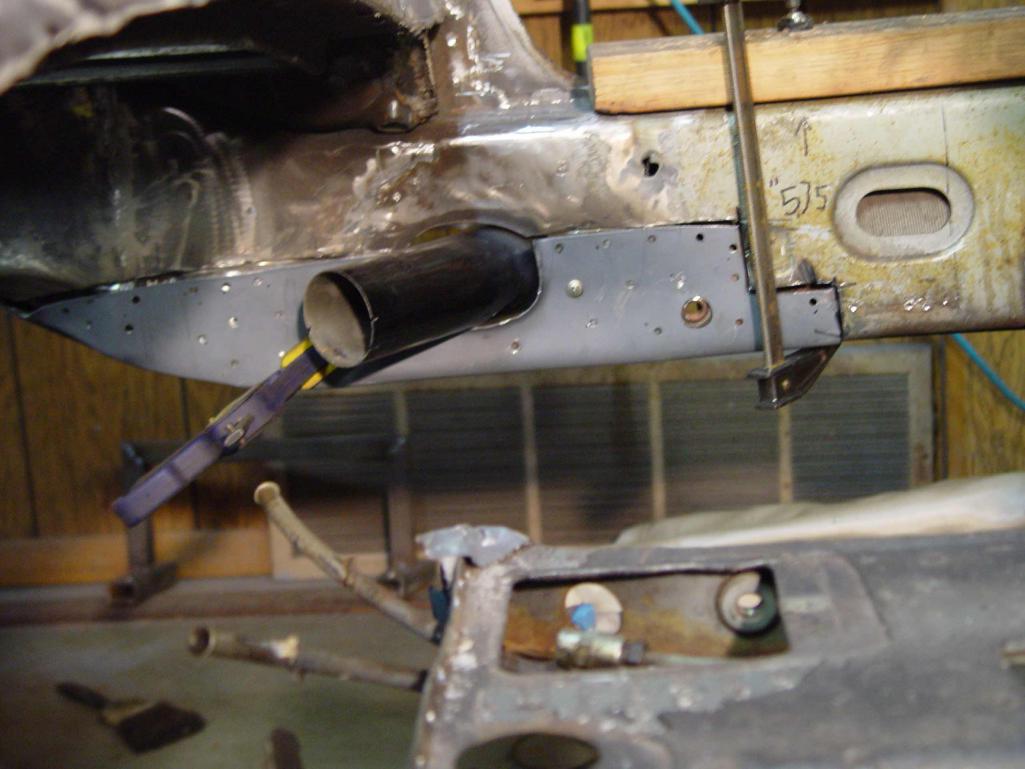
And welding has started to complete this side of the long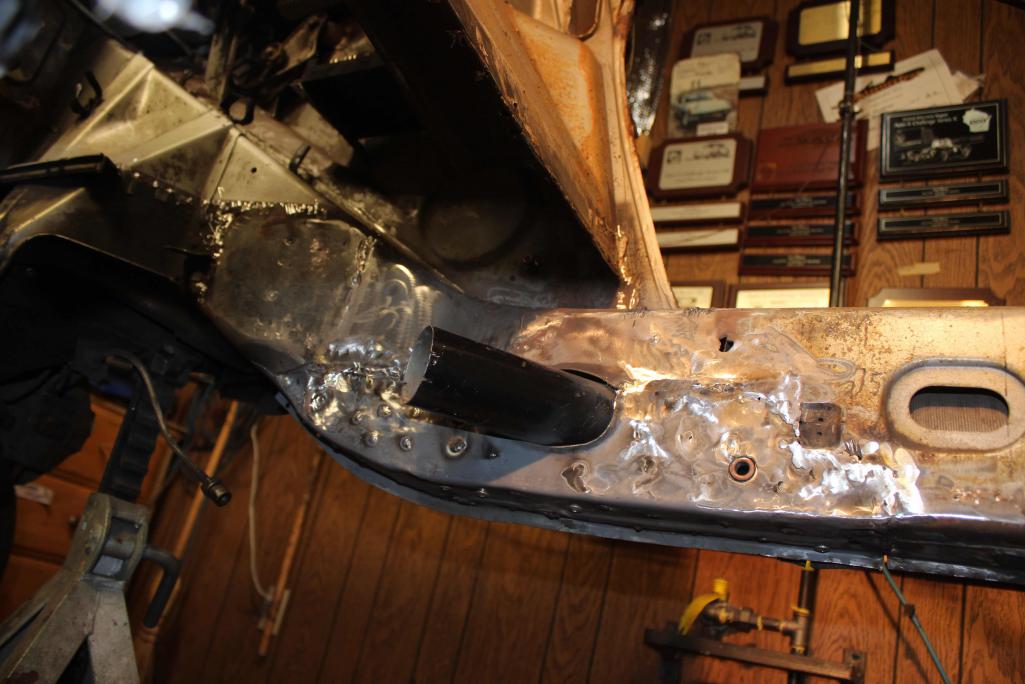
The two parts are supposed to nest together with spot welds joining them. This produces a lot of strength. I used the inner piece as a strong anvil to completely form the outer shell to the inner. This works well, but leaves some small hammer marks.
I found perforation in the driver side engine shelf, so I cut half of it away. I am tempted to try to duplicate it with a hammer, but the easier move would be to dial Canada. Also, smarter move even though I find metal forming the most fun of the whole project. Along with welding. The grinding and the dirt and the working upside down: not so fun. Welding upside down in leather and gloves and hood and swathed in a welding blanket is kind of surreal; sort of like sensory deprivation with sparks flying.
Posted by: 930cabman Mar 26 2021, 12:15 PM
Nice looking work and it appears your project was not tooo bad. Some of these hulks will never be close to original. Keep posting you work and thank you
Posted by: worn Mar 26 2021, 07:54 PM
Nice looking work and it appears your project was not tooo bad. Some of these hulks will never be close to original. Keep posting you work and thank you
Thanks. When you get rust on the left side there are fewer options. Not as many replacement panels for sale. You can buy the outer long, but in my case only the rear part of the panel is damaged at maybe the rearmost two inches. I think I can see the waterline from being parked in the rain. Rust from the inside out shows a slight nose up slant. Didn’t find any debris inside, but the rust was there in specific areas along the undersides.
Posted by: Shivers Mar 27 2021, 08:29 AM
Nice work.
Posted by: FourBlades Mar 27 2021, 08:56 AM
Great repair job! ![]()
You are on a roll now.
John
Posted by: worn Mar 31 2021, 08:47 AM
Great repair job!
You are on a roll now.
John
Yep. Moving to the outside layer cake. I really hoped that the left side would be better, but it is slightly worse. Looks like the Counting Crows hit the nail squarely on the head. It was probably Raining in Baltimore much of this car's life.
At any rate this shows three layers of metal.
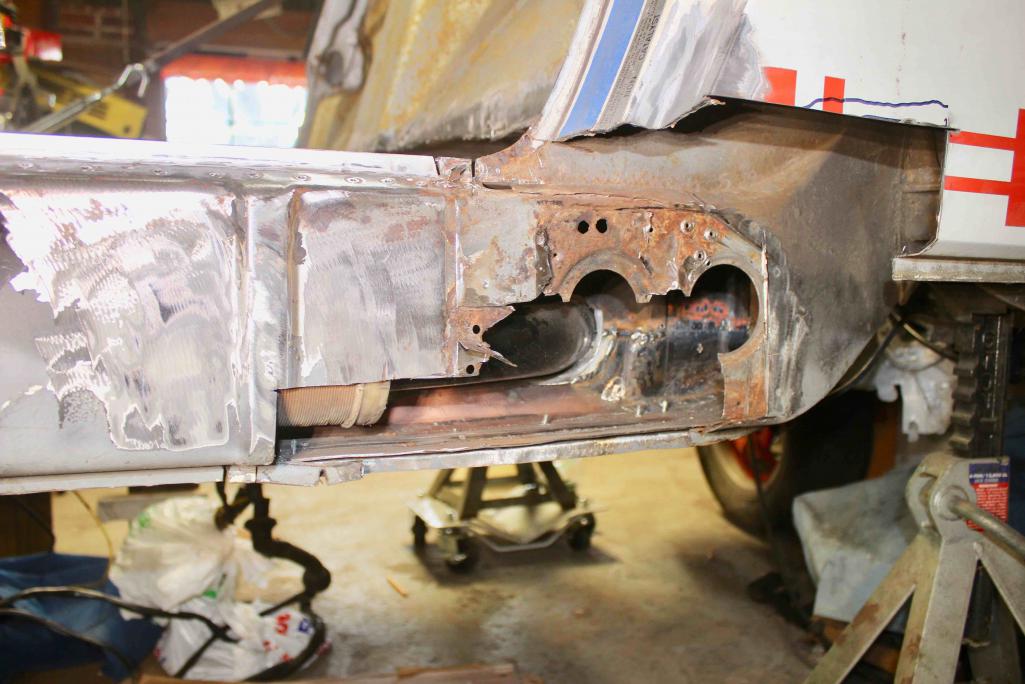
There is the front outer long: rusted at the last two inches. This panel is made by RD, but that is a lot of cutting to patch that little part. In the rear there is the outer layer that goes on to make the wheel house and then a strengthening layer (with the punched large holes. This is made out of stronger steel. Fortunately I have a punch set. Not sure how close a match they are yet. Farther in the hole are the weld back sides of the repair of the inside long. Screws poking in are temporary: have to get them out and finish those plug welds.
Question for anyone who might know. Is it possible to replace the jack point without cutting out the fender and sill? I don't see how, but still wonder.
Posted by: worn Jan 11 2022, 01:27 PM
Been awhile but in the mean time I have been remodeling some rooms, rebuilding the 911 engine, and getting gifts made for x-mas (shaping and grinding Damascus steel kitchen knives).
Returning to the left side: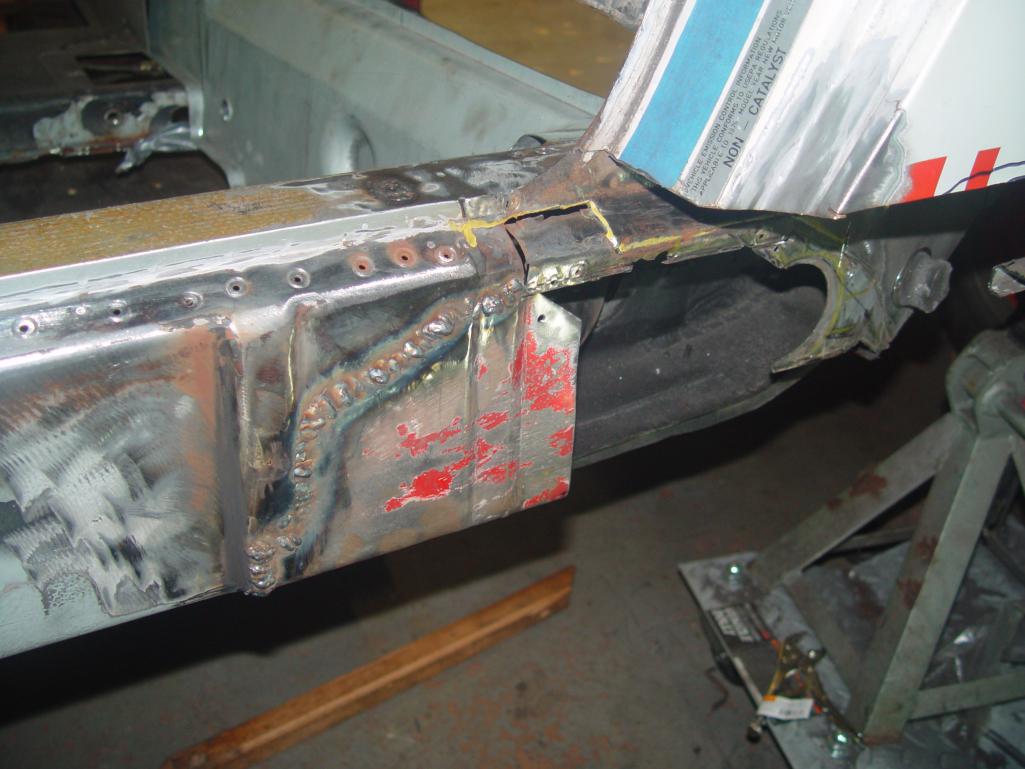
like the right side I worked from inside out. Replacing the rear end of one piece.
This inner piece to the rear is overlapping the first patch. As before, I am replacing ends or bottom areas of a large piece. Matching the holes originally there was a PITA and perhaps I should have just them out, but here they are a bit of the ugly.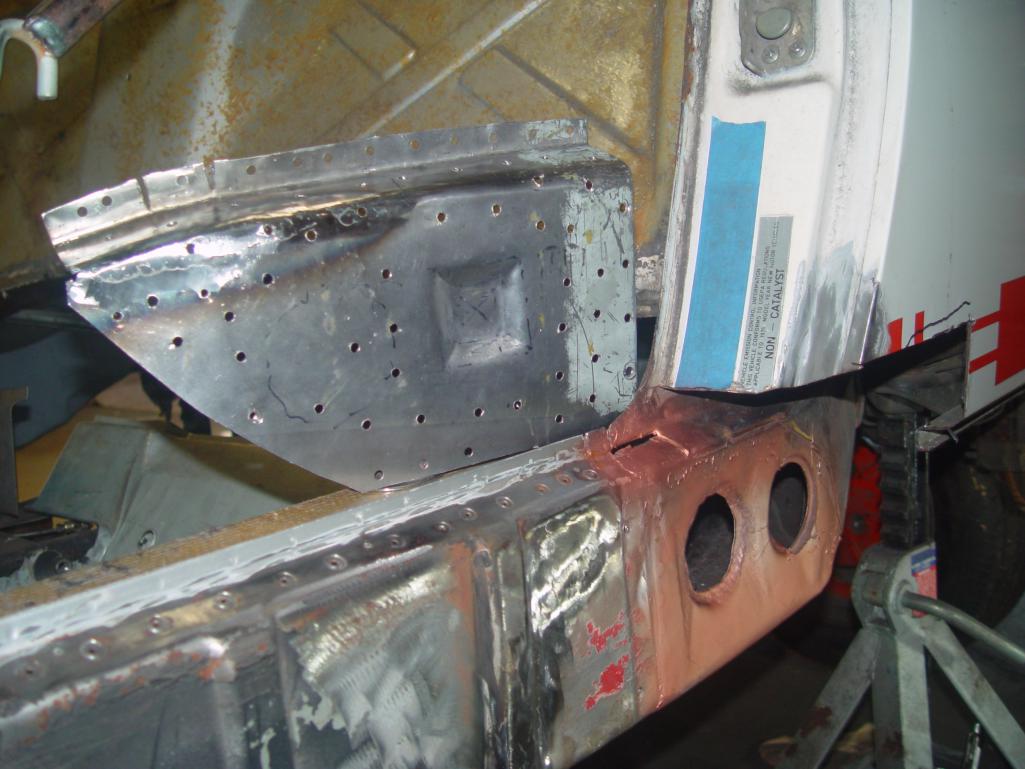
The hole towards the front is behind a depression in the next piece that overlaps. The depression is for the jack point.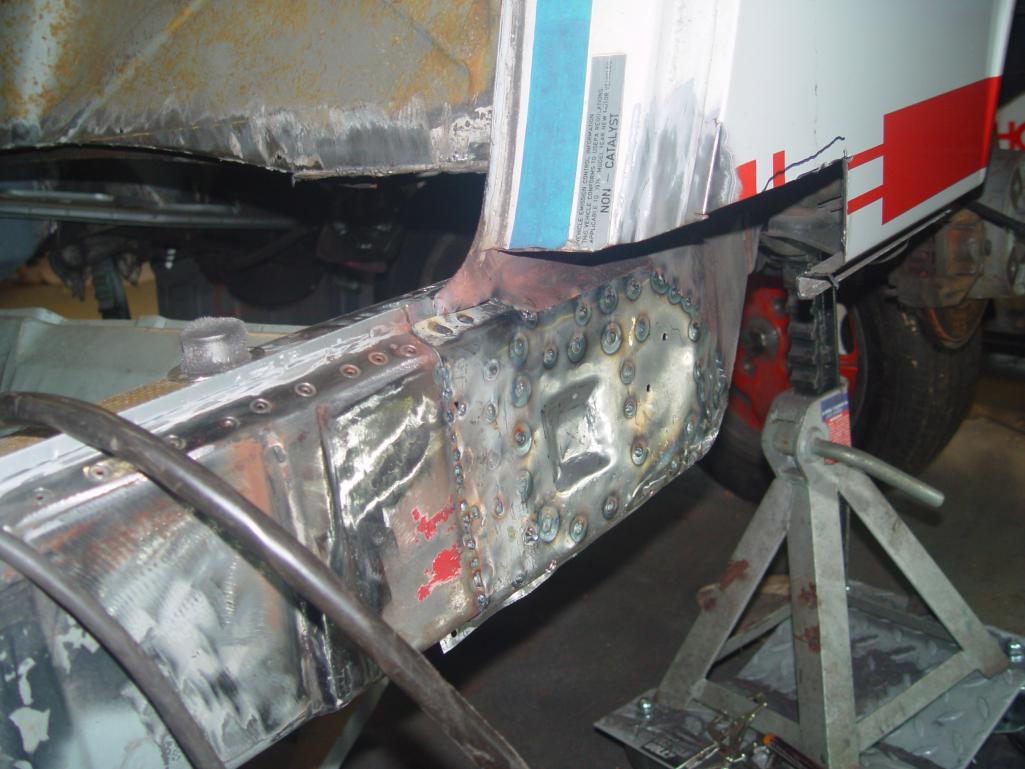
Attached thumbnail(s)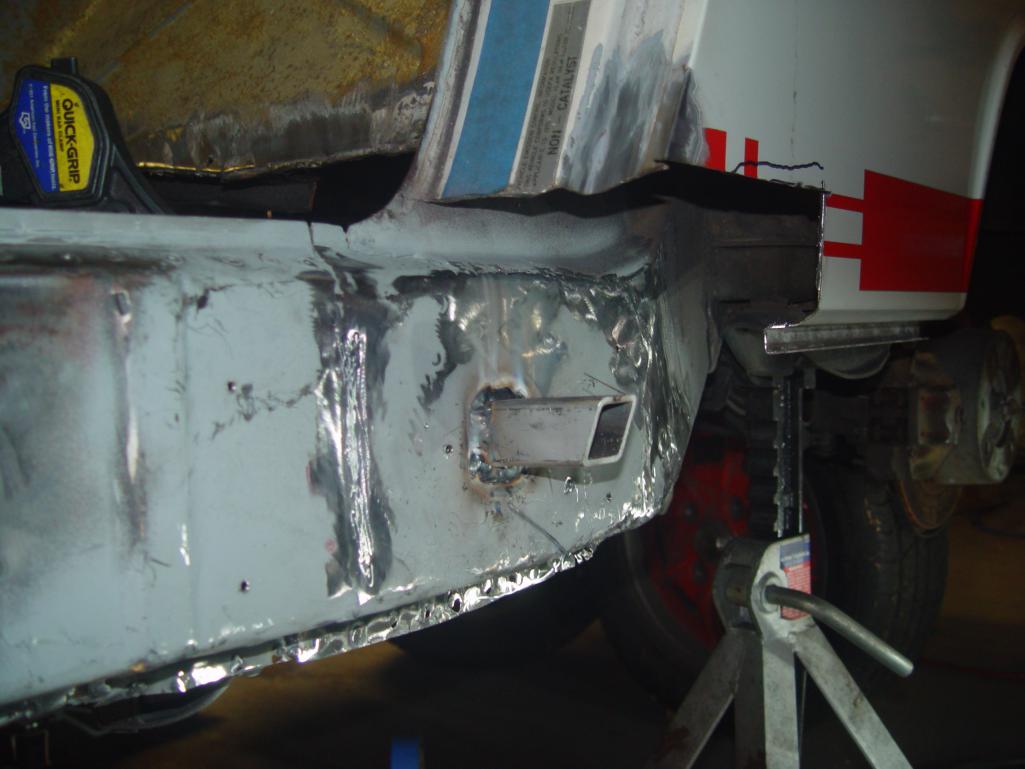
Posted by: worn Jan 11 2022, 01:32 PM
The jack point has to be located such that it lines up with the hole in the outer rocker.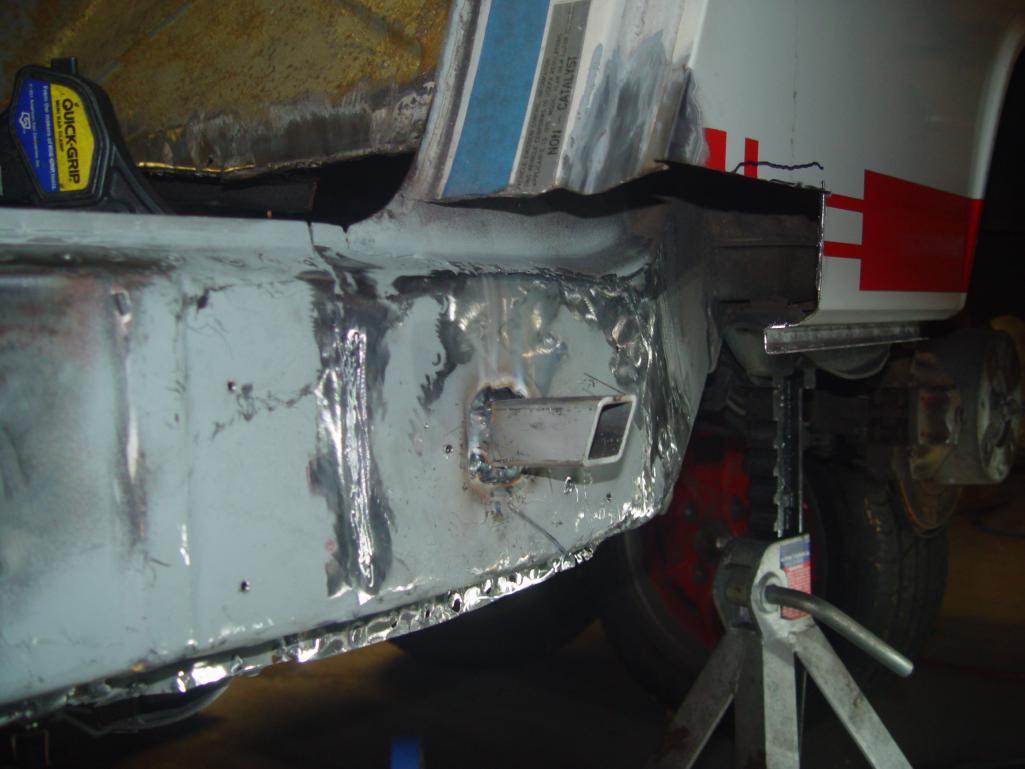
Then yet another layer goes on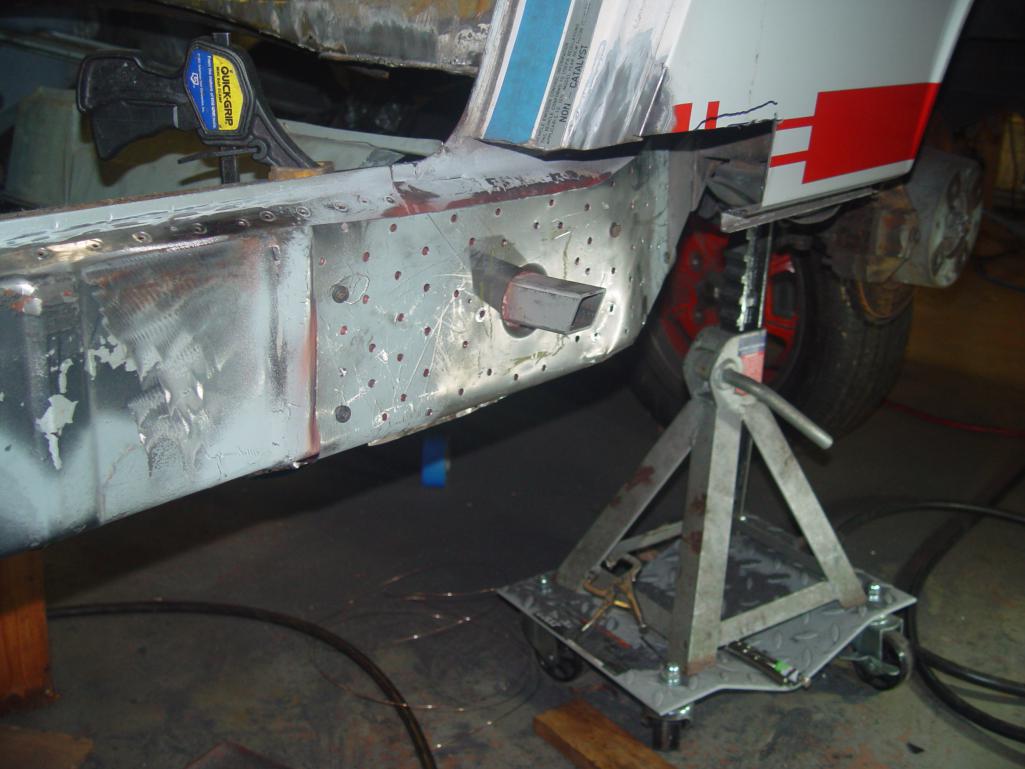
Then a nice pressing from RD. Glad the DeJonges are here for us.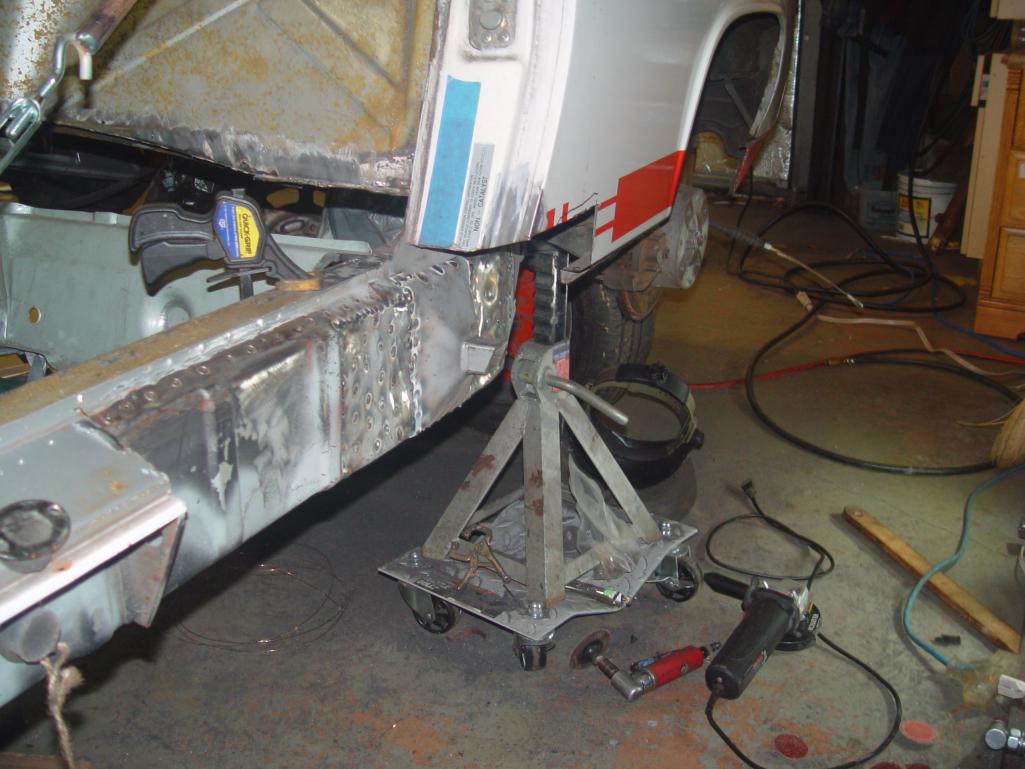
So the left side is seeing some progress. All in an afternoon (at the computer)
Posted by: worn Jan 11 2022, 01:36 PM
Back to the right side. Spent some time fiddling with bits I didn't like and then welded on the jack point. And fabricated the next layer.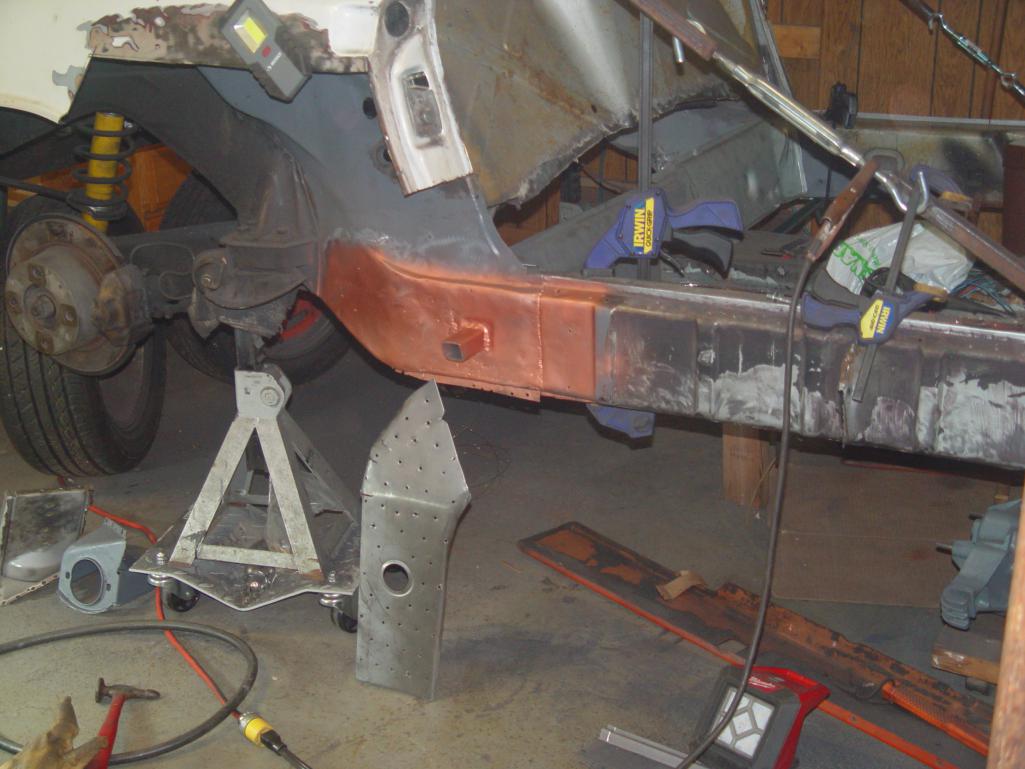
On it goes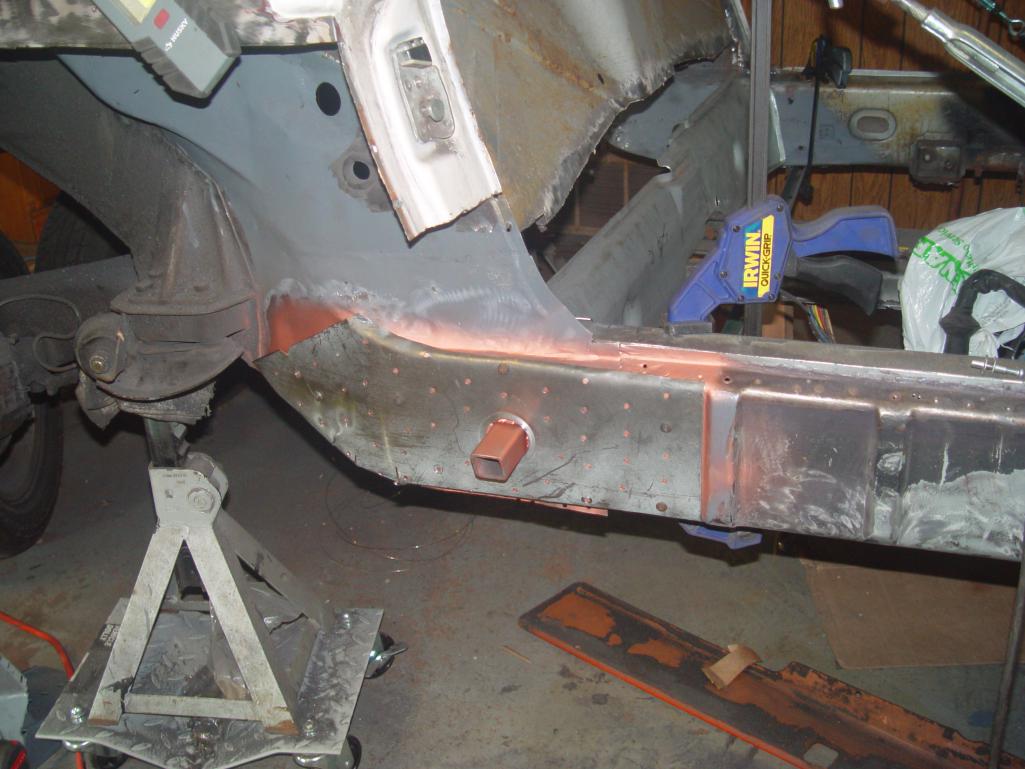
And another perfect pressing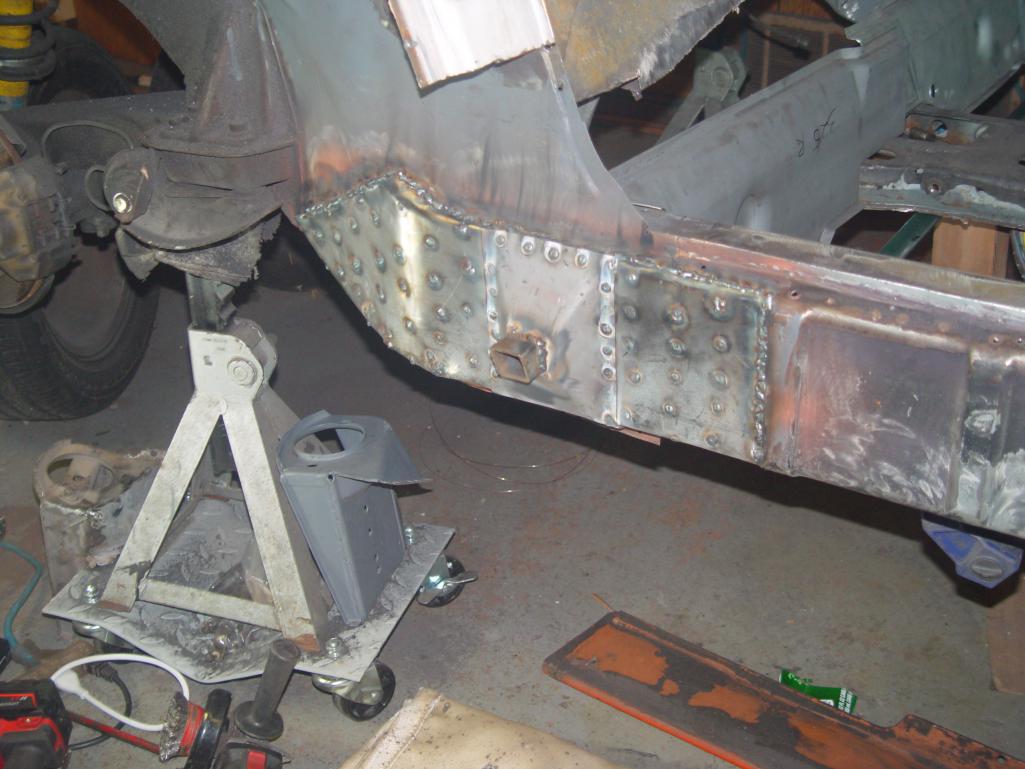
Posted by: worn Jan 11 2022, 01:44 PM
Speaking of RD wonders, here is the rear part of the box beam that connects the longs from side to side.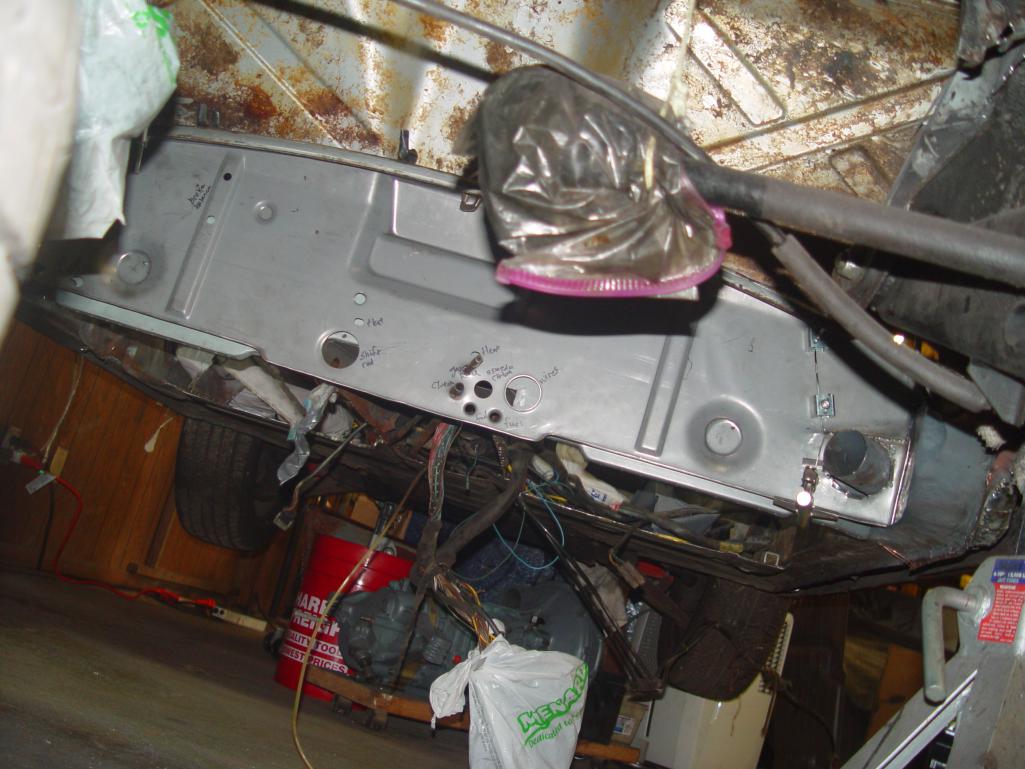
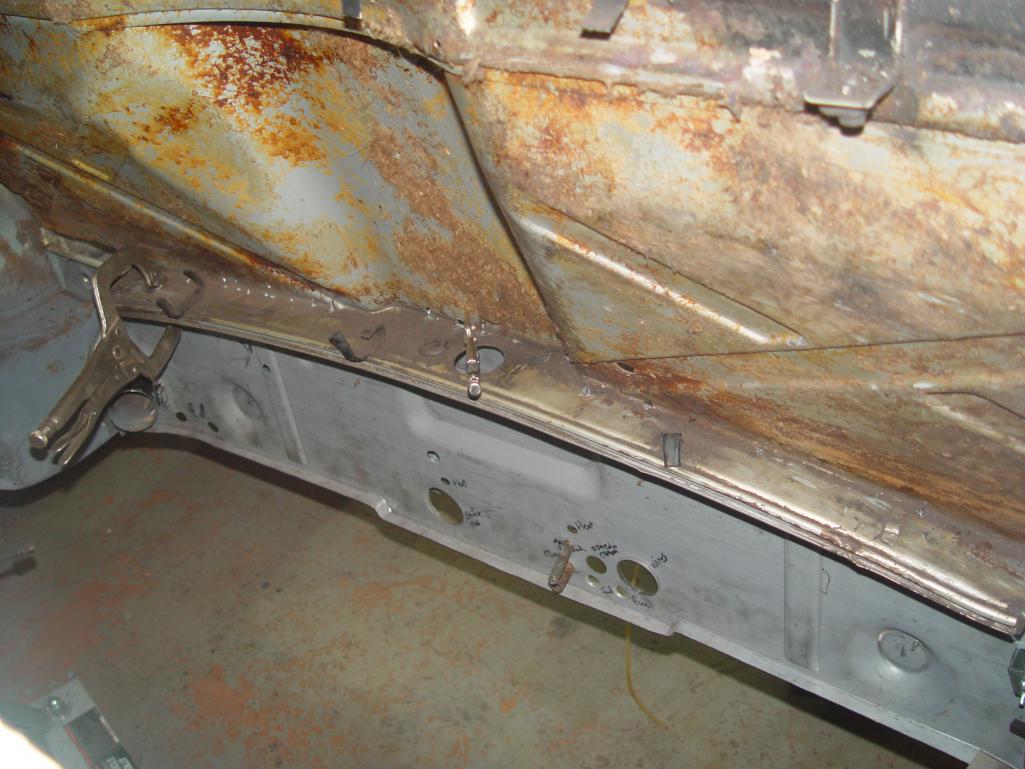
Note the cuts needed to get past the heater tubes.
For the parking brake and heater control tubes I took them out and will be brazing them back in.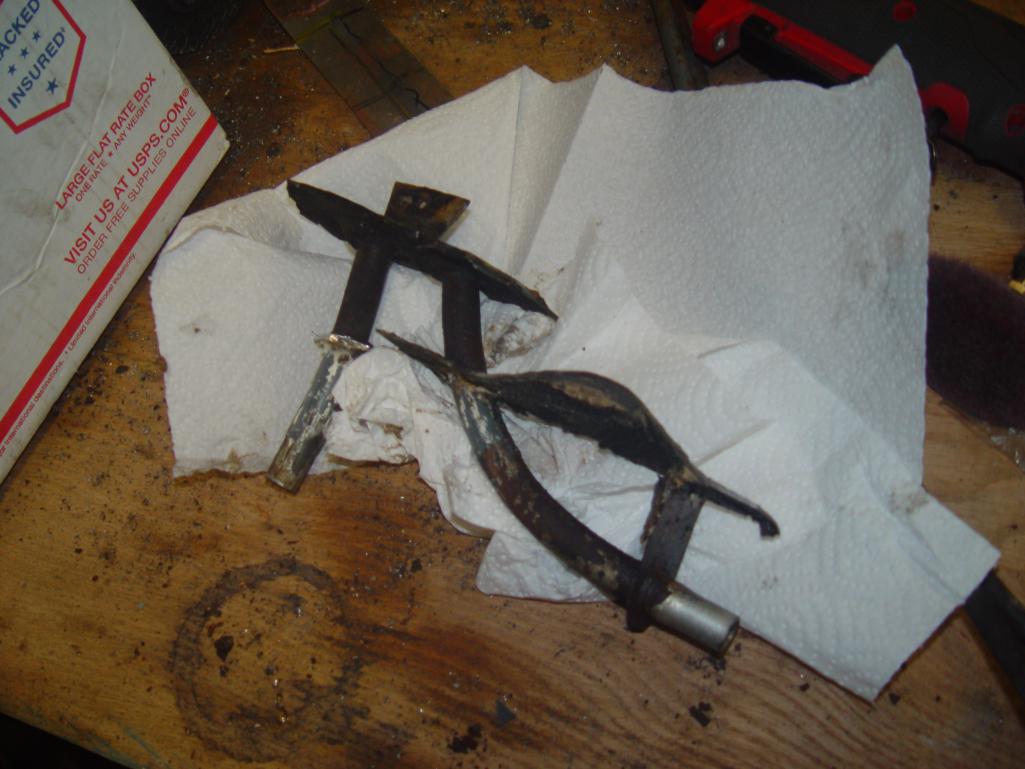
Posted by: mb911 Jan 11 2022, 01:55 PM
Speaking of RD wonders, here is the rear part of the box beam that connects the longs from side to side.
Note the cuts needed to get past the heater tubes.
For the parking brake and heater control tubes I took them out and will be brazing them back in.
That was a killer on mine. Bled through in a few spots and had to get very creative to get the cables through
Posted by: JeffBowlsby Jan 11 2022, 02:13 PM
The jack point has to be located such that it lines up with the hole in the outer rocker.
Then yet another layer goes on
Then a nice pressing from RD. Glad the DeJonges are here for us.
So the left side is seeing some progress. All in an afternoon (at the computer)
I just found this thread. Is this Creamsicle on the Can Am Registry?...and if so what is the VIN?
Posted by: worn Jan 11 2022, 07:08 PM
I just found this thread. Is this Creamsicle on the Can Am Registry?...and if so what is the VIN?
Sorry Jeff, it isn’t a real Creamsicle. Originally owned by a Baltimore Colt who bought it in his college colors of silver and white. Sold to a man who quickly sprayed it white and orange. It is a ‘76.
Warren
Posted by: worn Jan 11 2022, 07:14 PM
That was a killer on mine. Bled through in a few spots and had to get very creative to get the cables through
I know. I now use silver brazing rod. It comes covered with bright orange flux. Flows really nice. A bit pricey, but so is all of the irritation of fighting uphill.
Posted by: 930cabman Jan 12 2022, 09:01 AM
Why do we punish ourselves with this crap??
Great looking work and soon she will be back on the road.
Thanks for the updates
Posted by: worn Jan 12 2022, 09:49 AM
As the Brits would say, I offered up the floor to see what I need to do to get that piece welded in. Looks good , except there is a bit that sticks out towards the middle of the outside firewall.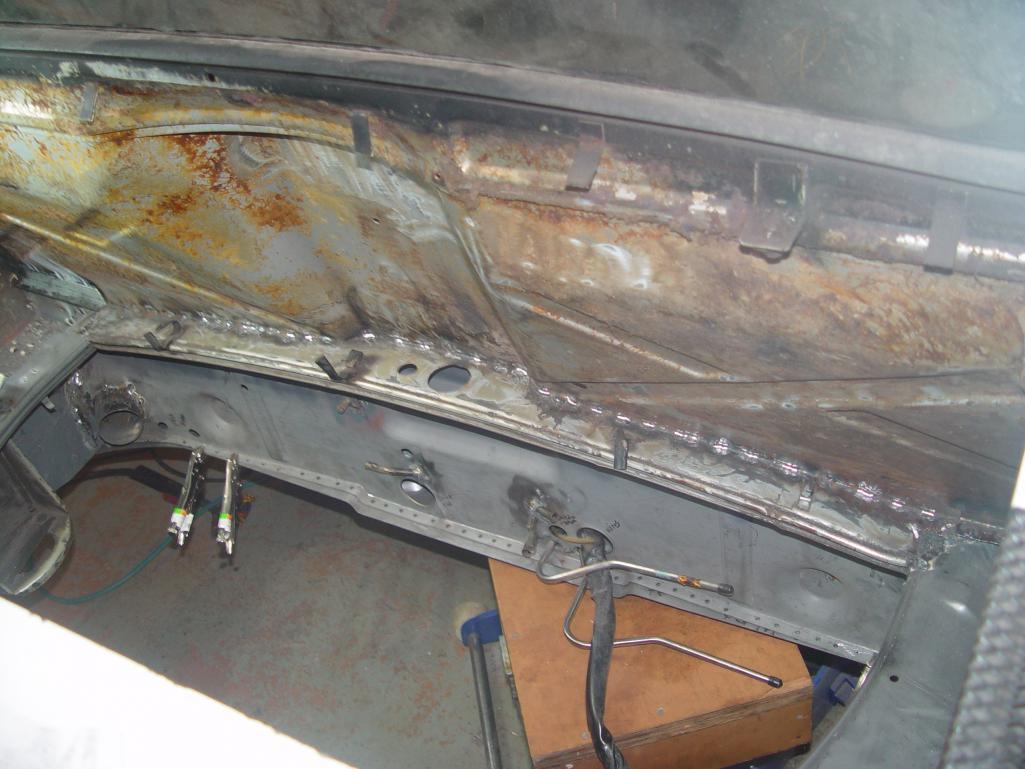
I know that I usually have to do some work on the pressings in order to get them to fit right. Or do I need to unbraze some tubes and pull the firewall out?
Posted by: worn Mar 13 2022, 10:55 AM
I know that I usually have to do some work on the pressings in order to get them to fit right. Or do I need to unbraze some tubes and pull the firewall out?
Answer was - Yes.
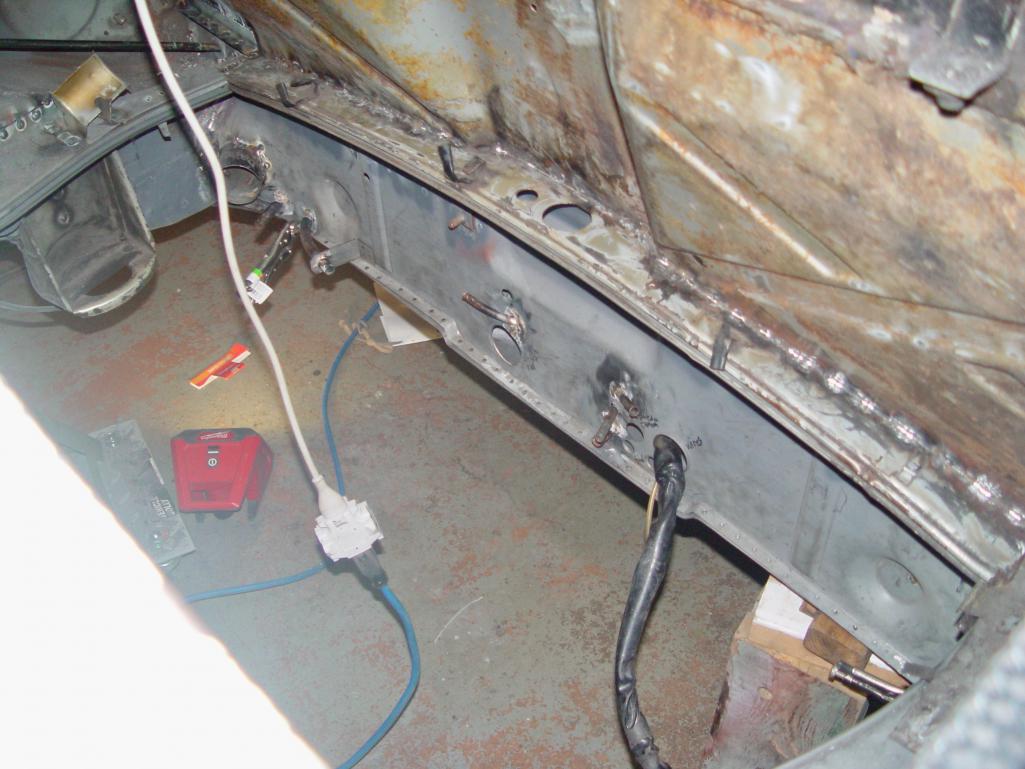
Then I could weld in the floor patch
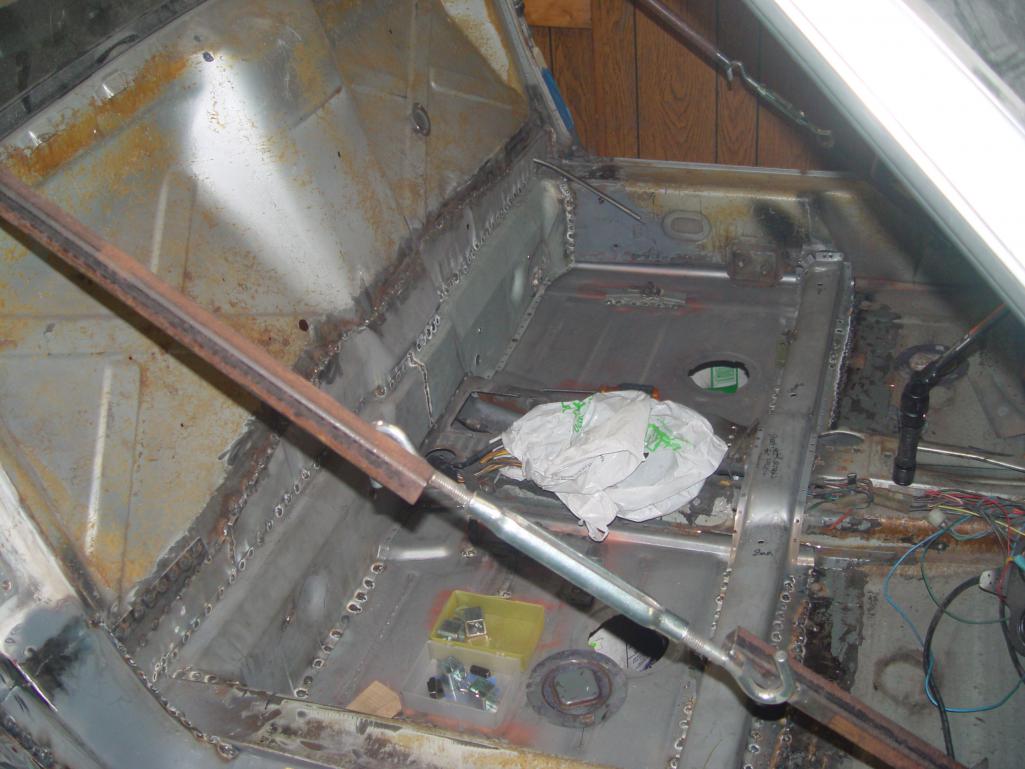
Posted by: worn Apr 6 2022, 02:53 PM
I have some advice to those who try this sort of thing. It has probably been mentioned by others: if you are going to paint the car after rust repair, strip the paint first. You never know what you might find underneath. Second piece of advice: Think about ways to get the project up and off the ground higher than jack stands. You can probably get a lot of the cost back on a rotisserie if you sell it afterwards, and in the meantime you get the full benefit.
In my case I found rust underneath the paint that made me get out the welder again. And I also waited too long to get the vehicle up on the lift, although for awhile the lift was occupied by the 911.
Here goes the paint.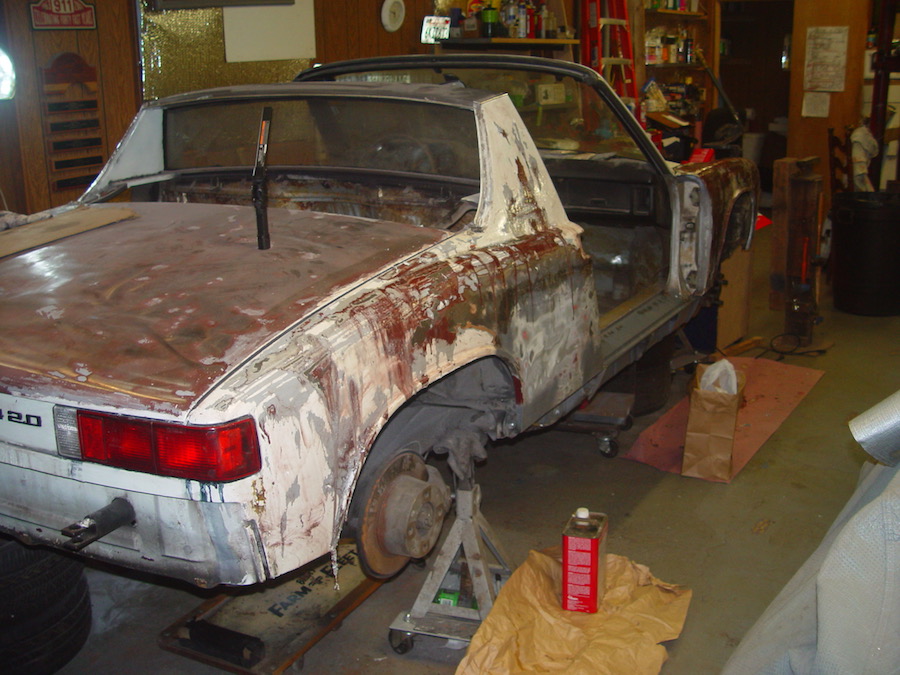
The wire brush will take away seam sealer - and move it all over the place.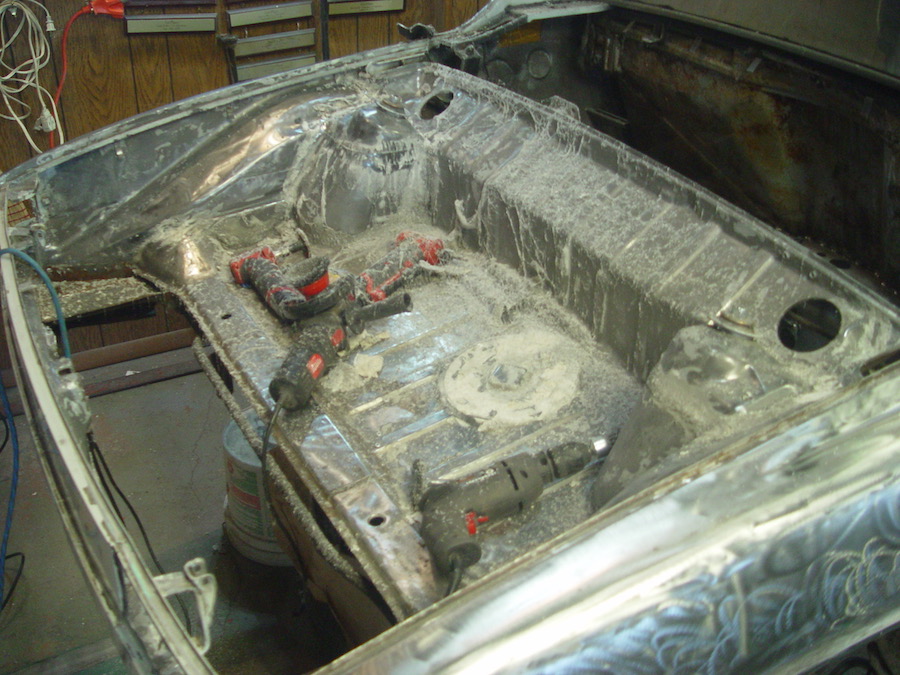
I knew about the trunk floor, and in front I am replacing part of the floor altered by long gone AC. But I didn't know about the sails. Shown with fabricated patches.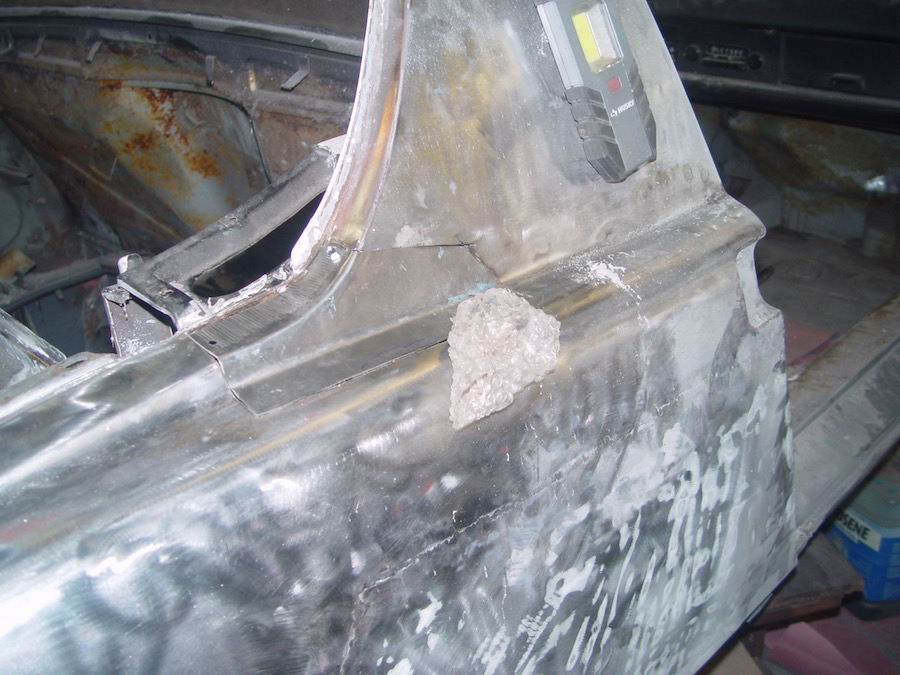
and the driver side.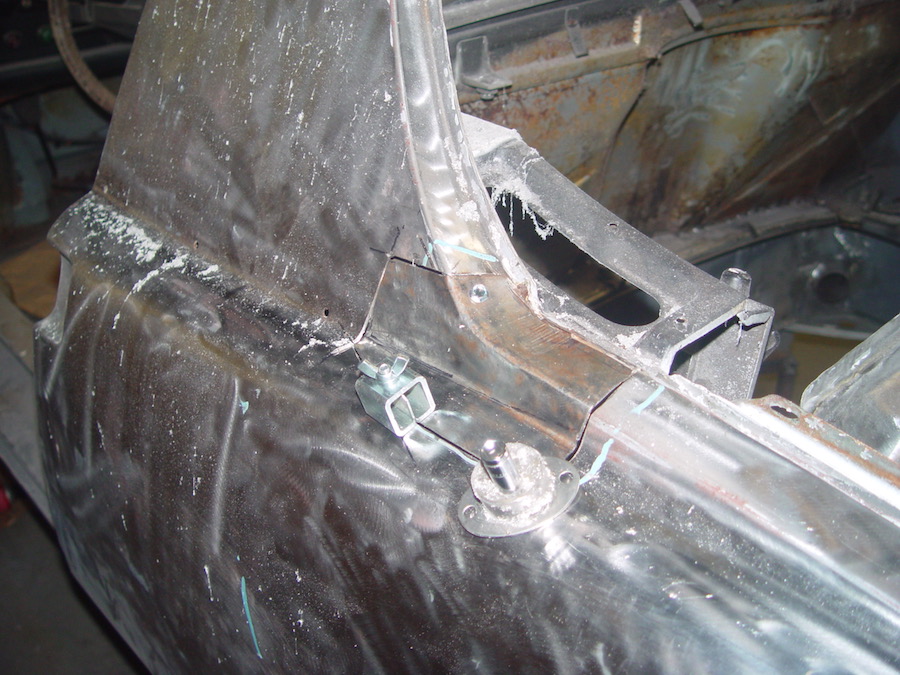
Nor the area around the vents on both sides.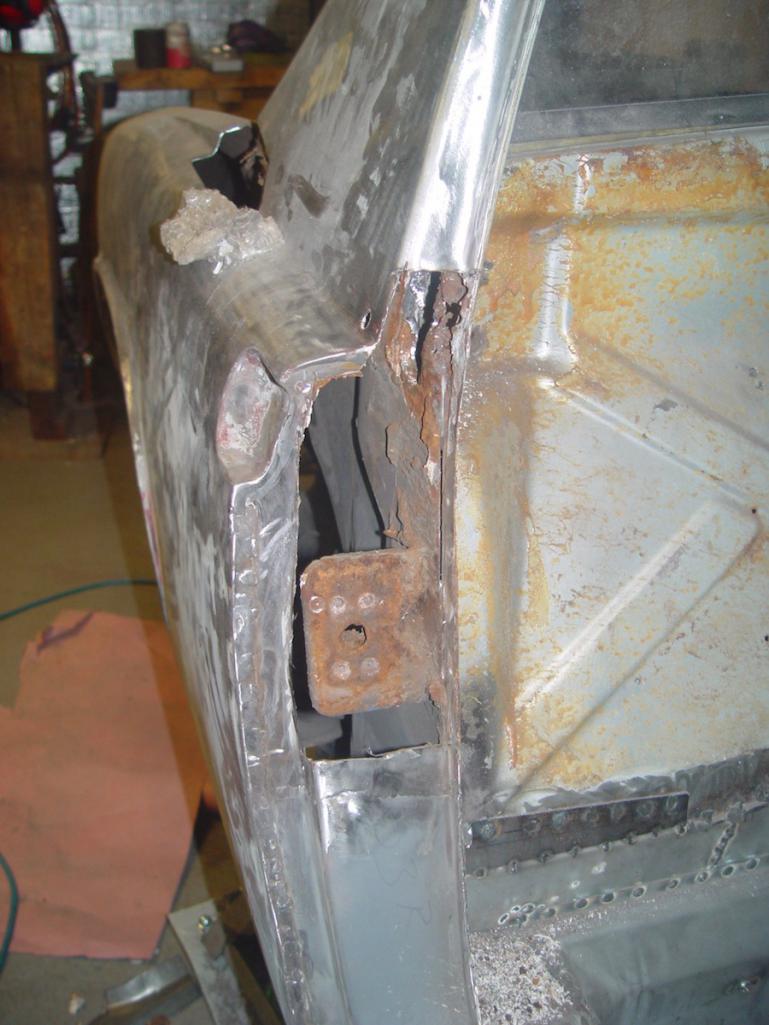
Posted by: bkrantz Apr 6 2022, 08:21 PM
You're not the only one who got started, found more trouble, and had to back up and go deeper.
And I strongly endorse a rotisserie for any serious body work. Even stuff "on top" is easier when the car can be rolled on its side.
Posted by: worn May 23 2022, 09:58 AM
The trunk floor supplied by RD is made for the earlier cars. 75-76 models had spring loaded bumpers to withstand small impacts without damage. That means at each side the floor of the trunk steps up. If I just install the new piece as is I will loose considerable trunk space. The reshaping requires that I first flatten out the little ribs pressed into the floor at the sides and then reshape to match the old.
Here is the frame that ties the bumper to the floor and other structures.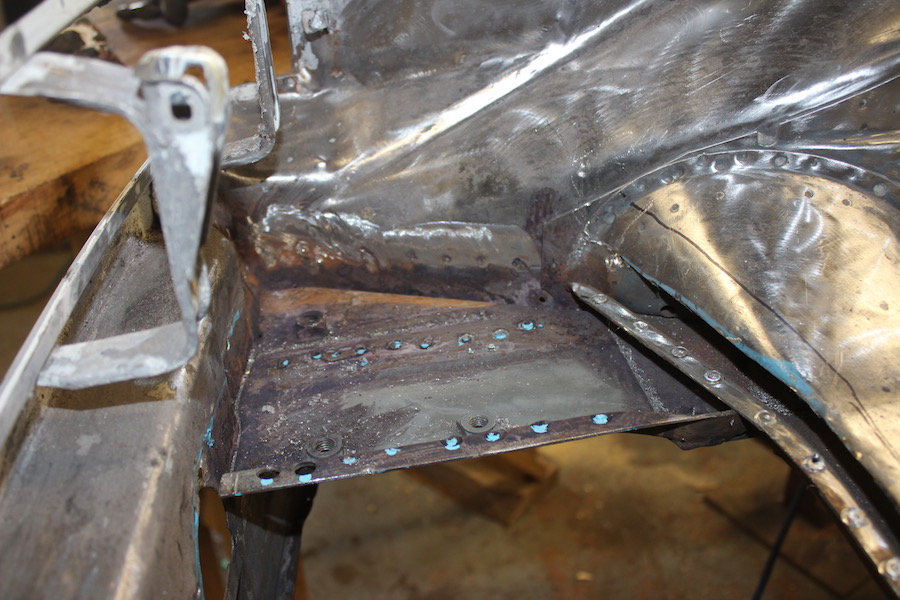
And here is what it looks like outside with the spot welds drilled out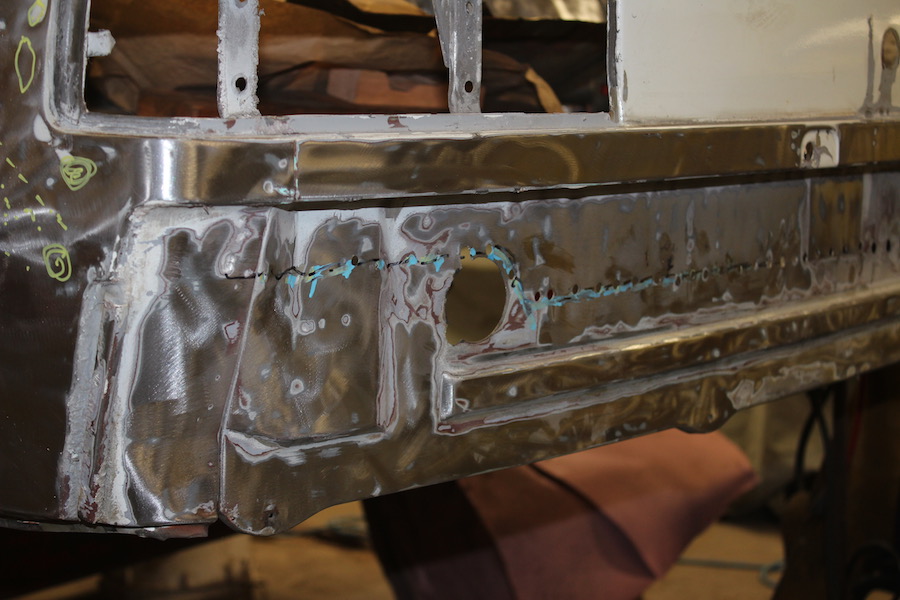
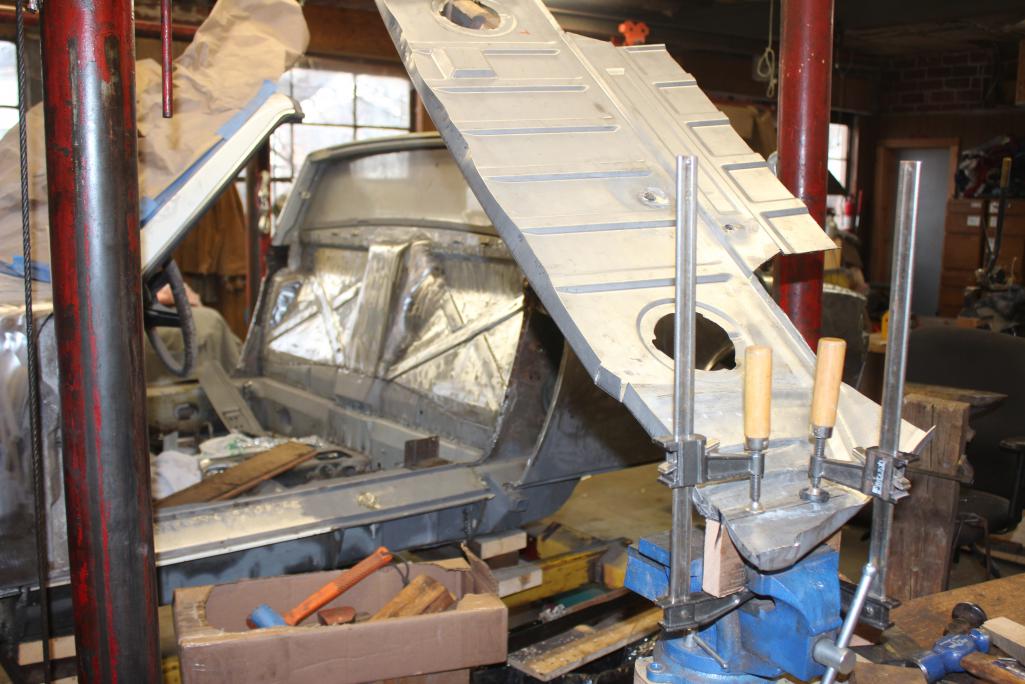
I want to get different parts against the anvil so I had to get a bit funkifized with the string.
Here is what it looks like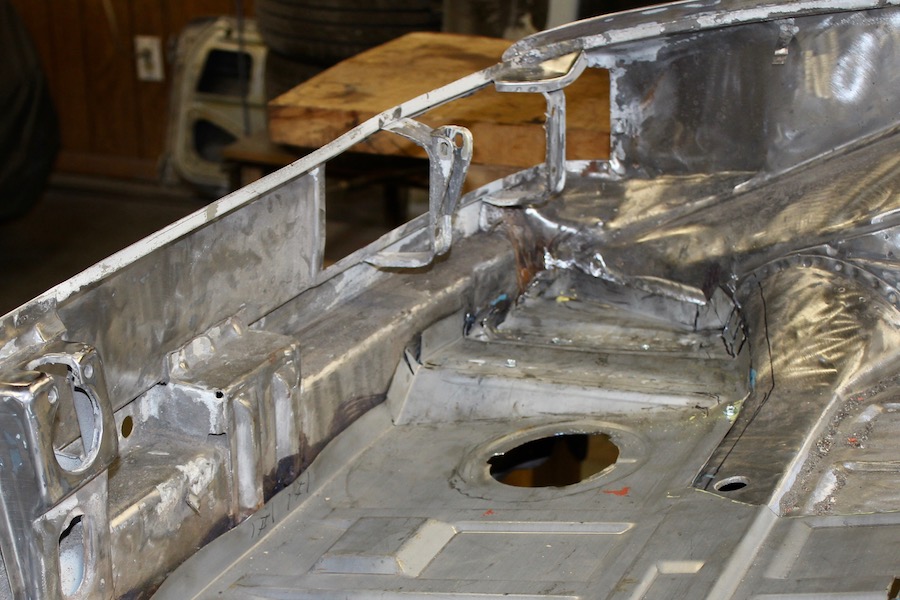
Posted by: worn May 23 2022, 10:05 AM
This is the trunk floor after some welding.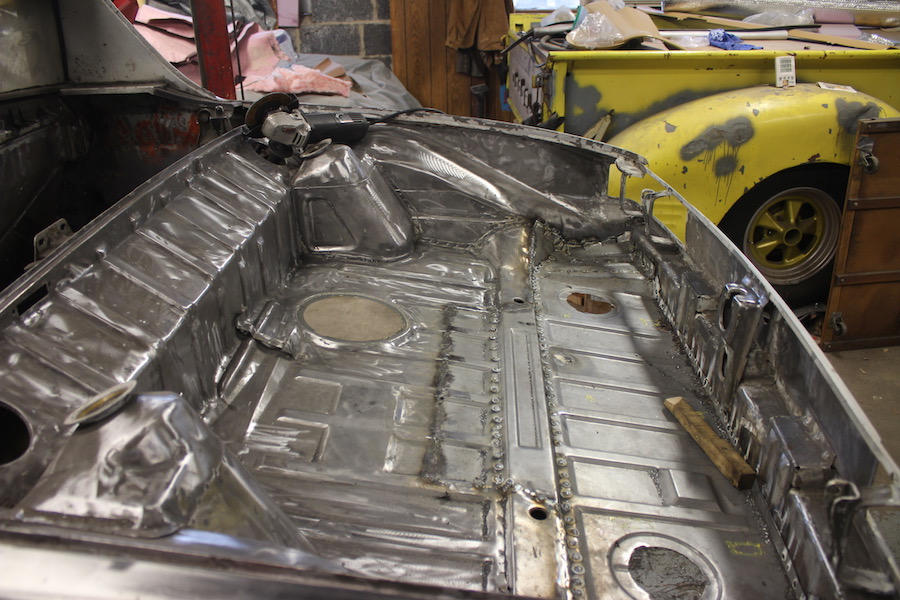
I made several patches out of material left over from trimming the trunk floor, but to use them I had to hammer the ribs flat. I got tired of that and also ran out of scraps so I bought some galvaneal sheet from online metals. Same stuff that Restoration Design uses. Here is the transmission mount reinforcement cut from my new sheet of steel.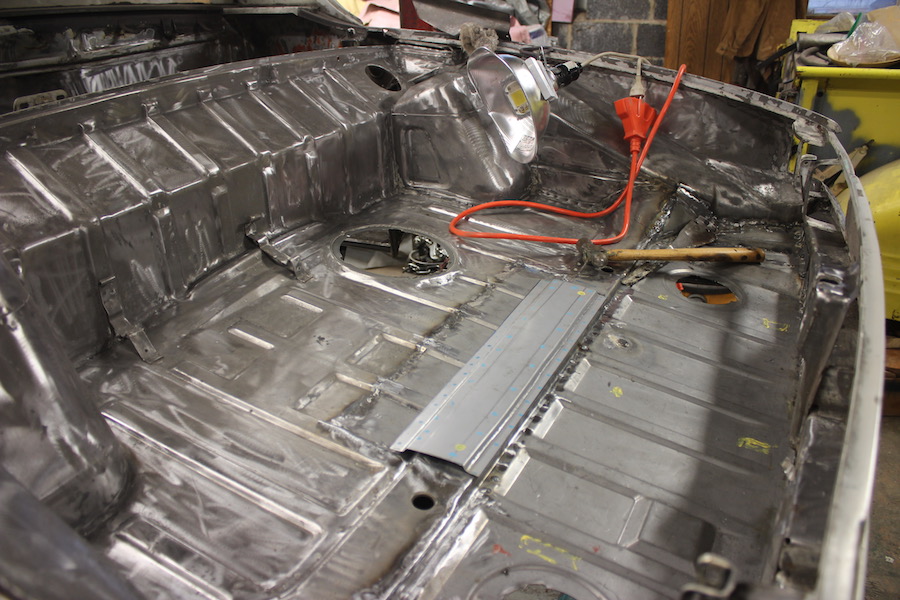
Posted by: worn May 23 2022, 10:07 AM
I found that rust often lurks behind the rubber seam sealer. So, you don't know until you take it all out.
Guess what these are.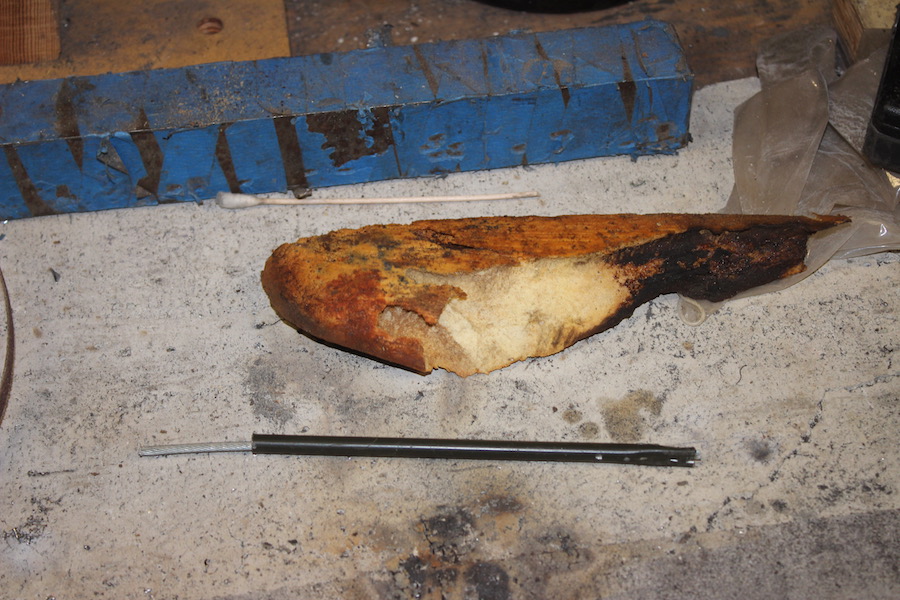
Posted by: 914werke May 23 2022, 10:23 AM
![]()
![]() Dedication
Dedication
Posted by: flyer86d May 23 2022, 02:20 PM
Wow! Nice work.
Charlie
Posted by: brant May 23 2022, 06:06 PM
Great job!!
Posted by: worn May 23 2022, 06:18 PM
Great job!!
Thanks folks! The piece of foam is from the very tip of the rear fender, just above the lights. I used a piece of cable and a piece of brake line to make a mini wire brush. In an electric drill you can spin it in either direction, winding or unwinding the cable. Crude, but gets into tight spots. I also discovered that the rubber sealer fears fire. A quick run with the torch and it softens. But it sure will make you dirty in a hurry! More to come.
Posted by: Dion May 24 2022, 07:39 AM
Wow, way to go Warren. That was a task. Well done.
Posted by: worn May 25 2022, 10:58 AM
Kept hitting my head while backing out of the engine bay. My solution.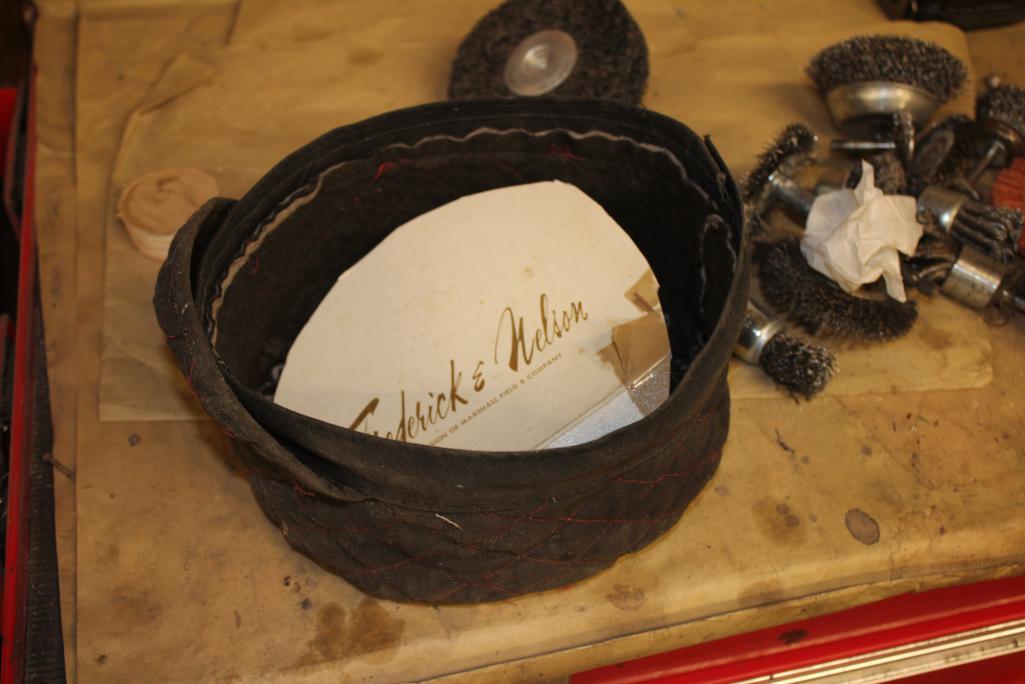
I finished up the rear with a couple patches where metal was in layers surrounded by failed sealant. My favorite was this one, which spans two pressings - the rear fender overlaps the piece that covers the rear of the trunk.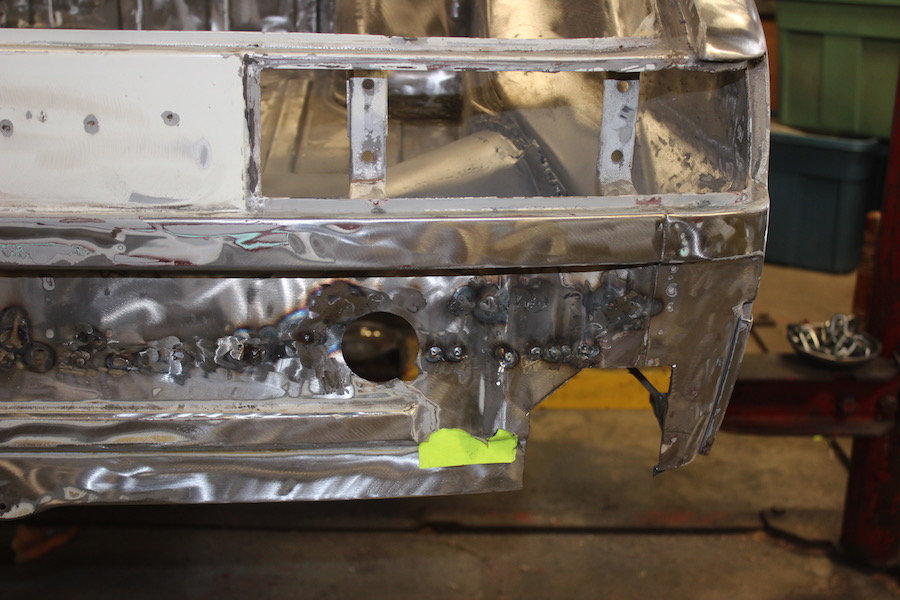
The two pieces were made separately and plug welded together before welding to the car. I flattened some of the left overs from the trunk floor piece and then reshaped. The seam is crooked, but I am not going to fix it.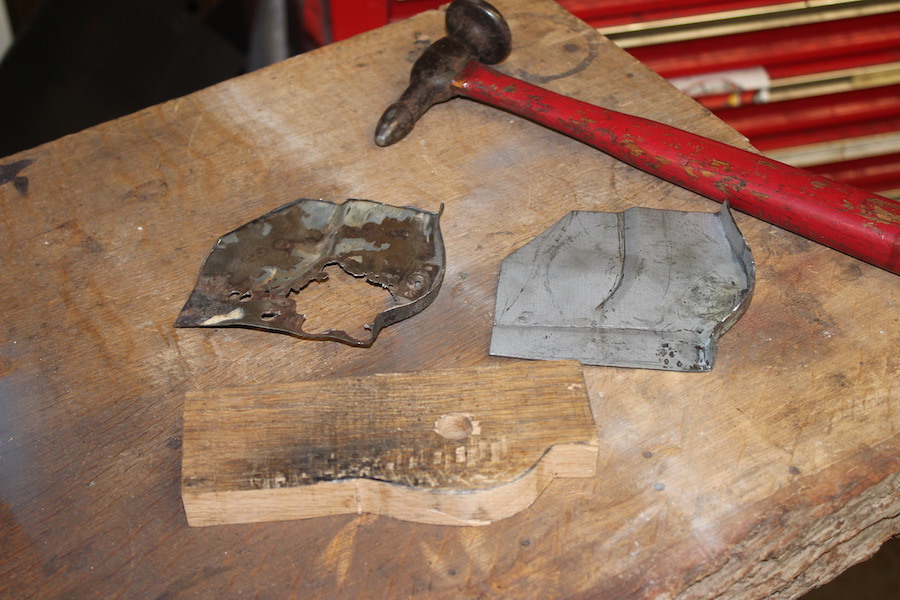
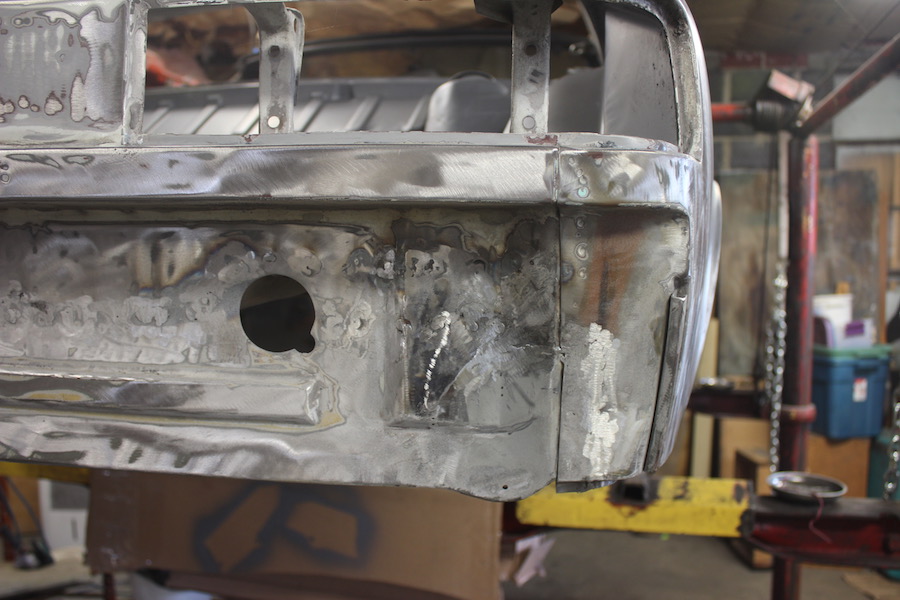
Posted by: worn May 25 2022, 11:04 AM
Another hole found. I had to buy the B-pillar pressings twice because I originally thought the rust didn't go all of the way to the top and fixed only the bottom. Had to carefully try to remove the plug welds, which is harder than drilling out spot welds.
This shows the new excavation with earlier fix still present.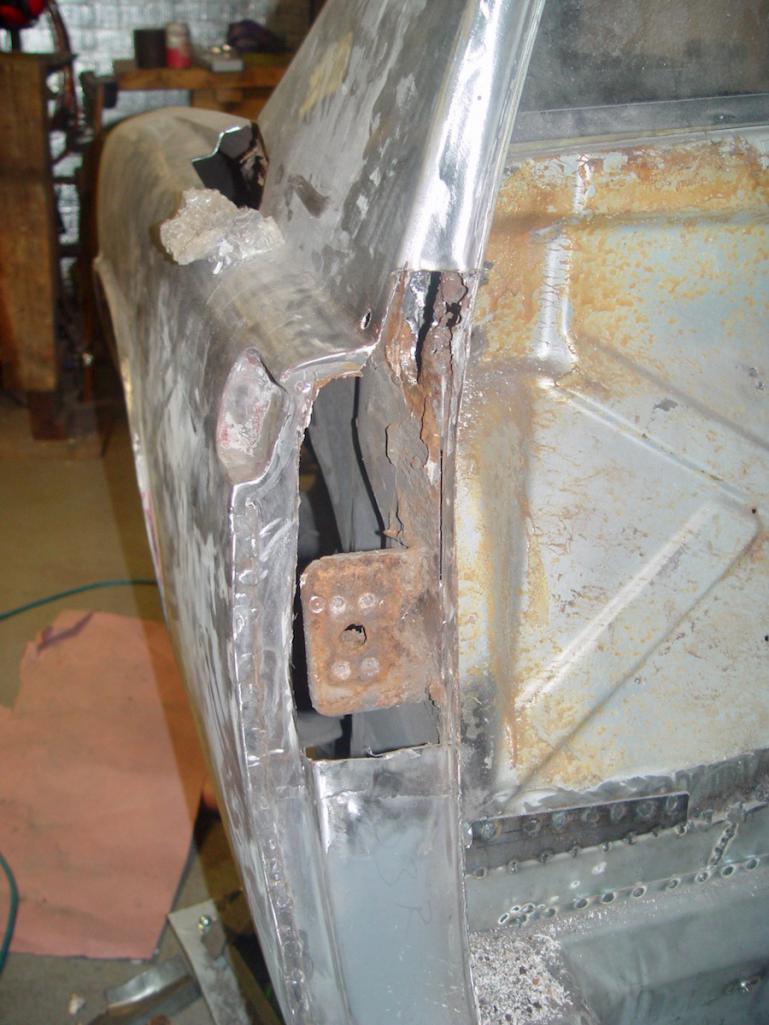
Posted by: worn May 25 2022, 11:17 AM
You can buy the B-pillar, but not the piece of the upper inner wheel housing. This goes from the engine bay all of the way through into the cabin. Again I hadn't bought my galvaneal sheet, so I flattened out a piece of trunk scrap.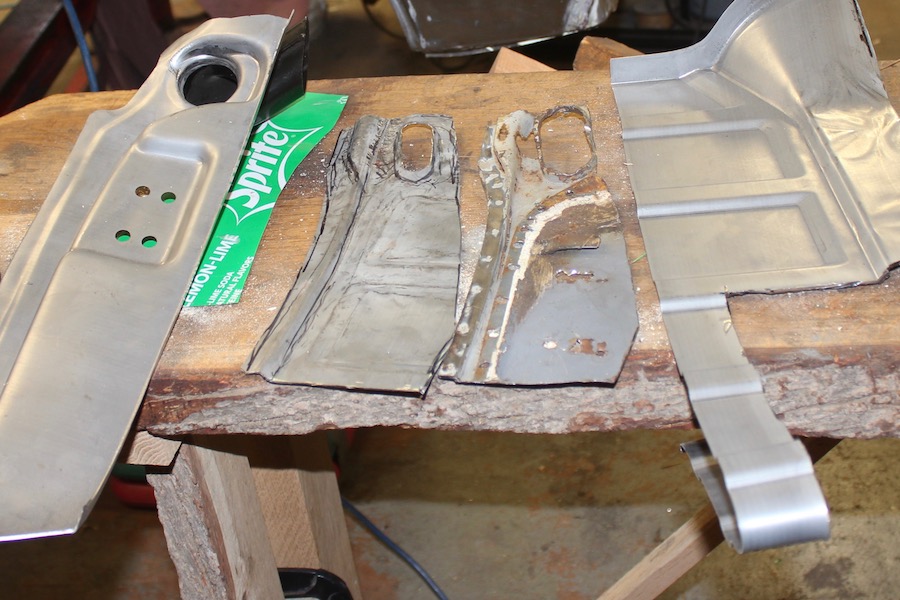
You can buy the tube that lets air move in and out of the cabin, but by the time I was done I had carved most of it away. The piece that holds the tube also holds the door latch plate.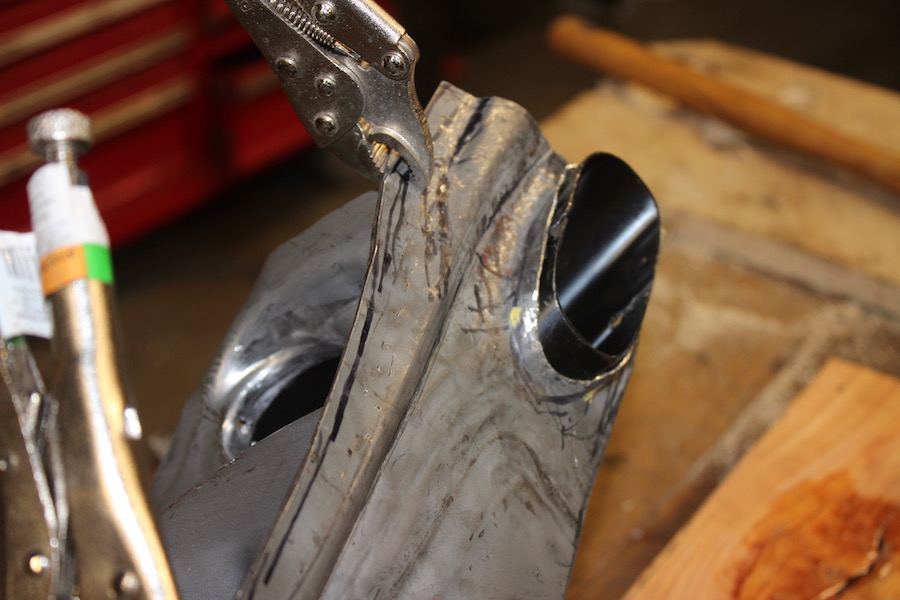
You can buy the piece that holds the door latch along with the nut plate. But, you can't buy the little box that houses the nut plate. I have seen some cars where the factory just used a strapp across the middle of the nut plate. This is a '76 and the box and nut plate were liberally covered in sealer...thus the need for repair ![]()
I used silver bearing brazing rod to attach the tube, but epoxy wold probably be just as good.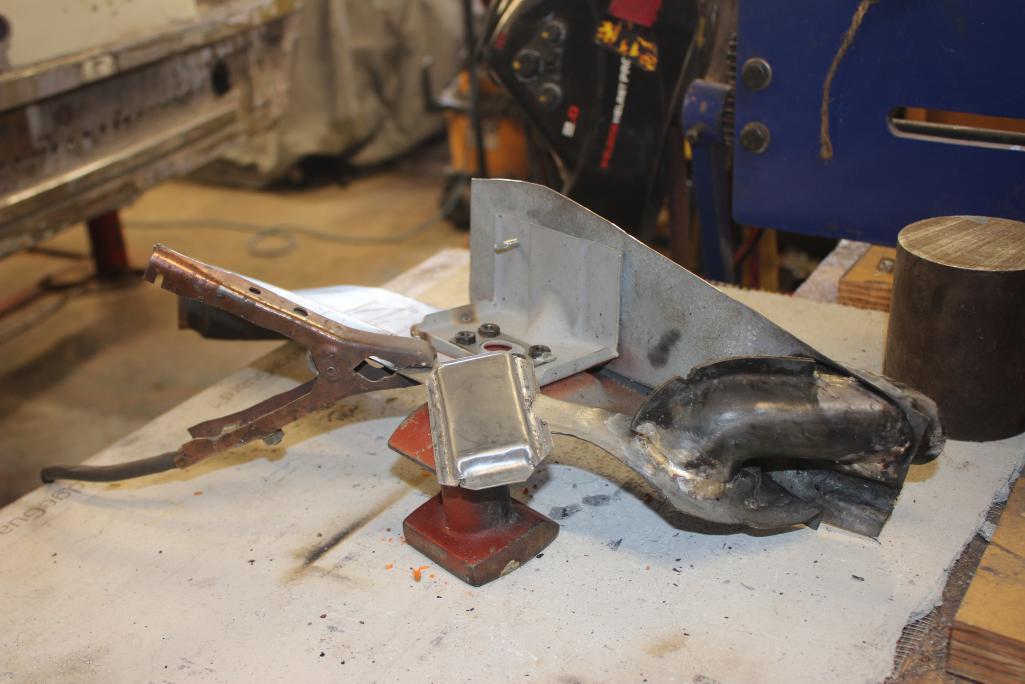
Posted by: worn May 25 2022, 11:26 AM
Into the big hole.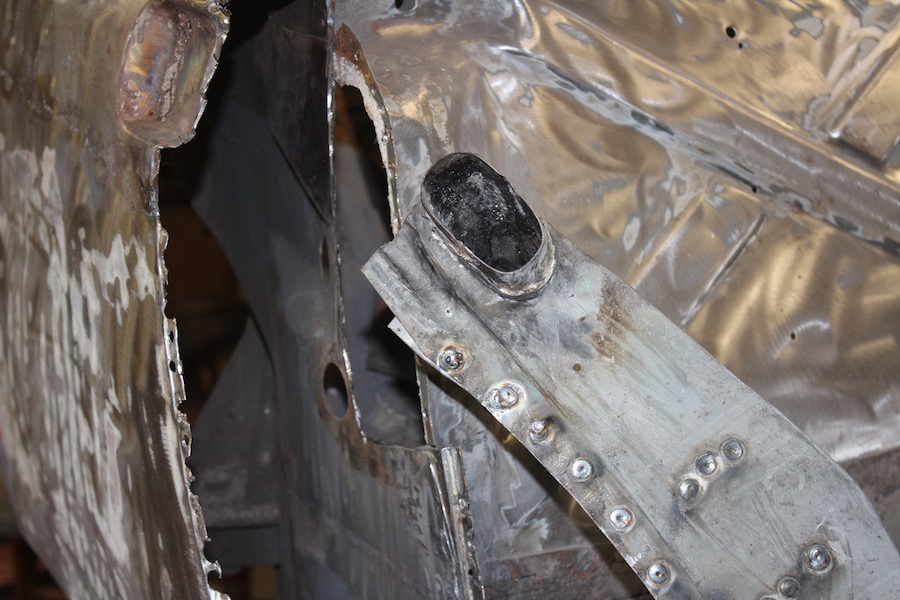
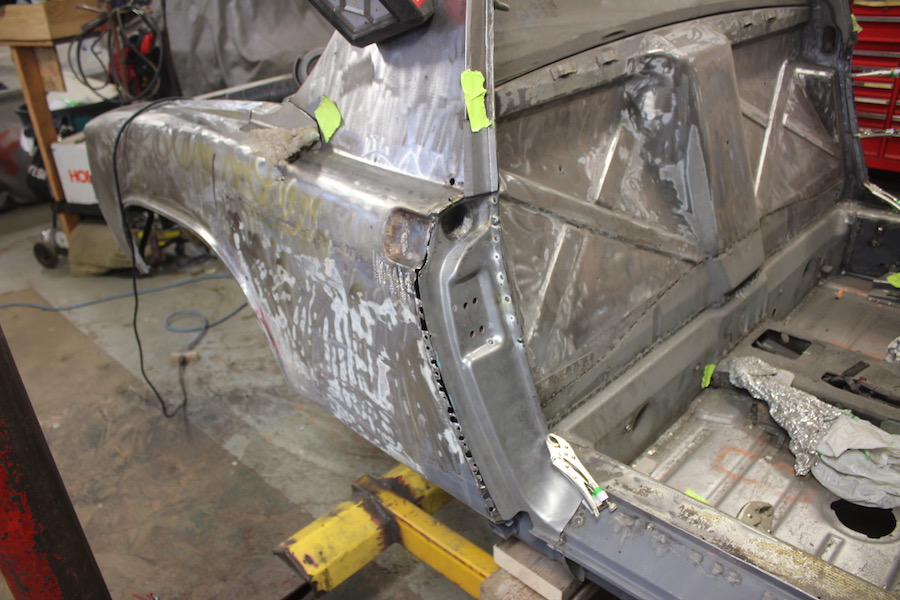
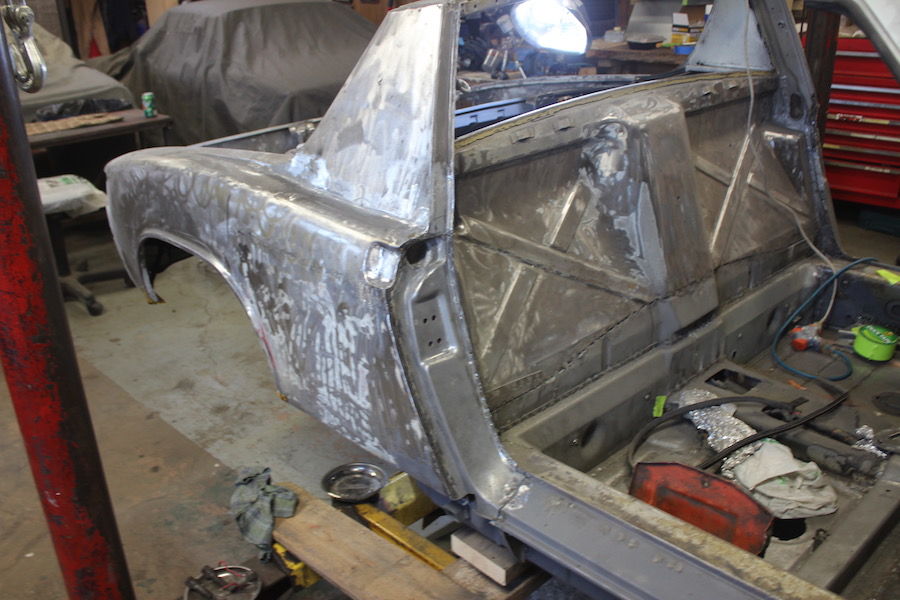
Not shown is the welding the patch inside where it meets that inner fender piece.
Posted by: worn May 25 2022, 11:34 AM
Why should the driver's side be any different?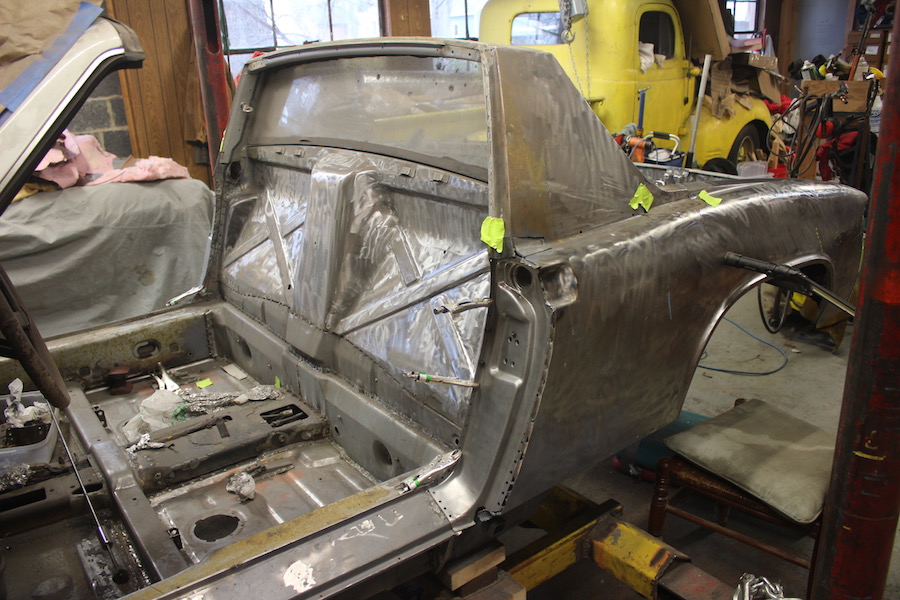
Posted by: worn May 26 2022, 09:47 AM
The sail rusted where failed sealer met overlapping metal and rain and road spray. Same on both sides. Patched.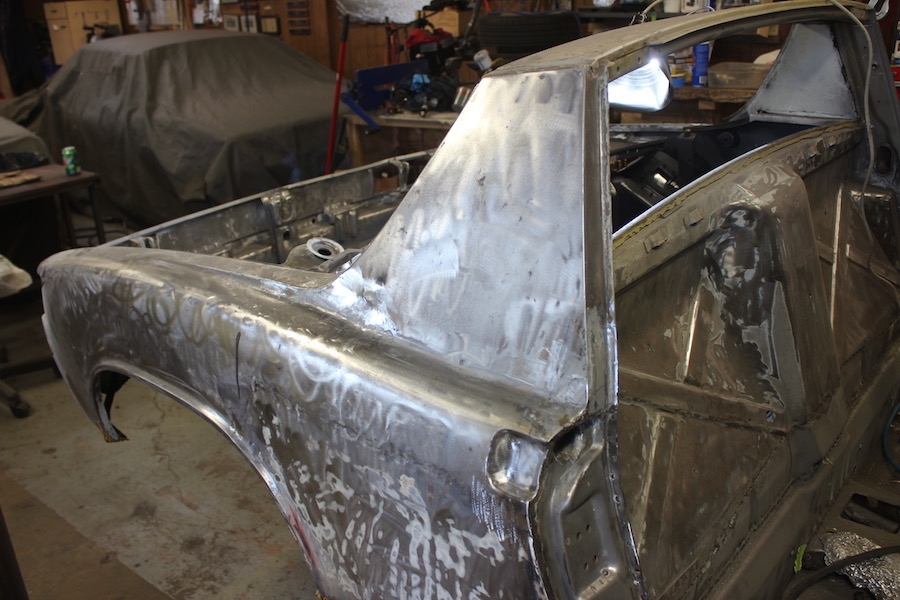
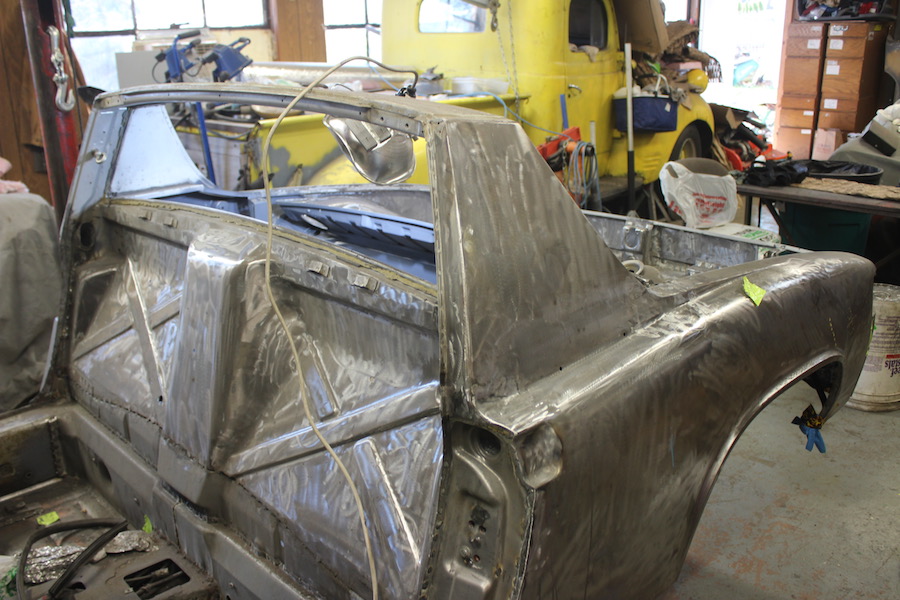
Posted by: worn May 26 2022, 09:52 AM
Got most of the grime out of the front wheel wells, along with the sealer. The rubber sealer fears fire and a propane torch helps. With suitable caution.
At the bow I will be replacing the trunk floor to get rid of the former AC hack. And under the turn signals rust again. Not sure, but this may be the last of the wwelding. Or not.
Left outside.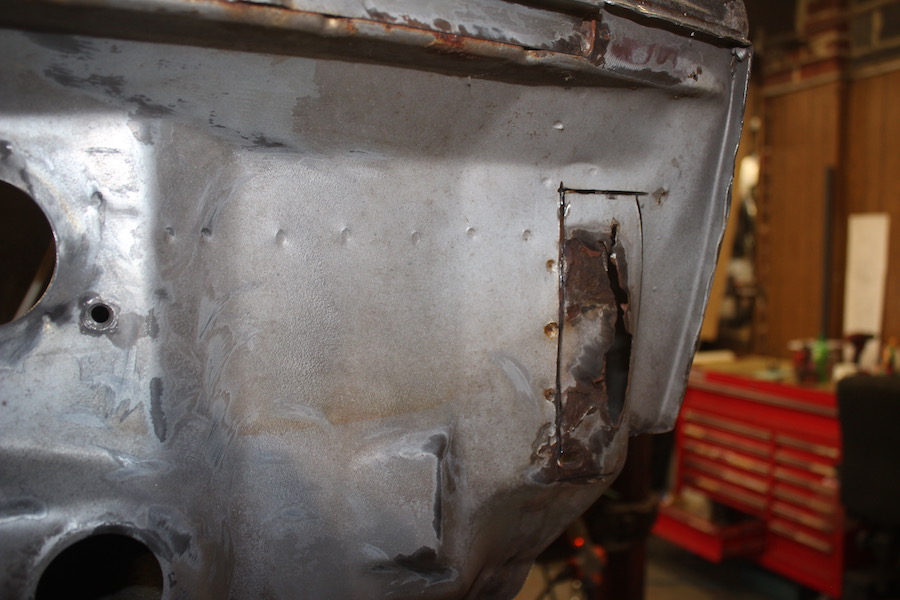
inside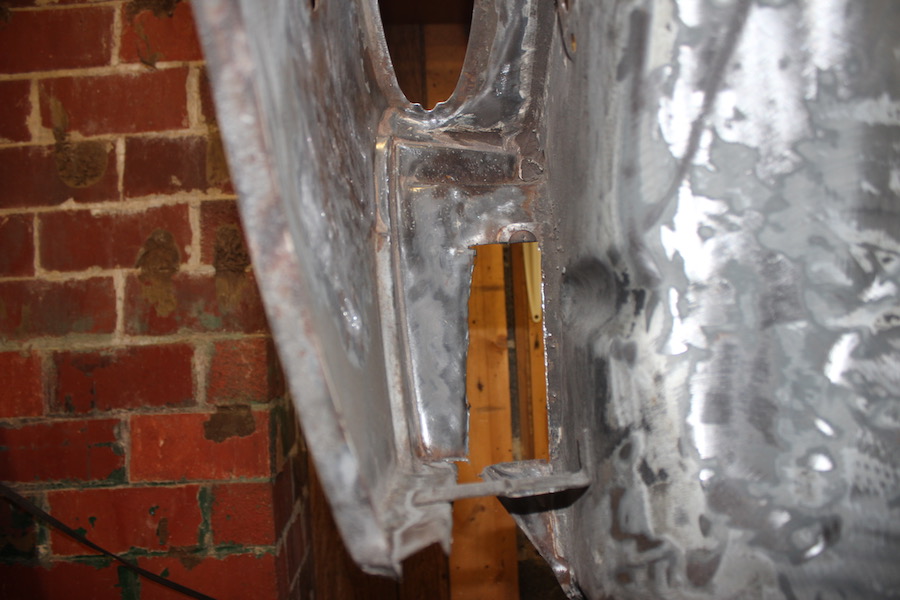
Right side.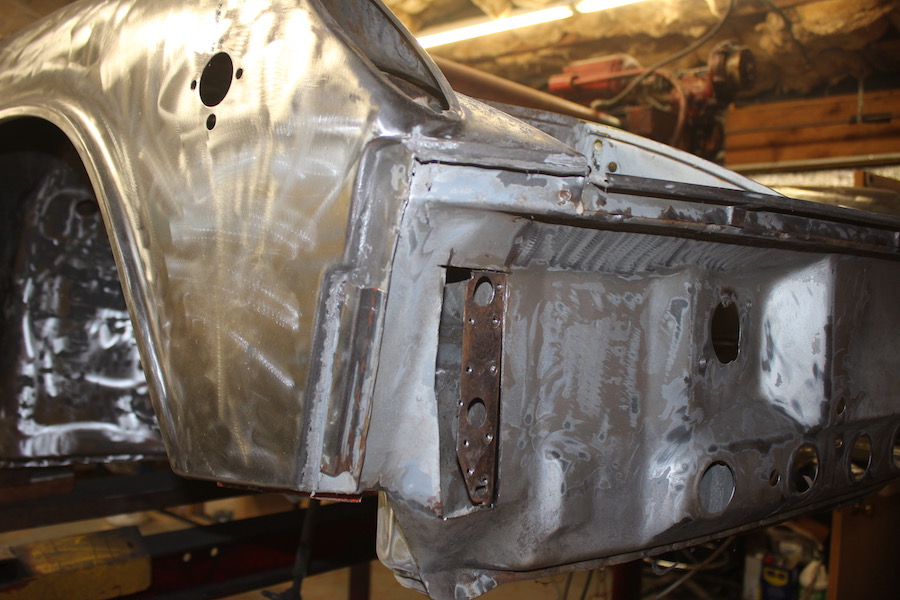
Posted by: worn Jun 2 2022, 06:45 PM
I still have some welding to do up in the bow, but summer is here and so is humid air. I have to protect bare metal. I have two questions.
1
I love PPG DP40. I will be putting it on and then working with some small amount of body filler. Then another layer of epoxy. There are places where rust lurks untouchable. Between layers of metal, or in isolated pits. I don’t want to make the good metal into thin foil just to sand out a couple of pits. But, what to do? I have three products that use acids to turn the ferric iron to black ferrous form. This is more stable.
I can use them and cover with epoxy. Or, I can just trap the rust away from water and o two with the primer. For those who use epoxy primer, what is your practice?
Number the two.
I was thinking of covering the wheel wells and underside with Raptor bed liner. Ever notice how antagonistic the names for truck products are? Seems like a good idea, but I saw someone post saying that this is used to hide sins of the DAPO, me in this case. Big deal? Anything better?
Thanks!
Posted by: 76-914 Jun 2 2022, 08:53 PM
I still have some welding to do up in the bow, but summer is here and so is humid air. I have to protect bare metal. I have two questions.
1
I love PPG DP40. I will be putting it on and then working with some small amount of body filler. Then another layer of epoxy. There are places where rust lurks untouchable. Between layers of metal, or in isolated pits. I don’t want to make the good metal into thin foil just to sand out a couple of pits. But, what to do? I have three products that use acids to turn the ferric iron to black ferrous form. This is more stable.
I can use them and cover with epoxy. Or, I can just trap the rust away from water and o two with the primer. For those who use epoxy primer, what is your practice?
Number the two.
I was thinking of covering the wheel wells and underside with Raptor bed liner. Ever notice how antagonistic the names for truck products are? Seems like a good idea, but I saw someone post saying that this is used to hide sins of the DAPO, me in this case. Big deal? Anything better?
Thanks!
Hey Warren, 1st good work my man; 2nd, If your not in a hurry to spray those wheel wells I have a gallon of bed liner I can give you at the RRC but you'd need to source a pint of activator. I traded a flux core unit to a friend a few years back for 2 gallons of bed liner and one pint of activator. It's just been sitting around so LMK if you want it.
Posted by: worn Jun 3 2022, 08:16 AM
I still have some welding to do up in the bow, but summer is here and so is humid air. I have to protect bare metal. I have two questions.
1
I love PPG DP40. I will be putting it on and then working with some small amount of body filler. Then another layer of epoxy. There are places where rust lurks untouchable. Between layers of metal, or in isolated pits. I don’t want to make the good metal into thin foil just to sand out a couple of pits. But, what to do? I have three products that use acids to turn the ferric iron to black ferrous form. This is more stable.
I can use them and cover with epoxy. Or, I can just trap the rust away from water and o two with the primer. For those who use epoxy primer, what is your practice?
Number the two.
I was thinking of covering the wheel wells and underside with Raptor bed liner. Ever notice how antagonistic the names for truck products are? Seems like a good idea, but I saw someone post saying that this is used to hide sins of the DAPO, me in this case. Big deal? Anything better?
Thanks!
Hey Warren, 1st good work my man; 2nd, If your not in a hurry to spray those wheel wells I have a gallon of bed liner I can give you at the RRC but you'd need to source a pint of activator. I traded a flux core unit to a friend a few years back for 2 gallons of bed liner and one pint of activator. It's just been sitting around so LMK if you want it.
Thank you!
A gallon? What color? I have to consider if I may. I am almost at the point where after two years of very slow cleaning and patching the project might actually move along. But I have to pull the plug on it for awhile to get ready for the trip.
Any advice beyond that?
Posted by: 76-914 Jun 4 2022, 08:01 PM
I still have some welding to do up in the bow, but summer is here and so is humid air. I have to protect bare metal. I have two questions.
1
I love PPG DP40. I will be putting it on and then working with some small amount of body filler. Then another layer of epoxy. There are places where rust lurks untouchable. Between layers of metal, or in isolated pits. I don’t want to make the good metal into thin foil just to sand out a couple of pits. But, what to do? I have three products that use acids to turn the ferric iron to black ferrous form. This is more stable.
I can use them and cover with epoxy. Or, I can just trap the rust away from water and o two with the primer. For those who use epoxy primer, what is your practice?
Number the two.
I was thinking of covering the wheel wells and underside with Raptor bed liner. Ever notice how antagonistic the names for truck products are? Seems like a good idea, but I saw someone post saying that this is used to hide sins of the DAPO, me in this case. Big deal? Anything better?
Thanks!
Hey Warren, 1st good work my man; 2nd, If your not in a hurry to spray those wheel wells I have a gallon of bed liner I can give you at the RRC but you'd need to source a pint of activator. I traded a flux core unit to a friend a few years back for 2 gallons of bed liner and one pint of activator. It's just been sitting around so LMK if you want it.
Thank you!
A gallon? What color? I have to consider if I may. I am almost at the point where after two years of very slow cleaning and patching the project might actually move along. But I have to pull the plug on it for awhile to get ready for the trip.
Any advice beyond that?
It's black Warren. I used a gallon when I converted to water cooled. Shot it everywhere water might get if I developed a leak.
Posted by: worn Jun 25 2022, 10:09 AM
Throughout this project I have found two tools really helpful
The first is a tube with a clutch cable piece sticking out. It looks like this and 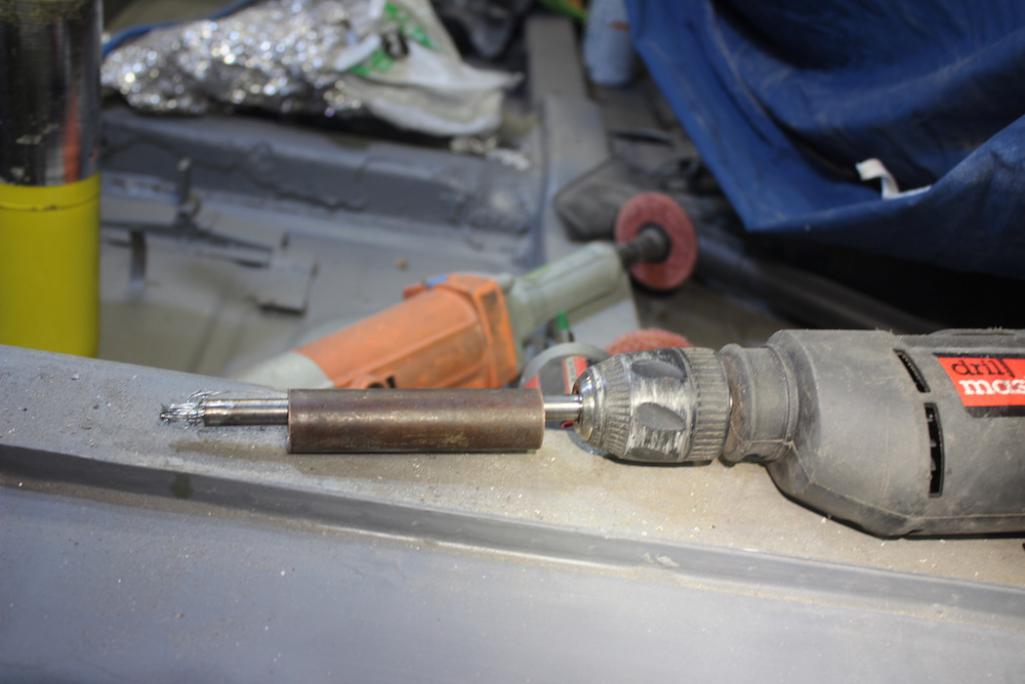
gets into places like this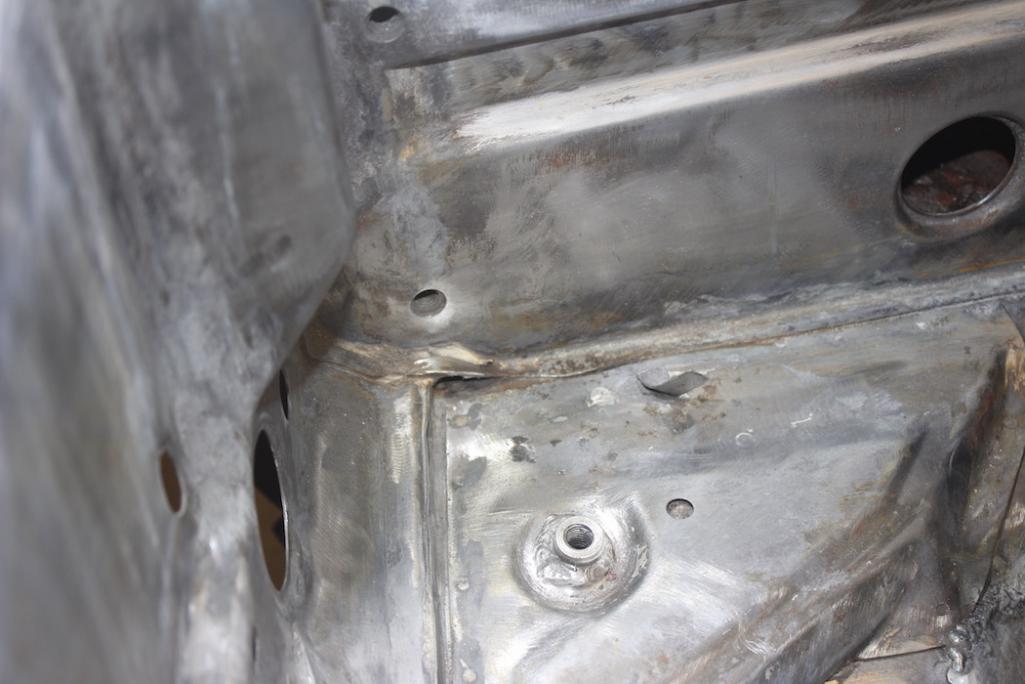
I use the piece of copper pipe as a bearing to guide and push the brush along. The number of holes like this is amazing. That is to say there are a lot of them.
Another tool I am fast wearing out is this from Milwaukee. I am not touting the brand but they are the only ones selling something like this. Far more torque than my (cheap) air grinders. I have a dozen air die grinders so that I can choose a bit or sanding disc quickly by just grabbing a different die grinder. The battery powered tools are a bit too pricey for that but Roloc type discs help. You need a lot of batteries if you want to keep at it steady, and the chip will tell you no when the tool heats up.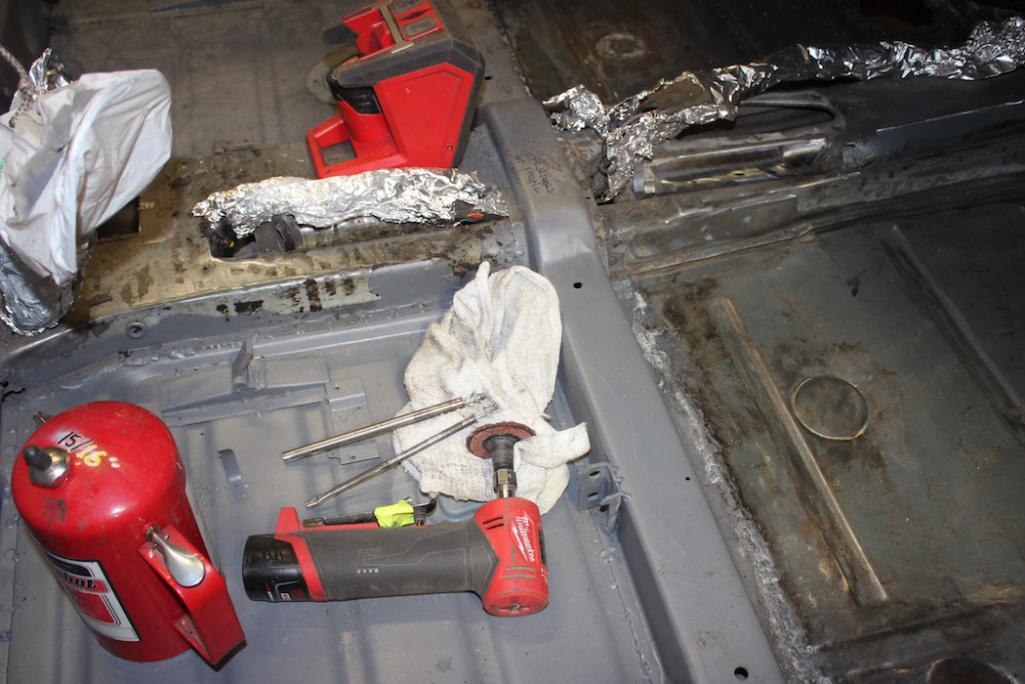
Posted by: worn Jun 25 2022, 10:21 AM
A curious thing about the car is the absence of front jack points. Same on both sides of the floor. Absolutely no sign that the floor was ever molested other than the frunk floor for AC. No signs of welding on either side with bare metal showing inside or out.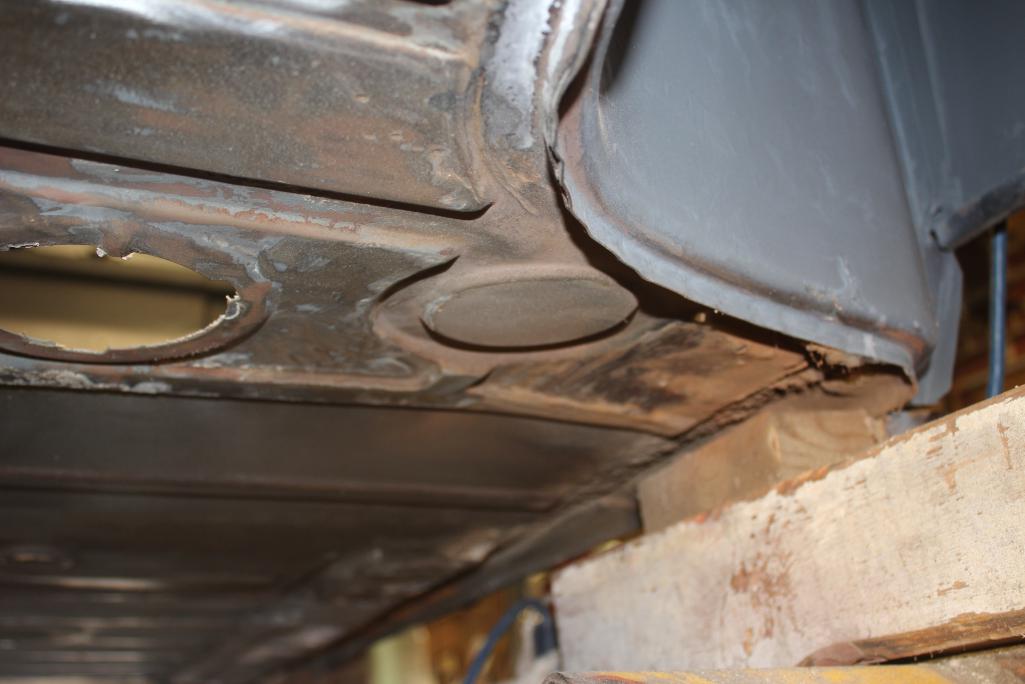
This is one of the last 914s ever built. Did the factory just run short of doughnuts that day?
Posted by: worn Jun 25 2022, 11:01 AM
Here is another shot...ad nauseum I suppose. It shows what you do when the wires wear down. Just use a cutter to remove some of the tube.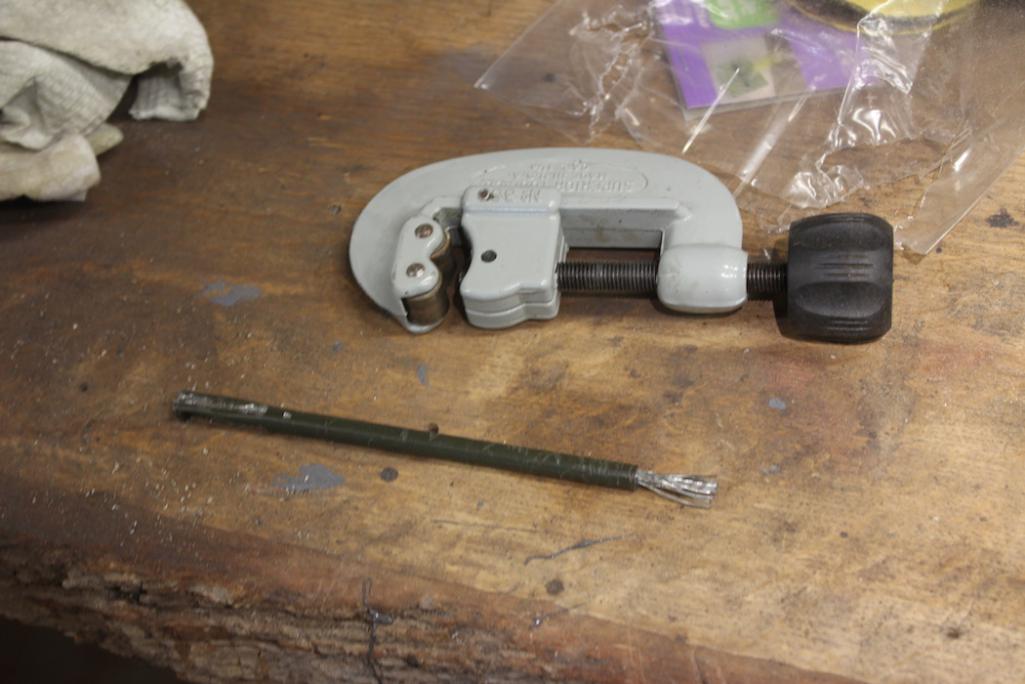
And here is yet another place to use one. As you can see I have moved ahead into the bow.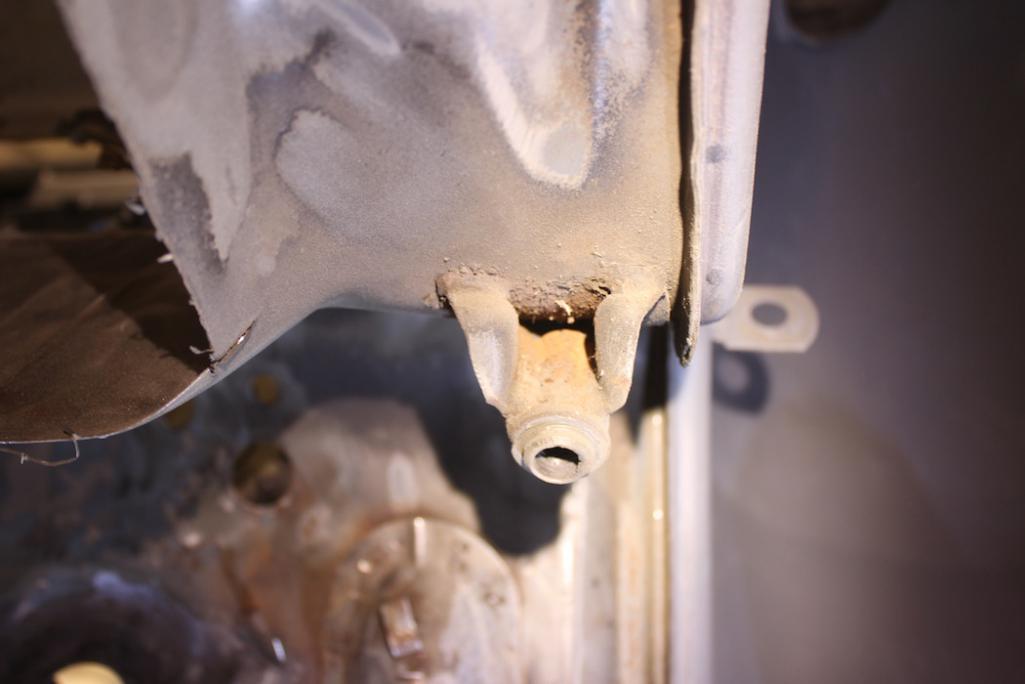
Posted by: worn Jun 25 2022, 11:08 AM
Waited to replace the frunk floor so I could crawl through the hole to clean and sand as needed. Time to finish that part with a new trunk floor patch that RD sells for replacing the AC modified floor.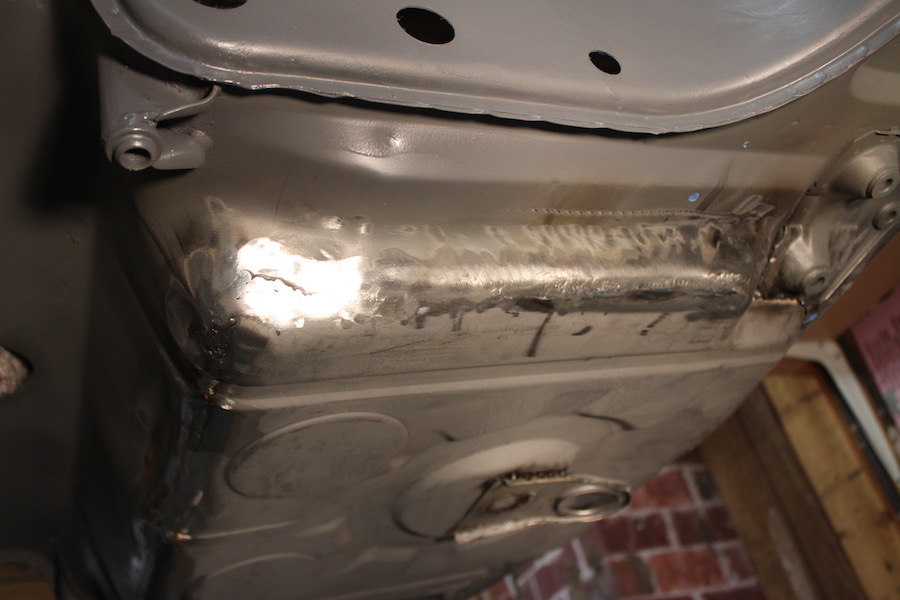
Still have to finish patching the holes at the very front. I hope that I am on the last spool of wire and the last tank of Ar/CO2.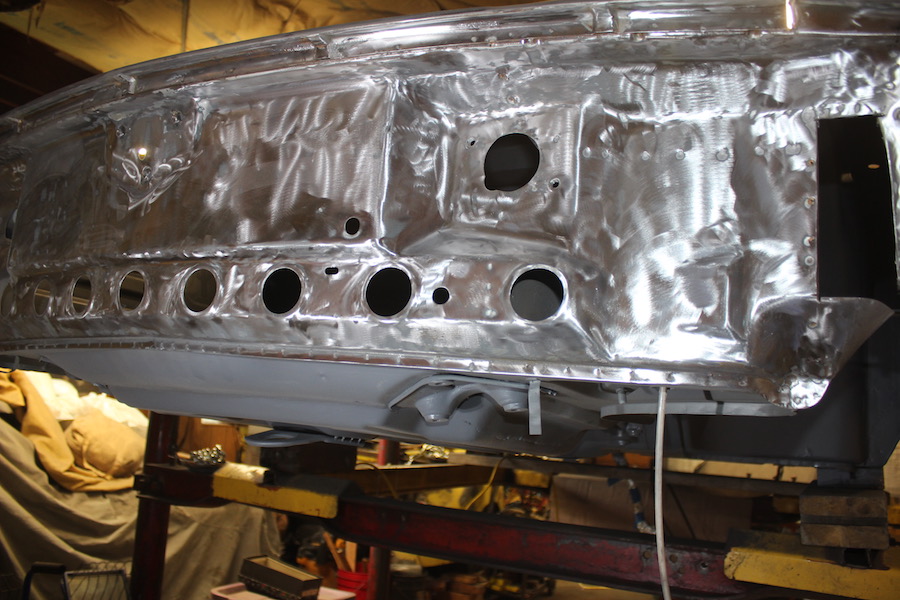
Posted by: SirAndy Jun 25 2022, 11:51 AM
This is one of the last 914s ever built. Did the factory just run short of doughnuts that day?
General consensus is that those donuts aren't jack points but were used to hold the chassis in place on the conveyor belts at the factory.
If you look at the backside of that area, there is no support what-so-ever to handle the full weight of the car. You will see the floor pan buckled up there on a *lot* of 914s.
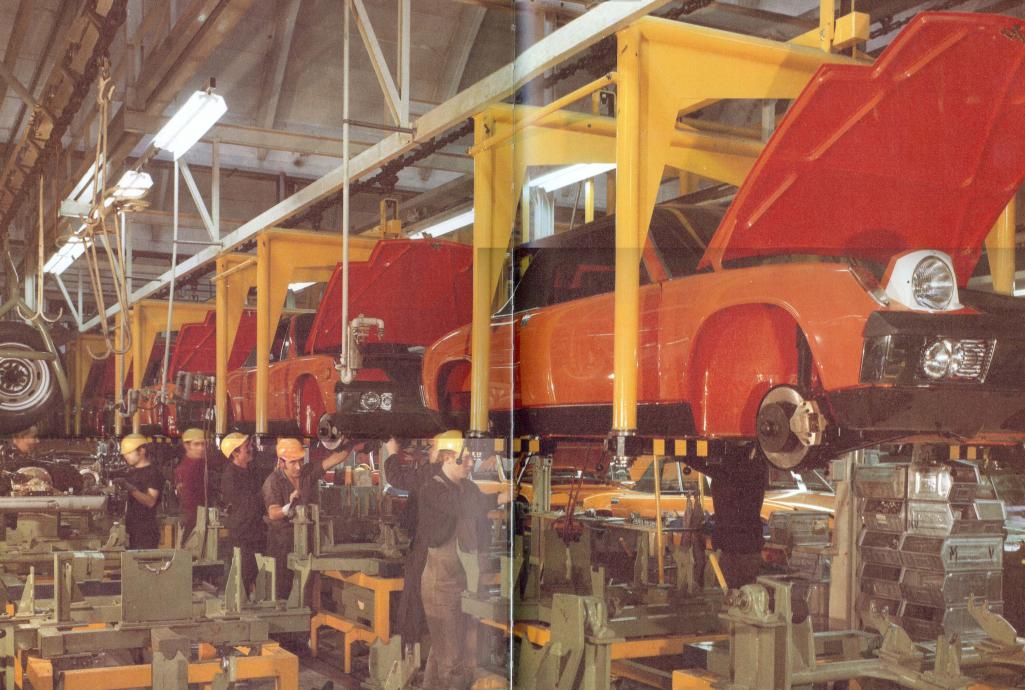
Posted by: worn Jun 25 2022, 03:20 PM
That sounds pretty much like I thought but used the word because it is so often used and understood. Floors bent up in front and in places where they weren't even trying to find a good spot. I am still interested in why my car came without them. I find it very hard to believe that they were there, taken off and the metal cleaned up perfectly smooth even under all the sound deadening and sealer.
Posted by: 930cabman Jun 26 2022, 07:26 AM
A curious thing about the car is the absence of front jack points. Same on both sides of the floor. Absolutely no sign that the floor was ever molested other than the frunk floor for AC. No signs of welding on either side with bare metal showing inside or out.

This is one of the last 914s ever built. Did the factory just run short of doughnuts that day?
Either that or Franz knew it was the end of the line and said " you know what" in German
Great looking repair work
Posted by: worn Jun 26 2022, 08:41 AM
Those guys new style when they saw it. I find it interesting that all of that tooling is stuffed underneath where they were working. No where else to store it? Also, is this what the Brits refer to as soft tooling?
Posted by: worn Jun 26 2022, 08:44 AM
Those guys new style when they saw it. I find it interesting that all of that tooling is stuffed underneath where they were working. No where else to store it? Also, is this what the Brits refer to as soft tooling?
I think on second thought i should be calling them fixtures. But i don’t see any subassemblies loaded in them.
Posted by: 914fahrer Jun 26 2022, 09:28 AM
Did you really look at the correct place ?Here is a factory doughnut.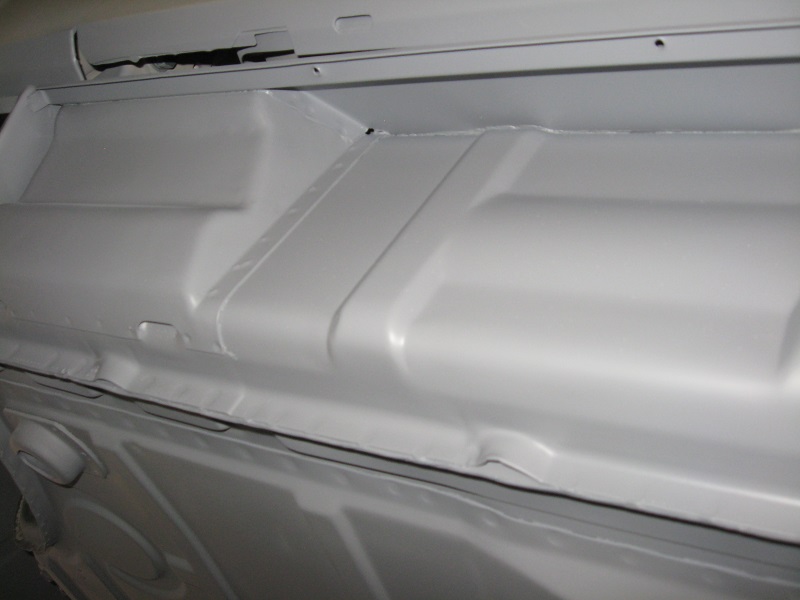
Posted by: worn Jun 27 2022, 08:35 AM
Did you really look at the correct place ?Here is a factory doughnut.

That is the spot I am showing naked of doughnut. My picture was from the front. I have taken the plug out of the larger hole and the one closest to the side of the car is shown.
I have the '72 I can compare with just to be sure.
Posted by: 930cabman Jun 27 2022, 06:07 PM
Throughout this project I have found two tools really helpful
The first is a tube with a clutch cable piece sticking out. It looks like this and

gets into places like this

I use the piece of copper pipe as a bearing to guide and push the brush along. The number of holes like this is amazing. That is to say there are a lot of them.
Another tool I am fast wearing out is this from Milwaukee. I am not touting the brand but they are the only ones selling something like this. Far more torque than my (cheap) air grinders. I have a dozen air die grinders so that I can choose a bit or sanding disc quickly by just grabbing a different die grinder. The battery powered tools are a bit too pricey for that but Roloc type discs help. You need a lot of batteries if you want to keep at it steady, and the chip will tell you no when the tool heats up.

Your Milwakee cordless grinder looks cool, I have done a bit of poking around and am unable to find it. Could you reply with a model #
thanks and your build looks great
Powered by Invision Power Board (http://www.invisionboard.com)
© Invision Power Services (http://www.invisionpower.com)
